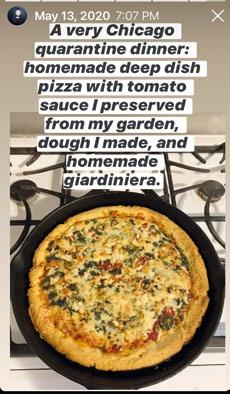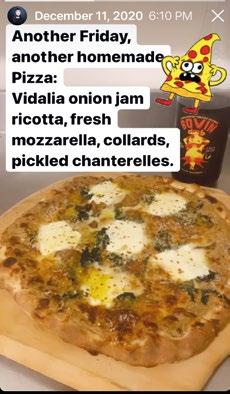If there wasn’t a serial killer who picked off dozens of victims without detection for decades, then the city was broken in a way that gave off the illusion of one.
By BEN AUSTEN | 12


If there wasn’t a serial killer who picked off dozens of victims without detection for decades, then the city was broken in a way that gave off the illusion of one.
By BEN AUSTEN | 12

10 Isaacs | Culture New Obama Center ETA: 2025
12 Crime If there wasn’t a serial killer who picked off victims without detection for decades, then the city was broken in a way that gave off the illusion of one.
43 Gossip Wolf Jessica Risker combines her two loves with the podcast Music Therapy, shoegaze band Diagonal release a spacey new album, and footwork crew the Era drop a dreamy rap single.
04 Shop Local Kit offers professional quality bar tools and local expertise.

18 Profile Author and organizer Mariame Kaba provides the next generation of changemakers with lessons on abolition and organizing in her new book.
20 Comics A history of John Porcellino’s midwest influence
31 Festival What we loved at Sundance 2021 . . . from our couch
33 Movies of note Minari is a beautiful and complex immigrant story; Nomadland is a somber and heartfelt neo-western drama; and Saint Maud is an eerie and unpredictable horror film.
44 Chicagoans of Note Beth King, staffer at Intonation Music
@CHICAGOREADER.COM
PUBLISHER AND PRESIDENT TRACY BAIM PUBLISHER AND EDITOR IN CHIEF KAREN HAWKINS EDITOR IN CHIEF SUJAY KUMAR
PRODUCTION MANAGER KIRK WILLIAMSON GRAPHIC DESIGNER AMBER HUFF MUSIC EDITOR PHILIP MONTORO
THEATER AND DANCE EDITOR KERRY REID CULTURE EDITOR BRIANNA WELLEN ASSOCIATE EDITOR JAMIE LUDWIG SENIOR WRITERS MAYA DUKMASOVA, LEOR GALIL, DEANNA ISAACS, BEN JORAVSKY, MIKE SULA EDITORIAL ASSOCIATE S. NICOLE LANE LISTINGS COORDINATOR SALEM COLLO-JULIN SOCIAL JUSTICE REPORTING FELLOW ADAM M. RHODES
DIRECTOR OF DIGITAL JOHN DUNLEVY SOCIAL MEDIA COORDINATOR JANAYA GREENE STAFF AND SPECIAL PROJECTS ASSISTANT TARYN ALLEN
STRATEGIC INNOVATION DIRECTOR MARIAH NEUROTH
DEVELOPMENT DIRECTOR COLETTE WILLARD MEDIA PARTNERSHIPS COORDINATOR YAZMIN DOMINGUEZ
06 Sula | Feature El Internacional, Cafe Ba-Ba-Reeba!, and bacalao at the dawn of small plates America

NEWS & POLITICS
08 Joravsky | Politics C’mon, Democratic activists, don’t be so naïve when dealing with Republicans.
24 Survival Steps Almost a year into the shutdown, Chicago artists are still thinking on their feet.
26 Micro Performance Theatre for One aims for catharsis, one person at a time.

35 Feature The pandemic separated the members of emo trio Hospital Bracelet almost a year before their thrilling debut album made a splash in the scene.
38 Records of Note A pandemic can’t stop the music, and this week the Reader reviews current releases by the Notwist, Waltzer, John Carpenter, Englewood B.U., Roscoe Mitchell & Mike Reed, and more.
43 Early Warnings Rescheduled concerts and other updated listings
48 Savage Love Dan Savage offers advice on guilt trips, glory holes, and being there for those you love.
49 Jobs
49 Apartments & Spaces
49 Marketplace
Karen Lewis knew you don’t make a lot of friends in high places when you stand up for teachers and poor kids.

From a call center in India to video chat, Parvesh Cheena has starred in television shows that have defined an era.
Judas and the Black Messiah examines the need for revolutionaries when pushing for real change.


EXECUTIVE ASSISTANT SANDRA L. KLEIN MEDIA PARTNERSHIPS AND DEVELOPMENT ADVISOR ABHIMANYU CHANDRA
SPECIAL EVENTS CONSULTANT KRISTEN KAZA
ADVERTISING
312-392-2970, ADS@CHICAGOREADER.COM
CLASSIFIEDS: CLASSIFIED-ADS@CHICAGOREADER.COM
VICE PRESIDENT OF SALES AMY MATHENY SALES DIRECTOR AMBER NETTLES SENIOR ACCOUNT REPRESENTATIVES LENI MANAA-HOPPENWORTH, TED PIEKARZ, LISA SOLOMON
CLASSIFIED SALES MANAGER WILL ROGERS
NATIONAL ADVERTISING
VOICE MEDIA GROUP 1-888-278-9866 VMGADVERTISING.COM
JOE LARKIN AND SUE BELAIR
DISTRIBUTION CONCERNS distributionissues@chicagoreader.com
312-392-2970
CHICAGO READER L3C

BOARD PRESIDENT DOROTHY R. LEAVELL
TREASURER EILEEN RHODES
AT-LARGE SLADJANA VUCKOVIC
READER INSTITUTE FOR COMMUNITY JOURNALISM, INC.
CHAIRWOMAN EILEEN RHODES

TREASURER CAROL BELL
DIRECTORS ALISON CUDDY, VANESSA FERNANDEZ, KIM L. HUNT, JACKIE KAPLAN-PERKINS, DOROTHY R. LEAVELL, SLADJANA VUCKOVIC
READER (ISSN 1096-6919) IS PUBLISHED BIWEEKLY BY CHICAGO READER L3C 2930 S. MICHIGAN, SUITE 102 CHICAGO, IL 60616 312-392-2934, CHICAGOREADER.COM
COPYRIGHT © 2021 CHICAGO READER PERIODICAL POSTAGE PAID AT CHICAGO, IL
ALL RIGHTS RESERVED. CHICAGO READER, READER, AND REVERSED R: REGISTERED TRADEMARKS ®
store opened with the most basic items for a starter bar: jigger, shakers, strainers, and mixing glasses. From there they’ve slowly expanded to include a wider range of tools and styles of the basics, as well as bitters, syrups, recipe books, aprons, and more.

Lindsey has worked in the restaurant industry, but she comes from a theater and corporate background. After nearly 20 years working as a stage manager for storefront theaters in the city, she decided to step away from that world to go into business with her sister. Based on their history, it was a no-brainer. “We’re constantly around each other and always have been, so we’re very good at understanding each other’s personalities,” Lindsey says. Rachel agrees, adding, “We have really clear-cut strengths and weaknesses.”
Also familiar is the neighborhood where they chose to open up shop—the twins grew up in Irving Park and for the last eight years Rachel’s been behind the bar at Community Tavern, which is only a two-minute walk from Kit. When the store opened on November 28, 2020 (also Small Business Saturday), it was
clear that the support from the neighborhood would be paramount in keeping the business running through the pandemic and beyond.
In the future the Millers hope they can expand the use of the space, pivoting back to serving professional bartenders in the city and eventually using it as a non-bar space for those professionals to hold events, have meetings, and just connect with other folks in the industry. But for now they’re happy to help you build the home bar of your dreams.
“Bright side of opening a business in the pandemic is that what we happened to open, one, coincided with one of the hobbies people have taken up,” Rachel says. “And two, that like, it is a really tenuous time for small businesses; obviously a lot of the focus is on bars and restaurants and live music venues and arts and theater, all of those sort of like experiential things, but also brick-and-mortar retail as well. I think we benefited from that renewed focus on small businesses, on local, on people and places you care about.”
@BriannaWellen
shop

The newly opened small business offers professional quality bar tools and local expertise.








 By BRIANNA WELLEN
By BRIANNA WELLEN
It’s time to perfect your margarita. According to bartender Rachel Miller, focusing on summery cocktails is one of the best ways to get through Chicago’s harsh winter months. Want to lean into the season? She suggests classic cocktails that are dark and spirit forward or maybe investing in a bottle of bénédictine, which she describes as an audacious spiced liqueur. And as one of the co-owners of Kit: A Bar Supply Store in Irving Park, she is more than ready to provide the tools to help you make whatever cocktail you please.
Rachel, along with her twin sister Lindsey Miller, worked through most of the pandemic to set up the store—in fact it was in February and March that they finalized paperwork with City Hall and signed the lease. The pandemic wasn’t particularly challenging at first because the business was still being built and didn’t have to factor in too many issues surrounding closures and reduced capacity. However, one big shift happened along the way.
“When we started, the focus was going to be







providing equipment to professional bartenders,” Lindsey says. “When we did start looking at an open date, it was clear we had to shift to the home bartender as our primary focus. Like everyone now has a bar in their basement and is doing the thing I did, using the back end of their spatula as a muddler.”
The conceit of the business was born from a lack of places for bartenders like Rachel to buy a ordable, high-quality tools for making craft cocktails. There are places like Restaurant Depot that have low-quality items in bulk or cooking stores that have an expensive but not comprehensive selection. And worse yet places like Amazon or big-box home goods stores offer supposed “complete bar kits,” with no one to ask about the quality or intended purpose of each item.
At Kit, that’s definitely not the case. “I could talk to you for so long about a spoon,” Rachel says. As the professional bartender, her main role in the business is selecting the inventory and o ering her expertise to customers. The
Limited time offer, subj.to change T-Mobile Work Perks: Qualifying credit, new acct. with 12 or less lines, & port- from AT&T, Verizon, or Claro required. Enroll and validate eligible employment w/i 30 days of activ. reverification over 20 mos. may be required. Must be active & in good standing to receive bill credits. Allow 2 bill cycles. Credits may stop if you cancel any lines. May not be combined with some offers/discounts. Limit 1 T-Mobile Work Perks Corp node per acct. Magenta
Plus: Credit approval, deposit, $10 SIM card, and, in stores & on customer service calls, $20 assisted or upgrade support charge may be req., U.S. roaming and on-network data allotments differ: includes 200MB roaming. Unlimited talk & text features for direct communications between 2 people; others (e.g., conference & chat lines, etc.) may cost extra. Unlimited high-speed data US only. In Canada/Mexico, up to 5GB high-speed data then unlimited at up to 256kbps. Not avail. for hotspots & some other data-first devices. Capable device required for some features. Tethering: 20GB high-speed data then unlimited on our network at max 3G speeds. Service may be terminated or restricted for excessive roaming. For the small fraction of customers using >50GB/mo., primary data usage must be on smartphone & is prioritized over Mobile Hotspot Service (tethering) usage, which may result in higher speeds for data used on smartphones. AutoPay Pricing for lines 1-8. Without AutoPay, $5 more/line. May not be reflected on 1st bill. Int’l Roaming: Usage may be taxed in some countries. Calls from Simple Global countries, including over Wi-Fi, are $.25/min. (no charge for Wi-Fi calls to US, Mexico and Canada). Standard speeds approx. 256 Kbps. Not for extended international use; you must reside in the U.S. and primary usage must occur on our network. Device must register on our network before international use. Service may be terminated or restricted for excessive roaming. Coverage not available in some areas. Network Management: Service may be slowed, suspended, terminated, or restricted for misuse, abnormal use, interference with our network or ability to provide quality service to other users, or significant roaming. During congestion the small fraction of customers using >50GB/mo. may notice reduced speeds until next bill cycle due to data prioritization. On-device usage is prioritized over tethering usage, which may result in higher
Bacalao, reconstituted, was on the menu when Cafe Ba-Ba-Reeba! opened to innocent but curious Lincoln Park diners on December 26, 1985. But the dried, salted codfish was also, oddly, dangling amid a curtain of jamon, garlic, and dried chilis above the bar at Chicago’s first tapas restaurant.

“Whole smoked hams and dried salt cod hanging from rafters add a Spanish note,” according to the Tribune in its review of the 21st restaurant in Lettuce Entertain You Enterprises’s mighty empire (14 years after Rich Melman and his partners invented the salad bar at R.J. Grunt’s). Like many Lettuce concepts, it was a hugely popular novelty at the time. It was also one of the first tapas restaurants in the U.S., often credited with helping to launch America’s obsession with an adapted form of Spanish drinking food. Along with a now-defunct Las Vegas satellite, it had no small influence on the small plates trend that arose in the aughts and persisted up until the pandemic (for better or worse).
It’s likely that the majority of mid-80s cool kids—bolstered by nearby DePaul University—who lined up for hours in those early days didn’t think anything of the bacalao bobbing above the bar. But it’s not a common accent in Spanish tapas bars, where the simple act of placing a piece of bread atop a glass of wine to keep the flies out evolved into a galaxy of bar snacks and an enshrined, communal eating culture.
About 2,700 copies of the second issue of the Chicago FoodCultura Clarion have been randomly inserted into print issues of this week’s Reader. If you didn’t snag the inaugural issue in November, there’s a small chance to score a copy of this penultimate installment (or download the full PDF). It’s an easy-on-the-eyes journalistic collaboration between artist Anto-
ni Miralda, University of Chicago anthropologist Stephan Palmié, and a posse of food writers dishing out stories on, among other things, Korean-style Chinese food, La Chaparrita, hot dogs, stockyard blood buttons, a racoon feast, and this fishy Chicago food history footnote by me:
But Montse Guillén certainly thought it was strange. And she would know—there was codfish hanging at her restaurant too.
Guillén was a Catalan chef of increasing renown in the early 80s when she and her partner, the multidisciplinary food artist Antoni Miralda, opened El Internacional in Manhattan’s Tribeca neighborhood. Not only was it the very first tapas restaurant in the United States, it was an evolving two-floor art installation with a sidewalk mosaic of Coca-Cola cans at the entrance and an enormous replica of Lady Liberty’s crown on the roof (featured for years in an opening credit cameo on Saturday Night Live). Inside, the Columbus Trophy Bar served blue margaritas under four large, hanging bacalao, and in the Marina Room, diners snacked on Guillén’s patatas bravas, orejas de cerdo vinagreta, and buñuelos de bacalao above four whole salted codfish on a bed of blue salt sunk into the floor.
Bacalao is a recurring motif in Miralda’s work. “I’ve always been interested by the codfish itself,” he says. “Not only for the importance it has in nutrition in the world: it was on all the transatlantic voyages. This was about survival. But also because it has an incredible shape like a triangle. A codfish has a presence, really, a holy presence.”
It also has a pronounced olfactory presence: “Their smell is always a trademark!” he says. For this reason, they aren’t a regular presence in Spanish bars—at least in uncooked form. Montse Guillén might have neglected to mention this important piece of advice the evening she was summoned to the table of two men visiting from Chicago who said they were planning to open a tapas bar in their midwestern meat-and-potatoes metropolis. “You need to have somebody from Spain in the kitchen,” she told them.
So she was surprised and flummoxed to encounter the bacalao above the bar about a year later when she dropped by the new CafeBa-Ba-Reeba! on a short visit to Chicago. “This I remember very well,” she says. “I talked with my friend: ‘Look they copied this maybe. They’re thinking in Spain they put codfish in the tapas bars.’”
Guillén and Miralda moved on to other projects not long after that, but Cafe Ba-BaReeba! has endured, recently celebrating its 35th birthday with a $70 Tapas Tasting Menu for carryout or delivery. And just last week, Lettuce “temporarily closed” its two-year-old River North Spanish wine spot Bar Ramone, replacing it with a new outpost: Lil’ Ba-BaReeba! Its longevity is emblematic of LEYE’s overall success over the decades, with its carefully curated restaurants that present gleaming, easy-to-swallow facsimiles of particular cuisines or environments—restaurants both beloved for their theatrics and criticized for practicing a kind of Disneyfication of culture and cuisine.
There was, in fact, a Spaniard in the kitchen when Ba-Ba-Reeba! opened in 1985. Chef Gabino Sotelino was born in Vigo, Spain, and began cooking at the age of 14 in kitchens all over the world before joining forces with Melman to revitalize the legendary Pump Room. Together they opened LEYE’s first fine dining restaurant, Ambria, followed by the French bistro Mon Ami Gabi, before Sotelino convinced the boss to open a tapas bar.
At first Melman thought the chef said “topless bar” (a joke both men still tell). Neither remembers visiting El Internacional during the research and development phase. Nor do
It’s unclear when—or why—the adornments above the bar at Cafe Ba-Ba-Reeba! were retired. COURTESY MARK SOTELINO
they remember whose idea it was to hang bacalao above the bar. But Melman is open to the possibility that they were inspired by it. Sotelino and Melman had di erent visions for the restaurant. The chef wanted a rigorously authentic Spanish experience, and his menu prototype included things like tripe, pigs feet, and “barnacles” (aka percebes). Melman was sure Chicago wasn’t ready for this: “I said ‘Gabi, there’s no way we are opening up. I just don’t feel it. I’m telling you, we’re gonna get killed.’”
Changes were in order. “I’m not interested in the six people who know it’s authentic,” says Melman. “I said, ‘Hey, I don’t know how they dress in Spain but I want to get crazy.’ We changed 80 percent of the menu. We left the paellas, and the hams, and stu that were good, and then we opened it. And I had a lot of fun.” Servers wore capes. Flamenco dancers stamped and tapped among the tables. Chica-
go ate it up.
It’s unclear when or why the hams and bacalao above the bar were retired. And it’s undoubtedly a good thing that the restaurants that took their inspiration from Cafe Ba-BaReeba! and El Internacional didn’t deploy salt fish as a decorative element.

As for Melman, he recognizes that the dangling bacalao was a mistake. “We fucked it up!” he laughs. And El Internacional? “Maybe we did get an inspiration for what was going on there.” After all, he didn’t get where he is today by ignoring inspiration when it strikes. He o ers a quote from his unpublished memoir: “Imitators blindly copy an idea. But creative people are often inspired by something they see, or taste, or hear. Take an idea. Make it better. Make it your own. Make it fit your organization and culture.”
@MikeSulaAll my friends can’t hang anymore, can’t keep their eyes open past 10:00PM. We wake up in time to catch the tail end of the sunrise, we are all morning people now. We stopped sleeping with one eye open.
Of course, the kids don’t even say “hang” anymore, they have new incantations to enchant their joy, their lexicon is a set of unknown spells. It’s so magical to be outdated and alive.
All my friends write sweet poems now, lollipop stanzas. They pull sugar through all the syllables, a rush of gratitude in their smiles. How lucky we are with our front yards, and our gardens teeming with children and summer fruits. How opulent to know peace, and to never have to ask if everyone made it home safe.
Christian (she/siya) is a queer, multiracial Filipina poet, teaching artist, and community organizer currently based in Chicago. She is the founder and Creative Director of Luya, a poetry organization that centers the voices of people of color. She believes deeply in using poetry to build community and to educate ourselves about history.
Poem curated by José Olivarez: José Olivarez is the son of Mexican immigrants. His debut book of poems, Citizen Illegal, was a finalist for the PEN/ Jean Stein Award and a winner of the 2018 Chicago Review of Books Poetry Prize.
A biweekly series curated by the Chicago Reader and sponsored by the Poetry Foundation.

FREE online programming from the Poetry Foundation Events, writing workshops, educational resources, podcasts, and more!




Find more poetry at PoetryFoundation.org

much any da y hateful shit.
With this weekend’s acquittal of Donald Trump by the U.S. Senate, the time has come for all fair-minded Americans to consider what to do about the Republican Party.
They aren’t really a party anymore. More like a cult that’s pledged allegiance to Trump.
Actually, not just Trump, but his whole family, even those who marry in. Like Lara Trump, who’s getting ready to run for senate in North Carolina.
Actually, not just family, but anyone who even worked for Trump. Like Sarah Huckabee Sanders, who brags about winning Trump’s endorsement in her gubernatorial campaign in Arkansas.
It’s hard to argue with Republicans because they have no fixed principles—they’ll say whatever they have to say whenever they have to say it, even if it contradicts what they said the day before.
For instance . . .
They swear up and down that they’re
against “cancel culture.”
And yet all over the country, censure-seeking Republican leaders are trying to “cancel” the Republican legislators who voted for Trump’s impeachment.
Including Congressman Adam Kinzinger, right here in Illinois.
They say they’re dedicated to law and order, and Blue Lives Matter.
And then they wave o as a triviality when MAGA storms the U.S. Capitol, leaving five dead—including a Capitol police o cer.
And even one Trump lover who was whacking people on the head with a hockey stick. Who brings a hockey stick to a protest, anyway?
They say they believe in family values, and yet they’ve sworn allegiance to a philanderer who cheated on his wife by sleeping with a stripper just a few weeks after she gave birth to his son.
The wife, that is, not the stripper. Not aware of any stripper giving birth to Trump children.
Trump’s also accused of rape. E. Jean Carroll’s defamation trial against Trump—she claims he raped her—is still very much going on. Though I hope that with Merrick Garland about to take over as attorney general we, the taxpayers, will no longer be paying for Trump’s defense.
As was the case when William Barr was attorney general.
And now 43 Republican senators voted to acquit Trump.
I used to think they were motivated by fear of MAGA reprisals in Republican primaries. But many of these senators were recently reelected—which means they won’t come before the voters in a Republican primary until 2026.
And some are geezers who may not run for reelection anyway. And some are both—geezers who were recently reelected. Looking at you, Mitch McConnell.
So now I’m starting to think that those Republican senators are afraid for their lives, having seen the guy with the hockey stick.
As with most cultists, the Republicans subscribe to a pervasive world view. Specifically, they’re never accountable for anything they do or say, no matter how evil, because it’s always somebody else’s fault. Such as . . .
The media. Black Lives Matter. Washington liberals. The radical left. Antifa. And so on . . .
Consider the recent case of Congresswoman Marjorie Taylor Greene of Georgia. For the last several years, she’s been promoting some vile, anti-Semitic, batshit-crazy views.
Including the notion that forest fires in California were ignited by solar lasers paid for by Jewish bankers.
When she was finally held accountable—by congressional Democrats, not Republicans— did she own up and take responsibility?
Nope.
As with most Republicans, she blamed someone else. In this case, social media.
“I was allowed to believe things that weren’t true and I would ask questions about them and talk about them,” Greene said. “And that is absolutely what I regret.”
It’s almost enough to make me sorta feel sorry for Facebook. Think about it. For the last few years, Facebook’s been bending over backwards to appease MAGA that they’re really not biased against the right.
And so they’ve allowed MAGA to post pretty
And then when Taylor Greene is finally held accountable (again, by Democrats, not Republicans), she blames the Facebooks of the world for allowing her to see the da y, hateful shit she espouses.
God help it if Facebook were to more aggressively police their site from MAGA propaganda.
Then Taylor Greene—and the rest of MAGA—would be blasting Big Tech and “cancel culture” for being biased against the right.
Like I said—they have no principles. Only tactics.
So, what can we do?
For starters, how about a little creative mapmaking?
In the coming months, Illinois legislators will redraw our state legislative and congressional maps.
Already Fair Map advocates—well-intended but exceedingly naïve—are making the pitch to Indivisible groups to join their cause.
Hey, Indivisible: You’ve got to be too smart to fall for this nonsense.
Yes, in a perfect world, we’d have a nationwide Fair Map process.
But we don’t live in a perfect world. We live in the United States of America, in which one of the two major parties has turned over its soul to MAGA zealots.
So until Republicans give up gerrymandering in Wisconsin or Michigan, we should keep mapmaking under the control of Democrats here in Illinois. Thank you very much.

I’ll be writing more about this as time goes on. But to sum it up . . . if you want to undermine the reelection of Congresswoman Lauren Underwood or Congressman Sean Casten, or if you want to help Kevin McCarthy take over as speaker of the House. Join the Fair Map crusade to help more Republicans get elected to congress.
Look, Democratic activists—to beat the Republicans, you have to be a little like the Republicans.
In this case, spread Republican voters into districts that are controlled by Democrats or independents. That will effectively block MAGA cultists from getting elected.
And when the Republicans start sobbing about how unfair it all is, hand them a handkerchief.
Those crocodile tears are about as phony as all the other principles they profess to believe. v
It was hot on the August day in 2016 when Mayor Rahm Emanuel presented the Obama Foundation with nearly 20 acres of Jackson Park as the site for the Obama Presidential Center.
On the concrete terrace on the south side of the Museum of Science and Industry, where journalists and officials gathered for the announcement, it was blistering—too hot to process much beyond the need to find some shade.
Emanuel might have handed over a 99-year, $10 lease for 50 acres without getting a rise out of that sweltering captive audience.
If any of them were thinking about the battle over a similar gift to George Lucas, resolved barely two months earlier, when he gave up and took his museum to California, I
didn’t hear them mention it.
Besides, the di erence was as clear as the panorama of lagoon and woods stretching before us: Lucas is a moviemaker with no Chicago roots; Obama is the nation’s first Black president, a hometown hero of unprecedented status, nurtured and launched on this very ground.
When Foundation chairman Martin Nesbitt stepped to the microphone that day, he said the center would open in 2021.
That turned out to be a bit optimistic. Given government regulations, community demands, and legal challenges, construction on the Jackson Park land has yet to begin. But this month, in the wake of an appeals court decision favorable to the city and the recent completion of federal reviews, Mayor Lori
Lightfoot announced that the Obama Presidential Center, including a 235-foot tower and major taxpayer-supported infrastructure, would finally be getting underway.

“Chicago is now officially the home of the presidential center for our country’s first Black president,” Lightfoot said. The new target date for opening is 2025.
In this frigid, masked, pandemic February, that should be welcome news. Every Chicagoan I’ve talked with says they want the OPC here and thinks it should be on the south side. But some of those to whom it occurred—even before that sweaty day in 2016—that the presidential complex shouldn’t be planted on parkland, haven’t changed their opinion. A half-billion dollar project planned for a future when people will once again gather? Sure, but they’re still talking about an alternate site.
Preservation Chicago, for example, which has had Jackson Park on its annual list of the city’s seven “Most Endangered” places for the last four years, is now advocating, not only for the relocation of the OPC out of the park, but for the entire lakefront park system to become a protected National Park or Monument, like the Indiana Dunes or the Pullman Historic District.
And Friends of the Parks, which led the
legal battle against the Lucas Museum, is still saying (as it did in a recent statement about a proposed new school building in Riis Park), “We wish the Obama Center had been sited on vacant land across the street from Washington Park.”
FOTP isn’t the organization that’s taken it to court, however.
That would be Protect Our Parks, a quixotic little ad hoc group that says it isn’t caving now. POP president Herbert Caplan claims the federally mandated reviews were not adequately conducted. (A charge also made by Jackson Park Watch.) He’s fired o a letter about that to President Biden’s newly installed secretaries of transportation and the interior, asking them to “stop this project now,” and “properly review all feasible and prudent alternatives.”
What kind of reception is this likely to get from the administration of Obama’s former vice president? “It’s a long shot,” Caplan admits, “but the Biden administration has declared that they’re all in favor of environmental protection.”
POP’s also attempting to take its legal case, led by Hoover Institution fellow (Wait—there couldn’t be anything political about this, right?) and UChicago law professor emeritus Richard Epstein, to the Supreme Court.
I wondered how that would work, since the appellate court judge behind the decision to boot their case from federal court last August was Amy Coney Barrett, Trump’s latest appointment to the Supremes. Barrett would not be able to participate, Caplan told me last weekend. And, if that fails, POP’s prepared to file an array of new lawsuits.
But this was the big news: POP was getting ready to unveil its own architectural plan for the Obama Center on a site abutting Washington Park. Created by architect and preservationist Grahm Balkany, this detailed plan would better serve both the public interest and Obama’s legacy, Caplan said. “He could start building immediately; the lawsuits would be moot. All he’d have to do is turn it over to his construction company.”
Once Obama sees it, Caplan said, “We think he might suddenly decide, ‘Yeah, that’s a better plan.’”
@DeannaIsaacs



If there wasn’t a serial killer who picked off dozens of victims without detection for decades, then the city was broken in a way that gave off
By BEN AUSTENIt could have been a metaphor, a cliché even, except it was real. Someone threw her away. Literally folded her small body into a garbage can, covered her in grass clippings, and shut the lid. This was in an alley, in a Black neighborhood, on Chicago’s distant south side. Those details are not meant as shorthand to signal murder and mayhem. The alley was free of debris and sat behind a chain of tidy single-family homes, the compact houses and yards as neatly arrayed as place settings. An owner of one of the homes took out her trash over the weekend and noticed nothing out of the ordinary, except that her garbage can was full, and teeming with maggots—she’d never seen so many maggots, she later told detectives.
On September 10, 2018, a Monday, a garbage truck trundled along 95th Street, past the expanse of Trinity United Church of Christ, past a tire repair, and began its lurch up the alley, emptying can after can. A Streets and Sanitation worker, spotting a hand in the truck’s hopper, assumed it belonged to a mannequin. Then he saw the rest of her. A young woman, petite, curled in the fetal position, with dark brown skin, her hair pulled into a tight ponytail. She wore a red T-shirt, purple-red pants, and white socks with no shoes. Her head rested to one side, like someone dreaming. He called to the truck’s driver, who said he knew before he made it around back—by the smell—that they had a body.
The death of this woman disposed of like garbage went largely unnoticed, only a brief mention in the news. A fi ngerprint matched a
2016 arrest: the body belonged to Reo Renee Holyfield, age 34, a mother of two, a likely homicide by asphyxiation. A toxicology analysis showed she had alcohol, cocaine, and opiates in her system. Officers canvassed the area around the alley, interviewed a boyfriend. The case, like so many others, quickly went cold.
African Americans, at less than a third of Chicago’s population, make up 66 percent of the domestic violence victims and nearly 75 percent of the murders. Of the 5,000 murders in the city over the past decade, the Chicago Police Department has arrested a suspect in fewer than a third. According to a WBEZ analysis, the CPD solved homicides of Black citizens at half the rate as those of whites.
Months later, Pam Zekman, an investigative reporter with CBS News, took a closer look at the killing of Reo Holyfield, seeing in it the possibility of a much larger story. Zekman tracked down one of Reo’s relatives, Riccardo Holyfield, and showed him the autopsies of dozens of other women murdered in Chicago. Riccardo, four years younger than his fi rst cousin, called Reo his big sister, and growing up together in Englewood people assumed they were siblings—they had the same cheeks as round as a child holding her breath, the same high, illuminating foreheads. Riccardo couldn’t comprehend what he was now being shown.
CHARLOTTE W. DAY, 42, Vacant lot, 3432 W. Monroe, 3/28/01
PRECIOUS SMITH, 23, Alley, 6918 S. Carpenter, 1/13/05
LaTOYA BANKS, 29, Alley, 3334 W. Con-
gress Parkway, 7/5/09
DIAMOND TURNER, 21, Garbage can, 73rd St. and S. Kenwood, 3/3/17
The list went on. The victims, almost all of them Black, many with histories of drug use and sex work, had been strangled or asphyxiated. Their bodies were discovered on the south side or west side. Some of the crimes were 20 years old.
Riccardo was also grieving the killing of another cousin, 17-year-old Natwan Holyfield, who was on his way home in South Shore when he stopped to talk with friends and an unidentified gunman fired into the crowd. Riccardo at first thought that the murders of his two cousins meant his family must be under attack. And now he was looking at all these other crimes against women. “Hold on. Who told them to put Reo in that group?” he demanded. The reporter tried to explain that an algorithm had.
The list included 51 unsolved homicides. Fifty-one women murdered in Chicago, zero arrests. No public emergency alarms had sounded. The body count multiplied and few seemed to care. That is, until speculation grew that the same person might have murdered Reo along with all the rest of these women. The crimes were perhaps the work of a serial killer.
Asuspected serial killer could also be a metaphor. If there wasn’t some homicidal fiend in Chicago who picked o women without detection for decades, then the city was broken in a way that gave o the illusion of one. Serial killers, often evoked to conjure
the most deviant human behavior, were sensationalized, even romanticized. They were the stars of “true crime” and TV shows and films, they and their victims almost always white. And they drew attention in a way that murders in Chicago rarely did. “There is a dreadful magic to the words ‘serial killer,’” Thomas Hargrove, who wrote the computer code that connected Reo Holyfield to the 50 other murdered women in the city, said. Hargrove runs the Murder Accountability Project, a nonprofit that tracks the country’s unsolved homicides, and he believed the serial killer in Chicago was a reality.
A former journalist, Hargrove is in his 60s and speaks with a studied dispassion, apologizing every so often for the macabre nature of his work. He began specializing in serial killers after the 2001 arrest of Gary Ridgway, the “Green River Killer,” who was linked to the murders in Washington state of more than 70 women and girls, most of them runaways or involved in sex work. Looking back at Ridgway’s crimes, Hargrove felt certain that the similarities in their locations, methods, and victim profi les could have been pieced together sooner, like a puzzle, to reveal the handiwork of a single suspect. Lives could have been saved. So he created an algorithm that crunches the nation’s crime data and sorts unsolved murders by their shared characteristics.
Cities like Chicago with exceptionally low homicide clearance rates have the potential to throw o the Murder Accountability Project’s serial-killer algorithm. From inside a labyrinth of unsolved death, with so much
the illusion of one.
dark material at hand, it was possible to construct all sorts of groupings, to see patterns where there were none. Hargrove called these false positives the “Flint e ect,” for the infrequency with which police in Flint, Michigan, arrested murder suspects.
But Hargrove said the Chicago cluster was no accident. Even in Chicago, he contended, most murders of women were committed by intimate partners and solved. And the strangulations and the “high-risk” lifestyles of the victims lined up with what Hargrove knew about serial killers from the thousands of cases compiled in the Radford/Florida Gulf Coast University Serial Killer Database. In 2010, Hargrove had warned authorities in Gary, Indiana, about strangulations of women there that suggested a single perpetrator, and he was proven right—a man later confessed to killing seven women he’d met on sex work ad websites or picked up on the street. “We know this is a series,” Hargrove said about the 51 unsolved murders in Chicago. “We have no doubt.”
A suspected serial killer was also a kind of conspiracy theory. It was the belief that a malevolent force of one was the secret source of much su ering and cruelty. Conspiracy theories thrive in times, like our present, in which the aggrieved and anxious and alienated want desperately to perceive hidden patterns that at least make sense of the senseless or oppressive world. Most of these beliefs are preposterous (the rigged election, the weaponizing of the coronavirus or its cures). But a conspiracy theory doesn’t have to be false. Consider how here in Chicago the racial boundaries were literally drawn by a network of bankers and federal o cials whose redlined maps denied home loans to African American borrowers. Or how the CPD’s Jon Burge and his subordinates really did torture and frame over a hundred Black suspects for decades, while politicians, prosecutors, and police o cials pretended that the mounting evidence didn’t exist.
Fifty women preyed upon by maybe as many different people who simply considered the victims expendable was mayhem. But a single actor, as terrifying as it was, suggested an orderliness. And just as a powerful cabal or the Big Lie could be exposed, a shadowy bad guy could be tracked down and apprehended.
CPD o cials listened to Hargrove when he fi rst presented his fi ndings to them in 2017. They reviewed the full Murder Accountability Project report, the charts, maps, and
spreadsheets. But the officers remained unconvinced. They didn’t see the same patterns as Hargrove. The predominantly Black neighborhoods where the bodies were found spanned much of the south side and west side, a total area the size of Philadelphia. The killings stopped in 2014, and then picked up again three years later. To Hargrove that suggested the killer was likely incarcerated and then released, but the police saw only the randomness of a violent city in which a lot of di erent people committed horrible crimes and few witnesses came forward to help catch the o enders.
“We don’t work that way with, like, the dots on the map, and this says x, y, z, so it must be this,” the city’s Chief of Detectives Brendan Deenihan said about Hargrove’s findings. “We can only work with what we know and what we can prove.”
HBO’s Vice News Tonight visited the south side in 2017 for a segment on Chicago’s potential serial killer, focusing on the most sensational of the crimes in Hargrove’s database: several of the strangled women who were stripped naked, stu ed in garbage cans, and set on fire. Strangulation, the feminist philosopher Kate Manne writes, is “paradigmatic of misogyny,” because of the intimacy of the violence, its enactment of male dominance, and physical silencing of women.
In 2018, the Tribune ran a front-page story about the extraordinary number of women on the west side and south side who had been choked or smothered to death since 2001. But the Tribune wasn’t reporting on another Gary Ridgway, on an individual psychopath whose capture might provide some closure. The paper was telling the far less splashy story of the constancy of the violence against women whose social position, race, and criminal records left them ever more vulnerable and ignored. “In the late 1990s and early 2000s, when the bodies of dozens of women were found, the Police Department responded by forming a task force that solved the slayings of forty women. The task force was eventually disbanded even as, the Tribune review shows, the attacks continued at a steady pace.”
It took more than a year after Hargrove alerted the CPD for the story to break in the city. “Serial Killer” in large type appeared on the CBS Chicago evening news in 2019 above the faces of the women in the Murder Accountability Project’s Chicago cohort. The special report showed photographs of
Reo Holyfield smiling broadly. “Her body was dumped in a garbage can,” CBS’s Pam Zekman said to Riccardo Holyfield on-air. Riccardo replied, “She’s not trash. She’s loved by many.”
The police, in a provided statement, repeated that they saw no “actionable evidence” linking these murders. But people from the neighborhoods where the 51 bodies were found suddenly saw reasons to take action. A hundred serial killers couldn’t account for the relentlessness of the violence faced by Black women and girls in the city. But the CBS report somehow crystallized the threat.
A coalition of activists, religious leaders, and violence interrupters soon rallied outside FBI headquarters in Chicago to “demand justice for the 51 murdered.” In television and radio interviews, community organizers said they wanted crimes taken as seriously in their neighborhoods as they were on the north side, in the suburbs, in white communities, where accountability and protection were the norm. Why weren’t these 51 cases investigated properly? Where were the alerts? The dragnets?
Patricia Van Pelt, a state senator whose district includes the west side, hosted a public hearing at which she railed against a backlog of 13,000 DNA samples from murder cases statewide that had yet to be tested. U.S. Congressman Bobby Rush assembled a forum in his district on the south side, adding to the pressure on the police to review the cold cases. Congressman Rush declared, “We all must continue to think that there is a possible serial killer or killers that’s living among us.”
Beverly Reed Scott didn’t just see the 51 murdered women whose faces flashed on the CBS broadcast; she felt their energy enter her and fill her stomach. “It’s like I knew them and could feel them,” she said. “I knew that I had to do something because they wanted to be acknowledged.”
Scott, who calls herself an eco-agri-spirit muse, is 60, married and living in Olympia Fields, the well-to-do, mostly African American suburb south of Chicago. Yet she remembered being similarly possessed by a portent back in 1997, when she was on public aid, a single mother of five working at a community development nonprofit on the south side. Back then she saw the headline of yet another Cabrini-Green tragedy—a nine-year-old raped and choked, doused in roach repellent, and left for dead in a public housing stairwell. Disposed of like trash, the girl survived, but
she was blinded and brain-damaged.
Scott couldn’t merely suck her teeth and complain to friends, repeating rituals of empty outrage. She organized a rally. “Rest well, Girl X,” Scott recited as part of a poem she wrote, giving the child a public name and turning her into a civic cause. The unknown variable performed a kind of alchemy, the victim no longer disregarded as Project Girl/ Black/Poor/Garbage but transformed into every nine-year-old. Scott had no intention of raising money. “I was raising consciousness. That’s my calling,” she said. But a lady handed her a check. Scott registered as a charity and opened a bank account, the fund swelling to more than $300,000. Then Girl X’s mother sued her, winning a summary judgment, since Scott had used $40,000 from the donations for expenses and a salary for herself.
The media that had sensationalized the crime turned on Scott. Her rap sheet was printed on the front page of the Sun-Times—a possession of a controlled substance, a conviction for writing a bad check. A lawyer quoted in the paper compared Scott to the man who raped the child. That’s when Scott decided to kill herself. She heard an ad on the radio for burial plots and called to purchase her own grave. But the man selling the plot realized who Scott was. He said anyone who could raise all that money could sell anything, and he o ered her a job. Another sign? Scott took the job and recovered her will to live.
After her premonition in 2019, Scott went to the Murder Accountability Project website and copied down the information about each of the Chicago victims. “That could have been me,” Scott said. “I’ve been in situations. I’ve been almost murdered, choked on the railroad tracks and played dead to survive.” Some of the women identified by Hargrove’s algorithm were Scott’s age now. Some were her age at her lowest points. Some were her age when she left home. Scott grew up in Englewood and from the ages of eight to 12 a neighbor sexually abused her. Over the next few years, she said, she heaped every kind of abuse upon herself to validate a sense of worthlessness.
In her 20s, as a single mother living in the Chicago Housing Authority’s Hilliard Homes, she had a drug dealer named Cash who before selling to her would fi rst check Scott’s cabinets and fridge to make sure she could feed her children. One day she tried to buy from him with $7 in food stamps. It wasn’t just that he said no; it was the way he said it. “Like
ANGELA MARIEANNA FORD
1/4/01 Found in abandoned building 32 Black
CHARLOTTE W. DAY
3/28/01 Found in vacant lot 42 Black
WINIFRED SHINES
8/2/01 Outdoors 33 Black
BRENDA COWART
8/22/01 Found in vacant lot 52 Black
ELAINE BONETA
11/5/01 Outdoors 41 Hispanic
SAUDIA BANKS
12/28/01 Indoors 39 Black
BESSIE SCOTT
2/16/02 Found in abandoned building
43 Black
GWENDOLYN WILLIAMS
6/12/02 Outdoors 44 Black
JODY GRISSOM
8/14/02 Found in alley 20 White
LORAINE HARRIS
8/25/02 Found in alley 36 White
DELLIE JONES
9/7/02 Found in abandoned building 33 Black
CELESTE JACKSON
12/20/02 Found in alley 37 Black
NANCY WALKER
3/19/03 Outdoors 55 Black
TARIKA JONES
5/20/03 Found in abandoned building
30 Black
LINDA GREEN 5/20/03 Found in alley
42 Black
ROSENDA BAROCIO
8/14/03 Found in alley 20 White
LaTONYA KEELER
8/16/03 Found in garbage can 29 Black
LATRICIA HALL
10/15/03 Found in vacant lot 21 Black
LUCYSET (aka MARY) THOMAS
10/15/03 Found in abandoned building
38 Black
ETHEL AMERSON
12/26/03 Found in abandoned building
36 Black
MICHELLE DAVENPORT
7/15/04 Found in garbage can 40 Black
TAMALA EDWARDS
10/16/04 Found in alley 37 Black
MAKALAVAH WILLIAMS
11/5/04 Outdoors 18 Black
PRECIOUS SMITH
1/13/05 Found in alley 23 Black
DENISE V. TORRES
2/1/05 Found in alley 35 White
WANDA HALL
8/30/05 Found in vacant lot 33 Black
YVETTE MASON
12/25/05 Found in alley 35 Black
CHARLENE
Indoors
54 Black
SHANNON WILLIAMS
8/6/09 Found in alley 36 Black
VANESSA RAJOKOVICH
12/9/09 Outdoors 32 White
LAFONDA SUE WILSON
6/25/10 Found in alley 43 Black
QUANDA L. CRIDER
7/16/10 Found in abandoned building 37 Black
ANGELA PROFIT
8/28/11 Found in vacant lot 46 Black
PAMELA WILSON
8/9/12 Found in vacant lot 30 Black
VELMA HOWARD
2/21/14 Found in alley 50 Black
DIAMOND TURNER
3/3/17 Found in garbage can 21 Black
CATHERINE SATERFIELD-BUCHANAN
6/22/17 Outdoors 58 Black
VALERIE MARIE JACKSON
3/17/18 Outdoors 49 Black
LORA DAWN HARBIN
5/25/18 Found in vacant lot 44 White
NICOLE LYNELL RIDGE
6/12/18 Found in abandoned building 47 White
I was pathetic,” Scott recalled. The rebuke forced her to take stock: “This can’t be my life.” She pulled out the yellow pages (it was 1991) and looked up drug-treatment centers. She later went on to work at the Defender, first as a reporter for the newspaper and then for its charity arm. She took a class in community organizing from a young Barack Obama, and she played a part in connecting the aspiring politician to Chicago’s wider African American community. She now had a fluorescent garden, a sunroom with walls covered in photographs of Toni Morrison and Lorraine Hansberry. Scott knew that the women on Hargrove’s list could have gone on to lead di erent lives as she had.
There were others in the city compelled to humanize the 51 women and raise awareness about their fates. John Fountain, a professor at Roosevelt University, assigned his journalism class portraits of the victims for a collection called “Unforgotten: The Untold Stories of Murdered Chicago Women.” Medill students filmed a documentary about the continual threat faced by women in the city’s sex trade. Scott called the public memorial she hosted the #50WomenGone Community Awareness Soul Session. She persuaded aldermen from the wards where the bodies were discovered to join her in reading the women’s names aloud. She brought out Riccardo Holyfield, too, and Pam Zekman, who fi lmed the event for CBS. Scott met with Chief of Detectives Deenihan at police headquarters, sharing with him a “remembrance quilt” that described each of the 51 victims. She distributed whistles that women could blow to call for help, her flyer for the campaign announcing, “Give as many whistles as you can to at-risk girls & women. Basically all girls & all women.”
VERONICA FRAIZER
3/25/07 Found in alley 46 Black
MARY ANN SZATKOWSKI
THERESA BUNN 11/13/07
HAZEL
REO RENEE HOLYFIELD
9/10/18 Found in garbage can 34 Black
THE FULL LIST OF VICTIMS SINCE 2001. SOURCE: THE MURDER ACCOUNTABILITY PROJECT.
Murder cases are never closed, even ones that feel forgotten. In the spring of 2019, the CPD announced that it would conduct a thorough review of all 51 of the cold cases linked by Hargrove’s algorithm. The city’s homicide detectives were overwhelmed by fresh cases, mostly involving men and teenage boys killed by gunfire on the south side and west side, so the department could spare only four detectives who teamed up with agents and analysts from the FBI Violent Crimes task force. The CPD detectives and FBI agents read through the case files. They followed up on old leads, reinterviewed witnesses and suspects. They found that a few of the crimes seemed not to fit the same profile: they looked domestic-related, not women at “high risk” because of drugs or sex work or itinerancy.
The police, somehow, had taken or kept DNA samples from fewer than half of the victims. But the 21 pieces of DNA that were now tested came back with 21 di erent male profi les, none of which was in the police database. Forensic evidence suggesting 21 killers at-large and still unknown to the police could be seen as an indictment of law enforcement. What it wasn’t, however, was evidence of a lone o ender.
Chief of Detectives Deenihan, who oversaw the investigation, believed the fi ndings nearly conclusive. At police headquarters, behind a desk topped with pictures of his five red-headed children and fat fi les labeled “SHOOTINGS,” he said, “They didn’t fi nd any links that linked all of these cases together, or even five of them, or any at this time.”
The Chicago Police Department, however, has not built up a great deal of confidence in the neighborhoods where these crimes occurred. The federal probe of the CPD prompted by the murder of Laquan McDonald and the ensuing cover-up found longstanding practices of civil rights abuses and dereliction of duty. “I have to call somebody! This is not right! I don’t even know what you’re doing!” Anjanette Young, handcuffed and naked, shouted between her wails as a dozen police o cers moved about during the mistaken raid of her apartment documented in the body-cam video released this past December. Violent crime in Chicago in 2020, amid the coronavirus pandemic and the protests sparked by the police killings of George Floyd and Breonna Taylor, was way up—murders, shootings, domestic violence, carjackings. The terror of feeling both overpoliced and underprotected in the communities most a ected by crime persisted.
While the FBI agents were reviewing the 51 murders identified by Hargrove’s computer code, a police research fi rm was also wrapping up a yearlong evaluation of the way the CPD investigates homicides. The aim was to improve upon the department’s meager clearance rate. “Chicago spiraled out of control when it started solving only a third of its murders,” Hargrove said. “Murder begets murder.” The research firm recommended an overhaul. The CPD needed to add more homicide detectives, allocate and train them di erently, and bolster its cold case division. But this meant additional funding. Chicago already spends $1.6 billion annually on law enforcement, about 40 percent of the city’s total operating budget. Those demanding that the CPD be defunded wanted to redirect significant portions of the existing police budget to alternative forms of public safety. Sending counselors or social workers and not armed o cers to calls involving people struggling with mental illness and addiction. Deploying community mediators to preempt retaliatory violence. Investing in the city’s underfunded social services.
“Black girls in schools can’t be safe if they have no one to talk to about how they might not be safe,” Asha Ransby-Sporn, a founding member of the activist group Black Youth Project 100, said of the Chicago school system’s shortages of full-time counselors and social workers. “But there’s more than one police officer for every school? What does that say about us, our understanding of safety and our priorities?”
It turned out most of the protests that sprung up didn’t confine themselves to the horrors of a possible serial killer. One deranged predator couldn’t sum up the dangers imperiling women on the margins in the city, let alone a range of traumas that were commonplace and systematic. The same racism and inequality that allowed the women’s murders to go unsolved and unexamined for 20 years had also torn apart Black and Brown communities in myriad other ways.
At a demonstration on the third floor of City Hall, the father of Kierra Coles, a pregnant U.S. postal worker who went missing in 2018, spoke about searching for her in the glut of abandoned homes in Chatham that were still boarded up more than a decade after the foreclosure crisis.
Kam Buckner, a state representative whose district stretches for 90 south-side blocks along the lakefront, spoke on the House floor
in Springfield in May 2019 about Kierra Coles and two other missing pregnant women from the south side, both of whom were later found murdered with suspects arrested. “These women may not be from your district, your city, or even your region,” he told his colleagues, “but they all belong to all of us.” That fall, Buckner introduced a bill to create the “Task Force on Missing and Murdered Chicago Women,” which would examine the “underlying historical, social, economic, institutional and cultural factors” contributing to the “disproportionately high levels of violence” against Black and Latino women and girls in the city.
Senator Van Pelt, at her public forum, said she also hoped to redress the root causes of institutional racism, beginning with the hundreds of people returning to her west side district each month from prisons who had received little in the way of counseling or job training during their incarcerations. “With all the violence and murders and unemployment, it’s a keg waiting to explode,” she said.
In late 2019, in front of a public housing building for seniors in Woodlawn where a 65-year-old was killed by her 72-year-old boyfriend the previous year, a woman named Latonya Moore stood alongside a west-side pastor named Reverend Robin Hood, which was his real name, and a dozen people hoisting hand-drawn signs that declared “51 WOMEN DEAD WE THINK THERE’S MORE” and “WE NEED ANSWERS I’M SCARED.” Moore spoke about her daughter, Shantieya Smith, who was murdered in 2018, her body discovered in an abandoned garage two weeks after she was last seen with a man from their neighborhood.
That man, Charlie Booker, was also the last person seen with a west side 15-year-old named Sadaria Davis whose lifeless body was dumped in a vacant building, and he was later arrested for stabbing a sex worker in the back and sexually assaulting and shooting another woman. As far as Charlie Booker being the serial killer, though, he was born in 1995 and in kindergarten when the crimes linked by the Murder Accountability Project began. But that wasn’t the point. When Shantieya Smith’s family reported her missing, the police told them Shantieya had left on her own volition and would more than likely be back. Statistically, the police weren’t wrong. According to the FBI’s National Crime Information Center, some 200,000 Black people are reported missing in the United States each year, the vast majority of them under the
age of 18, and almost all of them eventually return. Almost. When Booker sent menacing texts to Shantieya’s family, boasting of the crime to come, the police didn’t seem interested in that either.
Reverend Robin Hood had recently turned his full attention to what he called an epidemic in Chicago of murdered and missing Black women. Before that he was preoccupied with protecting his flocks from a reverse-mortgage racket, a devious throwback to both the 2008 subprime mortgage crisis and the predatory housing contracts of the previous century that had robbed more than $3 billion from the city’s African American communities. Asked about the common denominator of the many protests precipitated by the reports of a serial killer, Robin Hood said it was the treatment of Black women. “Black women are not important to the Chicago police department,” he said. “They’re just not on top of the food chain.”
At the protest in Woodlawn, a woman next to Latonya Moore shouted, “We should never have to worry if something happens to us, are they going to come look for us.” Moore was now in tears. She said, “Every time we call a detective, they never call us back. I leave voicemails. It takes two months. I’m sitting up here, I’m crying. It feels like no one gives a damn about us, period.”
Aziyah Roberts, a round-cheeked teenager, with doleful eyes and an endearing gap between her two front teeth, saw the many posts on Instagram and Snapchat about missing Black girls. “I just felt for them, like it could have been me,” she recalled recently. At the o ces of the Kenwood Oakland Community Organization, KOCO, one of the south side’s oldest Black-led community groups, flyers for missing girls are taped to the front window, and a large mural inside depicts Ida B. Wells, poet Gwendolyn Brooks, and Margaret Burroughs, the artist who founded the DuSable Museum of African American History. Aziyah was meeting there with two other girls, Kayla Chavers and Esi Koomson, then seniors at nearby Martin Luther King College Prep. Aziyah attended Dyett, one of the 49 Chicago public schools closed by the city in 2012, all of them in Black and Latino communities; hers reopened only after protestors, including organizers from KOCO, went on a hunger strike, ingesting nothing but water and other liquids for 34 days. Aziyah, in a quiet way, recounted how she fi nished school one day and noticed a white van following
her. She said she turned up one block and down another, and the van still trailed behind her. When she ran, a man hopped out of the vehicle and chased her on foot. She said he had on a bright yellow vest, the kind worn by city workers or crossing guards, people who were supposed to help. Aziyah spotted a group of friends. Only when she reached the crowd did the man retreat and the van disappear.
In the spring of 2018, Aziyah, Kayla, and Esi organized a march, #WeWalkForHer. Some 150 people joined them, blocking tra c on King Drive as they chanted, “Stop . . . and listen / Our girls . . . are missing.” They were inspired by their mentors at KOCO and by other political education organizations, such as BYP 100 and Assata’s Daughters. A year after the march, on the same date, the girls led a second one. And a third one a year after that. “It’s not like a one time and done thing, you have to keep doing it and get more attention, get more things,” Kayla said. “It wasn’t like girls stopped going missing,” Esi added. The three girls were deep into their organizing when they heard that a serial killer might be menacing their neighborhoods. Naturally, it scared them. But they also heard talk about missing Black girls all the time. Leaders at KOCO had discussed developing an app, an Amber Alert specifically for Black girls. There was even a nonprofit called the Black & Missing Foundation, founded in 2008 to provide ways to report and search for missing persons of color nationwide. But that each incident wasn’t splashed all over the mainstream media, that there wasn’t as much as a public-service announcement, made Aziyah and her friends wonder which threats were real. Compared to other conspiracy theories, a suspected serial killer didn’t sound that far-fetched. There was the belief that girls in the city were being abducted o the streets and tra cked into intricate sex rings. There was the chatter, too, that people were being killed in Chicago for their harvested organs, an idea that some thought proven true, in 2017, when a 19-year-old west sider named Kenneka Jenkins went missing after going to a party at a hotel in Rosemont, near O’Hare, and was later found dead in the hotel’s freezer.
“So fi nding out that there was a potential serial killer was, like, wow, you weren’t just making stu up,” Esi explained. “It was like a validation of what we’re doing.”
Kim Foxx, Cook County’s first African American state’s attorney, said she also
heard all the same conspiracies. “I have four teenage girls, and they send out alerts to each other on our family group chat,” Foxx said. She was alarmed but not surprised by the speculation about a serial killer. “I can’t fathom the murders of 51 white women going unsolved without a level of urgency,” Foxx said.
People on the west side had been approaching Foxx at events for the past few years, pleading for help—their daughters or friends or friends of friends had gone missing. Foxx said, “They’re saying, ‘There’s a guy who is supposedly in a car going back and forth. I don’t think it’s folklore, right?’”
Foxx, who grew up poor in Cabrini-Green and was sexually assaulted as a child, said she regularly discussed her own background to demonstrate to other women of color who’d been victimized that they weren’t invisible or unimportant. She wanted to show that the justice system could also work for them. “It doesn’t take magic ink for me to be able to see them,” Foxx said. “I see them because I am one of them.” As for illicit organ harvesting, Foxx insisted she could dispel that as pure myth. As the county’s top prosecutor, she said, she would know if the medical examiner was fi nding corpses without kidneys, livers, hearts, or lungs. “I haven’t seen that,” Foxx said.
Deenihan, the chief of detectives, said there were also “false narratives” circulating about Black and Hispanic girls being abducted. “If people were getting snatched off the street, there would be much more media attention on that,” he asserted. And yet within 24 hours of his reassurances, Chicago news outlets reported that two men in the west-side Austin neighborhood forced a 15-year-old girl into a gray van at knifepoint and that a woman in Little Village tried to entice an 11-year-old girl into a white van; two days later a man grabbed a teenage girl in Lawndale—snatched her—and carried her into a van.
Shannon Bennett, KOCO’s executive director, described the scope of the problem in a way that explained Chicago as well as much of the country at this time: “It’s a hysteria and a legitimate threat both.”
In the weeks before someone killed Reo, Riccardo Holyfield had chance encounters with his cousin at a McDonald’s on the south side, on the Red Line platform by Wrigley Field, at a liquor store on 79th Street. The randomness of the sightings made him think he could have
saved her. “If I would have been driving down the street and seen Reo that night, I could have pulled over. She wouldn’t have bumped into that person who hurt her,” he repeated to himself.
Riccardo was in his early 30s, with ringleted dreadlocks that he wore well past his shoulders. As little kids, Reo was the one who made peanut butter and jelly on crackers for him at their grandmother’s Englewood house. In their teens, he used to tag along with Reo when she competed in rap battles. “She was like Nicki Minaj way before Nicki Minaj,” he raved. Later, she moved to the north side, in a city in which north and south were still code for white and Black. “She would walk anywhere, go anywhere,” he eulogized. “She was never scared.”
When Riccardo fi rst learned that his cousin’s death might be part of a serial killing spree, it felt to him like a tragedy not only of opportunity and chance, but also of decades of neglect and indifference. Reo wouldn’t be on that list if the person who did it was caught in 2001 or 2009 or at any point up to her death in 2018. Riccardo worked as a security guard for Chicago Public Schools, but he was also one of many ordinary citizens who felt a responsibility to make the city safer and more humane. He started his own community organization in 2013, God’s Gorillas, which hosted youth basketball tournaments on the south side and threw parties they called “peaceful turn ups.” Riccardo taught boys how to box, with the message “gloves up, guns down.” He took teens to feed the homeless who slept in encampments beneath Wacker Drive. He didn’t know what was real or imagined as far as a serial killer, but the threat gave him more purpose.
“I booted up. I was ready,” he said. He canvassed where several of the other bodies in Hargrove’s cluster were found. He was determined to help the “aunties” walking home, the mothers working third shift. He taped up posters with a warning and a plea: “Help Protect Our Women.” He said, “If we don’t do anything, then outsiders will think we don’t care. But if nobody is helping us when we care, then it means they don’t care.”
In January 2020, police arrested a 52-yearold Chicago man named Arthur Hilliard for the murder of Diamond Turner, one of the women identified by the Murder Accountability Project algorithm as a victim of a potential serial killer. Turner, like Reo Holyfield, had been asphyxiated, her body discovered in a garbage can on the south side. Detectives had
suspected Hilliard of Turner’s 2017 murder from the start. He and Turner were in some form of a domestic sexual relationship, and her body was found behind his building. A witness reported seeing Hilliard clean blood stains that led from his bedroom to the back door, and police learned that Hilliard soon got rid of his mattress. So much evidence pointed to him, in fact, that it’s hard to fathom how he was allowed to walk the streets for three more years. But it took that long to process a specimen of DNA, extracted not from Turner’s body but from the crime scene, and the match led, fi nally, to the arrest.
Chief of Detectives Deenihan said nothing linked Hilliard to the other 50 cases. Hilliard knew Diamond Turner. He was suspected of a second homicide, but it was of a man. Deenihan reiterated that the police still had zero evidence of a serial killer, although the city was deluged, generally, by a scourge of unsolved crime. In terrible ways, however, whether or not the 51 murders were connected seemed almost beside the point. Either the racial and economic divides in the city were so deep, the abandonment and indifference to Black suffering so profound that a serial killer was able to operate for decades without anyone noticing. Or the racial and economic divides in the city were so deep, the abandonment and indi erence so profound that it just looked like the work of a serial killer. Either way, the conditions were real. The threat of serial homicide, at least, made visible the city’s capacity to inflict harm as well as its power to deliver grace. But systemic crimes were more mundane, depressing, and difficult to solve.
Arthur Hilliard’s arrest did give Riccardo hope that the police were still investigating these crimes and might someday fi nd out who murdered Reo. The not knowing, he said, was torture. He struggled with what to tell Reo’s children about their mother’s death. “When you lose a family member to unsolved murder, it’s so heartbreaking you can’t understand,” he said. It kept him up at night, made him look over his shoulder. Both his grief and love were pending. v
World-renowned economics professor, bestselling author, innovative educator, and global leader in sustainable development will speak on his most recent book The Ages of Globalization: Geography, Technology, and Institutions and offer connections to the present moment in light of the COVID-19 Pandemic.

Thursday, February 18 @ 7:00 p.m.





The 8th Annual Tabet Poetry Reading JOY HARJO







U.S. Poet Laureate





Internationally known awardwinning poet, writer, and performer of the Mvskoke/Creek Nation. She is the author of nine books of poetry and a memoir. In 2019, Joy Harjo was appointed the 23rd United States Poet Laureate, the first Native American to hold the position.

Books), which releases February 23, is a collection of talks, interviews, and past work that can serve as an initial primer on the PIC abolition and community building rooted in transformative justice. Although Kaba says she resisted publishing the book for some time, the summer uprisings of 2020 were a timely push.
“I spent most of my life as a young [activist] building what I see as containers for collective action,” she says. “I hope that this book helps young folks and others who are building those containers find language for what they are doing and also gives them some fuel and inspiration because it’s hard work.”
Kaba knows how to give fuel and inspiration to her colleagues, too. Since 2018, she’s been in partnership with Andrea J. Ritchie, an attorney, author, and activist focusing on policing and criminalization of women and LGBTQ+ people of color. Together, the duo created an initiative called Interrupting Criminalization: Research in Action during their time as researchers in residence at the Social Justice Institute of the Barnard Center for Research on Women. Cofounded with researcher Woods Ervin, the project aims to interrupt the growing criminalization and incarceration of women and LGBTQ+ people of color for acts related to public order, poverty, child welfare, drug use, survival, and self-defense, including criminalization and incarceration of survivors of violence.
Author, organizer, and educator Mariame Kaba shows that collective action can be powerful only with community, and provides the next generation of changemakers with critical lessons on abolition and organizing in her new book.
 By ARIEL PARRELLA-AURELI
By ARIEL PARRELLA-AURELI
Mariame Kaba doesn’t like to think about the past. She’s always looking forward, working to give birth to projects and grassroots organizations meant to serve the moment. “I’m not a reflective person and that’s important for me,” Kaba says. “I like to talk about my ideas for the future. That’s who I am.”
The longtime organizer, activist, author, and abolitionist is a household name in the Chicago liberation movement and helped
launch a plethora of projects and collectives focused on transformative justice, ending violence, and dismantling the prison industrial complex (PIC) that have since developed into a world of their own. With a slow and clear cadence grounded in admirable confidence, she says that’s exactly how she wants it to be.
“Organizations are dynamic and that means they should die,” she tells me. “They come and go, and you come and go. You are part of them for as long as they serve the moment and the
time and the work, but you don’t hold onto them just because they exist.”
This lifestyle of always looking forward isn’t meant to be dramatic or radical. It’s a grounding practice rooted in Kaba’s identity and is why her passion for collaboration and growth flows so easily from one cup to the next. And yet, her newest book looks backward to the abolitionist’s decades-long fight for justice to meet the present moment.
We Do This ’Til We Free Us (Haymarket
Ritchie has known Kaba for more than ten years and says she’s blessed to cofound the project with her and work with someone she calls a visionary leader. The amount of energy she puts into her work is rooted in Kaba’s vision of a liberated future—where safety is real, where survivors of violence can move past their trauma, and where there is less violence, her colleague says.
“[Kaba] is one of the most brilliant, incisive visionary leaders of my generation, of this moment, and also one of the funniest, most practical and kind, even though she likes to hide it,” Ritchie says with a laugh. “Her love of Black people, survivors, migrants, working people, disabled people—her entire body of work is about what love looks like in action.”
After more than 20 years of organizing in Chicago, Kaba moved back to her native New York City in 2016, but she leaves her mark on the city of big shoulders. If you haven’t heard her name, you likely know the organizations
‘Nothing that we do that is worthwhile is done alone’
she helped birth. She is the founder and director of Project NIA, a grassroots organization with a vision to end youth incarceration. She cofounded the Chicago Freedom School, the Chicago Taskforce on Violence against Girls and Young Women, the Chicago Alliance to Free Marissa Alexander, and the Rogers Park Young Women’s Action Team. She runs the popular blog Prison Culture, which looks at the PIC structures around the country and its e ects on society.
Kaba was also behind We Charge Genocide, an intergenerational e ort that documented police brutality and violence in Chicago and sent youth organizers to Geneva, Switzerland, to present their report to the United Nations Committee Against Torture. She’s an advisory board member of Chicago Torture Justice Memorials, a group that worked to get the city council to pass a reparations law providing restitution to the victims of Jon Burge, the police commander who, along with officers he trained, tortured more than 100 suspects, most of them Black men, from the 1970s through the early 1990s.
She is also a founding advisory board member of the Chicago Community Bond Fund, which provides bonds for people charged with crimes in Cook County who cannot a ord to pay bonds themselves. But in January, local abolitionists and organizers celebrated a victory years in the making: The Illinois General Assembly passed the Pretrial Fairness Act, a key component of the Illinois Legislative Black caucus’ criminal justice omnibus bill, which ends the state’s use of money bond and plans to transform the state’s pretrial justice system. It seems like Kaba works 20 full-time jobs, but that’s how she likes it. She says she’s learned how to live fully in the world by doing things she cares about, such as knitting and going out to dinner with friends pre-pandemic. But her work is a large part of that, too. These achievements in local liberation and restorative justice movements over the years make Kaba a memorable figure—but she takes credit for none of it on her own. Kaba’s motto, known by her friends, colleagues, and anyone familiar with her work, speaks to her values: “Nothing that we do that is worthwhile is done alone.”
“The idea that we need other people in order to be able to win the things we want to win and to put your talent and ideas together—that is something that was reinforced for me working in Chicago,” she says. “You will meet people beyond your specific interests and that’s incredibly powerful and generative
because you are forced to look beyond your very narrow spoke.”
Kaba, who began her organizing career in the late 1980s in NYC before moving to Rogers Park as an early 20-something, says Chicago’s nature as an organizing city and the collaborative spirit from people she worked with here greatly shaped her into the activist she is today. “I came as someone who was struggling to understand myself in the world and where my place would be, and I left Chicago understanding myself much better as an organizer and as a Black woman.”
The diversity of the Chicago organizing community, part of the city’s identity, was a positive change compared to the siloed organizing scenes of NYC, she says. If you attend any rally, protest, or justice movement in Chicago, you’ll meet organizers standing up for labor issues, climate change, housing issues, religious institutions, LGBTQ+ rights, and more—this I saw to be particularly true over the summer while out reporting on the various social justice movements that were largely led by young folks. That overlap, which includes the use of creativity and art to assist political movements, makes Chicago stand out compared to other cities, she says.
Tony Alvarado-Rivera sees that intersectionality as critical to Chicago’s movements. Alvarado-Rivera is the executive director of the Chicago Freedom School, which was founded in 2007 and teaches youth how to use their unique experiences and power to create an equitable world through leadership, activism, and movement building. He says Kaba’s spirit still lives on at CFS and its youth learn about her work through its programs, staff, and personal visits from Kaba.
The recent youth uprising makes Kaba’s newest book expedient and captures the school’s values—such as abolishing prison systems and the police, and creating mutual aid and community safety networks—that have been in practice for over a decade, Alvarado-Rivera says. “It’s beautiful to be able to be free about these ideas and see people wanting to learn more about abolition and organizing with young people in ways that are empowering and recognizing that youth have been at the forefront of these movements.”
Alvarado-Rivera is forever grateful to Kaba for helping plant the seed that has grown to be CFS and her support that has “allowed people to be connected and believe the vision will live on.”
Kaba says what makes her happiest is seeing the youth, like those at CFS, take over and
expand on work that’s meaningful to them, especially policies that directly impact them. The collectivity she formed while carving out a place for herself to grow and constantly be curious she learned from other organizers before her in the movement. It’s cyclical, she says, as is the influence she’s had on—and felt from—others.
“To me it feels lucky and blessed that people feel that what I have done in terms of work is useful to them,” she says. “That’s not false humility. It’s because I’m grounded in understanding history.”
One example she gives is the youth behind the #NoCopAcademy movement from 2017, many of whom she worked closely with. Even though the city council approved the massive, $95 million new facility set for West Garfield Park, activists called the experience a win and a lesson in Chicago civics. Kaba looks to those youth with admiration.
“It’s that that I feel most proud of—just how they have taken things they have learned and made it their own thing,” she says. “It makes me so happy to see that work because that’s what it’s all about: what gets generated that’s new from what it is we seed.”
Asha Edwards, a 20-year-old youth activist and abolitionist with Assata’s Daughters and We Are Dissenters, was an active member of the #NoCopAcademy campaign. The southside native, who currently studies sociology at the University of Illinois at Chicago, looks to Kaba as an inspiration and mentor. She is incredibly thankful to the veteran organizer for providing her with the necessary resources, language, and materials to end the PIC and the importance of organizing by way of her books, lectures, and social media.
“She made me believe in abolition,” Edwards says, who remembers learning about Kaba in high school. “With her knowledge and how she created a successful platform to understanding abolition, I started to think about, ‘How do I address conflict in my own relationships?’ or ‘How can I get to the root causes of what leads to violence?’ And believing that prisons don’t do that.”
The young activist remembers meeting Kaba at an awards ceremony shortly after the #NoCopAcademy campaign and getting a big hug from her, as well as useful quotes and lessons on how to undo oppressive systems during a 2020 abolitionist training. Having these direct experiences with Kaba gives Edwards a sense of hope for the future. Addressing harm is the hardest aspect for her when thinking about abolition, but Kaba’s tools
makes the task seem possible, she says.
Others who have been touched by Kaba’s work and her newest book say her values of collaborative action and mutual aid have positively driven social change, and are lessons that will be passed down to the next generation. Notable Chicago writer, scholar, professor, and cultural organizer Eve L. Ewing, who met Kaba through mutual connections and her work around prison abolition, calls her an amazing writer who knows how to invoke the wisdom of people before her through her writing. We Do This ’Til We Free Us is a needed resource for those looking to be more politically and civically engaged—and who want to be changemakers, she says.
“I imagine my kids or grandkids being in the back of a classroom and getting a tattered copy of this book that they got from the library or stole from somewhere,” Ewing says. “That’s the kind of book it’s going to be: an insurgent book that people will be calling on and speaking to for a very long time.”
Ewing is currently writing a new book and isn’t taking any interviews, but she made an exception to talk to me about Kaba’s impact, a testament to the true power of her influence. Ewing says the abolitionist has inspired her to think about working together and drawing on people’s strengths to create the best possible outcome. Activism should be representative of the collective responsibility we all want to lead.
“If we dream of a society where everyone is collectively responsible for one another but our ‘activism’ is driven by wanting to jump out front and be the hero, I think that’s sad and not a great path to be on,” she says. “Mariame really shows and embodies what it looks like and to truly work collectively in humble partnership with other people.”
Kaba’s humility in her work, and her organic ability to practice nonattachment to the movements she creates, feels like a life lesson we can all carry. It’s a reminder to live passionately and presently in a world that can feel increasingly stressful and traumatic at times. As she told me, it’s not going away. It helps to pump love and constant curiosity into your days, whether that’s through watching Hallmark Channel movies, reading, making art, or fighting for liberation, if you’re Mariame Kaba.
“You have to figure out a way to live in the world, that’s life,” she says. “I don’t have to carve out my hobby time. I just have to live— live fully.”

The graphic novel Map of my Heart begins with a cartoon map of Ho man Estates: the high school, the Barrington Square Mall, a good spot to pick raspberries behind the hospital. At the bottom, everything is labeled: “Map of the Known Universe Circa 1982.”
The cartographer is comics artist John Porcellino. For the last three decades, he’s
self-published his influential autobiographical zine, King-Cat Comics and Stories (last month he released King-Cat #80.) On February 9, comics publisher Drawn & Quarterly reissued three Porcellino titles: Perfect Example , a coming-of-age memoir set the summer after high school, and King-Cat Classix and Map of my Heart, both of which collect zine content from 1989 to 2002.

Together, these publications represent the coin flip of Porcellino’s career. On one side, he’s a lauded comics giant, with titles so treasured they demand reprinting. On the other, he maintains a thoroughly DIY approach to publishing, running the Spit and a Half zine distro from his Beloit, Wisconsin, home, and releasing King-Cat totally independently.
“Once I started King-Cat , that became my

















continued from 20
focus right away,” Porcellino says. “I knew it could always grow and evolve, so it felt like something that could just be a home to me.”
When the first issue of King-Cat Comics and Stories came out in 1989, it cost 35 cents. Porcellino was 19 years old, drawing simple stories about his surreal dreams, suburban Chicago upbringing, and the stray cats of Dekalb, Illinois. He ran o copies to sell to his friends or drop at bookstores around town. Even from those humble beginnings, he imagined King-Cat as a long-running, all-encompassing endeavor: the record of his whole life.
An issue of King-Cat could be a textbook in midwest sensibilities. Porcellino’s spare, unhurried lines perfectly capture prairie grass and Lake Michigan horizons. Over decades of drawing comics, Porcellino’s artistic approach became more and more simple. A philosophy began emerging, quietly threading all of his work together. Moving slowly allows for true appreciation of things: a snowfall, a groundhog, a suburban house all lit up at night. He started translating his deep appreciation of the midwest landscape into every issue of King-Cat
“It’s not like the Rocky Mountains where it’s going to hit you over the head with, ‘Look how majestic I am,’” Porcellino says. “It’s Paw Paw, Illinois. That beauty is there and that majesty is there, but it’s a thing that you have to learn to recognize. Once you learn to recognize it, you see it everywhere.”
As a teenager, Porcellino discovered the Hairy Who, the unconventional 1960s art collective that formed at the School of the Art Institute of Chicago. Around the same time, he found Matt Groening’s Life in Hell and Lynda
Barry’s Ernie Pook’s Comeek in the pages of the Chicago Reader . Those three influences began shifting his ideas of what comics could accomplish. (In a full-circle moment, Porcellino published his own comic strip, Prairie Pothole, with the Reader in 2019.)
As photocopiers became more ubiquitous in the 80s, zines and minicomics began flooding into bookstores, record stores, and other counterculture establishments. The growing zine movement spawned Factsheet Five , a zine review magazine run by Mike Gunderlay. In the days before the Internet, Porcellino connected with other zinesters through the magazine.
That’s how he discovered Montreal cartoonist Julie Doucet, and her elaborate, raunchy zine Dirty Plotte . “I thought, ‘Wow, Julie is doing every single inch of this little zine,’” Porcellino says. “That was my direct inspiration . . . A real direct, personal way of trying to connect with the world. Shortly after I saw my first Dirty Plotte , that’s when I started King-Cat.”
If you were scouting for zines in the 90s, you would eventually encounter King-Cat Back in the early 90s, comics artist Ivan Brunetti would scour Chicagoland comic shops for indie creators. Discovering Porcellino’s comics felt like permission to create his own.
“The charms of [John’s] comic are actually its intimate scale, modest production, unfancy presentation, and accessibility,” he says. “Paper and mark, that’s as essential as one can get, the very heart of cartooning.”

From the zine’s earliest days, Porcellino chronicled midwest mundanities. Early issues explored fiction and experimental writing (including the Madonna ’n’ Me issue, which just records his daydreams about the pop star), but Porcellino really hit his stride when recording quiet moments of everyday life.
A 1991 comic recalls an uneventful walk home from school—hopping a fence, cutting across a yard, greeting his mom. The sparse dialogue is so commonplace it might as well be white noise—“Would you take the dog out?”—and when John goes into the backyard, he looks up to the sky. The final page is shaded totally black with little gaps of white: It has started to snow. A moment of quiet profundity, surrounded by routine. These moments would become Porcellino’s specialty.
“Whether it’s the super exciting moments or happy moments or super low moments in life . . . In between those extremes is this vast swath of mundanity,” Porcellino says.
“My work became focused on those simple,
nondescript, seemingly superficial moments. When you learn to look at that stu , this kind of beauty emerges in everything.”
Drawn & Quarterly editor in chief Tom Devlin was the first person to publish a collection of Porcellino’s work—the original run of Perfect Example, which came out under his former press Highwater Books in 2005. He recalls how, even in the early days, Porcellino’s comics felt different. “The 90s were a very sarcastic time, and John’s comics were not sarcastic at all,” Devlin says. “They did not fit in with the tenor of comics that people were making. He was celebrating small moments instead of puncturing big targets.”
Perfect Example is Porcellino’s memoir focused on the summer after he graduated high school, rife with house parties, unrequited crushes, and a depressive episode that teenage John doesn’t know how to handle. It’s also a portrait of suburban teenager-hood—and how much that involves piling into a car and driving into Chicago.
A pivotal early scene takes place at Belmont Harbor. While John’s friends mix 7-Up and vodka, he moves away from the crowd. Suddenly, the lake turns into frenzied lines and the bushes crush in like black clouds. John becomes a lone figure surrounded by darkness, and then the panels begin to zoom out. The beach, the parking lot, the Chicago skyline rendered in the simplest lines. The chapter’s final page shows Chicago viewed from above, as if Porcellino is saying: “Look, all of my conflicts and chaos are contained right here. And from this height, you can’t see them at all.”
In 20 years of working at Quimby’s Bookstore, Chicago’s emporium for all things zine, manager Liz Mason has seen a lot of King-Cat Comic s move off the shelves. “Chicago can claim him as its own, but really, it’s suburban Chicago,” she says. “He writes about what it’s like to be skating around in the suburbs. I sort of take pride in the fact that one of my favorite artists grew up not far from where I grew up.”
Porcellino immortalizes the places that most people would drive by without a second glance. The cover of King-Cat #54 shows a cloudy sky, a parking lot, and the Ho man Estates water tower. There’s nothing glamorous about the view. In fact, when he was growing up, Porcellino didn’t give it any thought at all. But when he moved back in with his parents after college, he found a new appreciation for the formerly unremarkable water tower.
“When I lived in Ho man Estates, I saw it ten times a week,” he says. “I came back and there it was. It was there the whole time, wait-
ing for me to recognize it.”
His subject matter may be unassuming, but Porcellino has become a major influence to up-and-coming comics artists in Chicago and beyond. Nick Drnaso’s Booker Prize-longlisted graphic novel Sabrina details the aftermath of a young woman’s abduction. The book’s sparse panels and blank-faced characters were directly influenced by Porcellino. “I was thinking about [John’s] work when I made the conscious decision to pare down the lines on a given page as much as possible,” Drnaso says. “There was some desire to strip away everything and start fresh, and John’s work gave me permission to do that.”
This summer, Porcellino’s work will appear in the Museum of Contemporary Art exhibit “Chicago Comics: 1960 to now.” In addition to original comics pages on the wall, the entire King-Cat print run will be available for visitors to peruse. That’s important to Porcellino. “When you pick up a King-Cat at Quimby’s, that is the art,” he says. “The pages that you hang on the wall are kind of the detritus of the process.”
Seeing the entire run of King-Cat in one place really highlights Porcellino’s work ethic—the sort of Rust Belt grit you need to shovel a driveway while it’s still snowing. King-Cat has remained constant for more than 30 years, through marriages and divorces, cross-country moves, sickness and health. “This sounds a little highfalutin, but I think at a certain point I wanted to at least set an example for people,” Porcellino says. “You don’t have to quit. You can do this thing exactly how you want to do it, for the reasons you want to do it, without compromising.”
Porcellino published King-Cat #80 in the exact same format as the first issue in 1989 (though the cover price has gone up to $5). It’s still black and white and staple-bound, with the familiar circular logo of a cat with a crown and a scepter. The subject matter feels classic Porcellino, too—birdwatching, a dream log, and a record of the first groundhog sighting of spring (March 12, 2020).
The zine’s final page shows two panels of a hillside in summertime, busy with Porcellino’s squiggles of grass and flowers. Under his pen, the hills seem both alive and beloved. It’s the kind of drawing that makes you want to go outside and pay attention to the world.
“Over time, all those little moments add up into a larger story,” Porcellino says. “That’s how life is, you know?” v
@megankirb






Almost a year into the shutdown, Chicago artists are still thinking on their feet.
By MELISSA PERRYOn March 9 last year, Ayana Strutz, a professional dancer and actress from Evanston, flew to New York City to try out for multiple Broadway shows.
“I remember I was sitting in the audition room—you know, hundreds of people waiting. And then this girl came into the audition room, and she’s like, ‘Broadway closed down,’” Strutz says. “Then little by little, other auditions that I have scheduled were getting canceled, one after the next. And literally that day, I just saw all the lights on Broadway start going out, and Times Square was so empty, and it was literally a realization of, ‘Oh, my God, what’s going to happen?’”
The 27-year-old cut her trip short and flew back to Chicago two days later in case New
York imposed a lockdown order and left her stranded.
Unable to find work in the performing arts, Strutz now helps a family in her neighborhood with online schooling, leads workshops at the Actors Gymnasium in Evanston, and attends virtual acting and dance classes in preparation for the return of live dance and theater productions. This is her new normal.
Like Strutz, dancers are wearing sneakers more than pointe shoes these days. According to an Americans for the Arts survey, 95 percent of artists reported a loss in earnings due to the pandemic. Even with the hope that vaccine distribution brings, the financial impact that the pandemic has brought on Chicago’s dance community since last March is striking.
A Brookings Institution report from August estimates that Illinois lost 104,618 jobs in the creative industry from April to July of 2020 alone. Indeed, in October, the Joffrey Ballet canceled the remainder of its 2020-2021 season,and at least three dance studios—Lou Conte Dance Studio, Foster Dance Studios, and Miss Geri’s School of Dance—have permanently closed.
Joshua Blake Carter, operations manager of Giordano Dance Chicago, recalls the uncertainty and anxiety the company felt at the early stages of the pandemic. “There was a moment that we were fearful that this would be the end of the company,” he says.
Fortunately, through the federal Paycheck Protection Program, small grants, and budget
cuts, Giordano has stayed afloat. “Normally, we’re at like a $1.2 million budget a year, something like that, and this year it’s just under $500,000,” he says. The company laid o half of its eight part-time and full-time sta members, and all the dancers stopped working regularly, Carter says.
Like Giordano, the Jo rey Ballet of Chicago also received federal relief from the first stimulus package, says the president and CEO of Jo rey, Greg Cameron. “The PPP loan was a godsend,” says Cameron. “The $2,019,000 from the federal government, I would guess, is probably more money from the federal government than the Jo rey has gotten in its entire 65-year history.”
However, federal support was not enough to keep Joffrey operational. It also required the elimination of 11 full-time administrative positions, a salary reduction for all sta members, and a reduction in the company’s fiscal year budget from $22 million to $10 million, Cameron says.
While both Jo rey and Giordano were fortunate enough to receive federal relief, that was not the case for every dance company. “We were on the hunt, like everyone else, to find relief money,” says Vershawn Sanders-Ward, CEO and founder of Red Clay Dance, an Afro-contemporary dance company in Chicago. “I will say that I was deeply disappointed that the federal government did not bail out the arts industry like I think it should have.” Individual donations and small grants have been crucial to the company’s financial stability, Sanders-Ward says.
Nonprofits such as See Chicago Dance, which promotes events and holds trainings for individual dancers and dance organizations, and Chicago Dancers United, which gives money to dancers with critical health conditions, have shifted their focus to relieving the economic burden of the pandemic.
The See Chicago Dance website features “COVID-19 Arts Resources,” which links to relief funds and grants. “What we’re best at is being the hub of information,” says Surinder Martignetti, community engagement consultant of See Chicago Dance. “The role that we took was making sure we had lots of updated information to share with people—to keep the community moving forward as best we can to keep making sure that people had enough

money to pay their bills.”
Three decades ago, artists founded Chicago Dancers United in response to a di erent health crisis. “It began as an outcry about what was going on in our dance community in Chicago as a result of HIV and AIDS,” says Julie Kaplan, board vice president of Chicago Dancers United.
Now the organization offers a new $500 grant that can go toward any medical need, including mental health services, physical therapy, and insurance copays. “It is not even need-based,” says Kaplan. “You don’t have to supply any of your financials. It is strictly medically based, which I think is a beautiful thing for our community,” she says.

In response to COVID restrictions, companies are experimenting with new ways of connecting with their audiences through virtual performances, classes, and dance films. For its 25th anniversary, Deeply Rooted held a hybrid performance at the Athenaeum Theatre. Fifty people attended in person, socially distanced and masked, while other audience members watched a livestream. “I think that
is something that’s going to stay with us. Even after COVID, we’re going to continue to try and figure out how to make this virtual thing work for us,” says Nicole Clarke-Springer, artistic director of Deeply Rooted. “I don’t think it could replace live art. Never. Never. But I think we did an excellent job of keeping artistically who we are at our core alive.”
In September, Hubbard Street Dance Chicago announced the premiere of a virtual series of five new works for its 43rd season. It was essential for the company to keep creating, says David McDermott, executive director of Hubbard. So far two of the five pieces (A Tale of Two and The Sky Was Different) have premiered and are available for free on Hubbard’s website.
“We decided that the new public square was online and have been thinking about our virtual performances as public art that is free and accessible to all,” McDermott says. “That has been really powerful for us in helping us as an organization to cope with the trauma that has been the pandemic.”
Giordano has also been experimenting with






virtual art. In October, Carter shot a dance film for the company on his iPhone. The film is a socially distanced recreation of Jolt , an upbeat jazz piece about ca eine addiction that the company first debuted in 2012. “We want to show you what you love about us, which is our energy and our passion and the joy that we bring,” Carter says.
With vaccine distribution currently underway and a consistent drop in daily COVID-19 cases, many dancers and company leaders are finally beginning to see light at the end of the tunnel.
“The morning that the vaccine approval was released, I took a deep breath and I was like, ‘Oh my God.’ It’s like if you’re going on a hike into a mountain and the mountain has been under fog for ten months but you’re not exactly sure where the peak is,” Cameron says. “That morning, I was like, ‘Oh, my God.’ We’re still at the base of a mountain and we have a long way to go but we can see at the top.”
While dance companies are hesitant to plan for live performances for the spring and summer, both Cameron and McDermott say they
feel optimistic about returning to the stage in the fall.
“I think that we’re all looking at the fall of 2021 as a realistic time to be back on stages,” McDermott says. “We’re thinking really hard about what that looks like in order to ensure that our dancers are safe and our audiences are safe, but we’re early in the planning.”
Even with the hope that the vaccine brings, Strutz has mixed emotions about returning to the stage. For freelance dancers like Strutz, the instability of the performing arts world is nothing new, but the unprecedented nature of this pandemic has taken a severe financial and emotional toll.
“It’s just been like a roller coaster of emotions of being hopeful of theater coming back and also being like, why? Every day I battle with going after my passion even though it’s an unstable industry,” she says. “At the end of the day I just end up following my heart, which is theater, and I’m just hoping that I’m making the right choice.”
Pandemic Fight , tackle spirituality and the role it does or doesn’t play in fights for social justice. Here We Are , directed by Felton and written by Nikkole Salter, follows a male-identifying individual as he navigates his way through a new galaxy after Earth has become uninhabitable.
Ysaguirre says it was important to bring these stories to Chicago because Court Theatre’s audiences often come to see plays that represent the voices and experiences of people of color. “They come to see those plays specifically because of the interest in the dialogue that happens in and around these plays because they convey a sense of their experience living in the world,” he said.
Before the pandemic, seeing a play often meant sitting in the dark and fading away amongst the crowd of other audience members, but with Court Theatre’s Chicagoland premiere of Theatre for One: Here We Are, “the audience is front and center,” according to Miranda González, director of Pandemic Fight and Thank You For Coming. Take Care. Drawing from its pre-pandemic model, Theatre for One brings one actor and one audience member together in real time in a virtual room. Here, the audience member not only watches and listens to the actor but also essentially serves as the other character in the play (yes, their camera must be on for this digital experience)—and though they won’t have lines, their reactions will allow them to be an active participant in the dialogue.
This is because unlike in Zoom meetings where “eye contact” is seemingly nonexistent, the actor and audience member are able to look into each other’s eyes due to a platform designed specifically for Theatre for One by Marc Downie and Paul Kaiser of OpenEndedGroup. Using a computer, camera, and iPad, it creates the impression that the two individuals are making eye contact.
“It was designed to try to recreate the experiences of Theatre for One that we thought were really important and central,” said Angel Ysaguirre, executive director of Court Theatre. (The online version of this show originated with di erent actors and directors with New York’s Octopus Theatricals last summer.) “One is the intimacy of the actor and the audience member, and so the platform that Marc [and Paul] designed allows the actor to look the audience member in the eye, which is not something we can do with other platforms, so that really spoke to the intimacy.”
Moreover, unlike Zoom meetings where individuals have access to their self view, the platform does not allow for either the audience or artist to see themselves, making the experience feel all the more intimate. “It’s interesting because neither party can see themselves so it’s similar in the fact that, you know, when you’re going to see a performance in person, you don’t perceive yourself,” said director of Here We Are and whiterly negotiations Monet Felton.
Another aspect the platform seeks to bring back from pre-pandemic days is the communal waiting-in-line experience.
“There’s a waiting room at the start of the experience where people who are waiting to be put into one of the plays encounter one another but only via text, so you can’t see one another but you’re all in this waiting room together,” said Ysaguirre. “We’ll have a facilitator who is helping to generate a conversation among the people who are in the room waiting so that there is some sense of small talk before you enter your performance in the way that people tend to make small talk with strangers who are in front or behind them in line.”
After a brief waiting period, audience members will be randomly pulled into a private room to see one of the eight microplays in the program. The plays are written, directed, and performed by Black women, Indigenous women, and women of color and they cover several issues that are fitting to the moment— the pandemic, the 100th anniversary of the ratification of the 19th Amendment, Black Lives Matter, and other calls for racial justice.

For example, Thank You For Coming. Take Care., written by Stacey Rose, focuses on incarceration and childcare. It follows a woman serving a long-term prison sentence as she discusses the “hope that her daughter gives her while she is incarcerated,” said González.
In Lydia R. Diamond’s whiterly negotiations, a Black writer vents to her sister about the microaggressions she regularly faces and how di cult it is being a Black writer. The play also explores the ways articulating these microaggressions often comes with its own di culties.
Other plays, such as Carmelita Tropicana’s
By conveying these experiences, Ysaguirre not only hopes audience members feel represented, but also that “delivering them through art, through the experience of art, might feel di erent than delivering them in a conversation,” he said. “Hopefully there’s a catharsis or sense of being understood experiencing it in the art.”
Felton hopes this virtual experience allows audiences to sit with the words of the performers. “I hope that they actually hear the intricacies and the work that these artists have been trying to put into trying to create art for this platform,” they said.
For them, the experience of directing in a virtual setting really amplified the dialogue. “It puts me in the headspace of a [stage] reading in so many ways because it’s bare bones really, just the words and the performance,” they said. “And the performance is literally from the chest up so it’s really about sitting with these words, sitting with this language.”
Body language is also important in these performances to allow audience members to feel connected, according to González, who focused on “how they’re leaning in or falling back to create that type of physical energy that is needed for the person on the other end to connect.”
Once the microplay is over, audience members are asked to describe their reaction. And though their feelings and reactions may vary because they will all see di erent plays, one thing remains certain: with Theatre for One, they will all have been seen.
An exploration of cannabis and hemp topics from multiple perspectives: medical, historical, social equity, ecological and more.
Featuring:
Chicago Cannabis Tourism Medical vs. Recreational: What’s the big deal?
Sponsored by:
Compassionate Clinics of America
Chi High Tours
People are asking important questions about medical cannabis versus adult-use cannabis:
• Why should I get a medical card?
• What is the medical vs. recreational tax in Illinois?
• Are prices cheaper with a medical marijuana card?
• How much does it cost to get a cannabis card?
• Is it worth it?
• Can’t I just go to a dispensary and buy cannabis anyway? These are all valid questions. The information in this piece will help you make an informed decision.
Whenever cannabis shortages impact the state, products must be made available to medical patients first, according to state law. As Illinois’s legal market continues to mature and dispensaries experience booming sales as an essential business during COVID-19, certain products have indeed run short in recent months.
While some patients have had to advocate for stronger guidelines to maintain their priority standing in the midst of surging recreational sales, the law is still on their side.
In other words, if you want to minimize the risk of running out of cannabis, it helps if you are a registered patient.
Medical cannabis is more affordable than adult-use cannabis.
Patients under the medical program can avoid up to a 34.75% tax which adult-use consumers will have to pay on the very same products.
That means that a medical patient will spend $101 whereas an adult consumer can spend up to $134.75 for the exact same product.
Obtaining a card may have an upfront cost attached, but the investment pays for itself after just a few purchases of products in an adult-use environment.
However, one of the greatest benefits of being a medical cannabis patient in the state of Illinois is the legal right to cultivate your own cannabis at home.
Patients under the Illinois medical cannabis program are able to cultivate up to five plants for personal possession and consumption.
If you are intimidated by the learning curve of growing your own cannabis, no worries. Our team is happy to recommend helpful resources.
Obtaining a medical cannabis card in Illinois is no longer as difficult as it used to be.
In fact, through Compassionate Clinics of America, we have multiple locations around the state to provide convenient, effective, and affordable access to patients in need of assistance.
Our team understands the ins and outs of this program and continues to help thousands of patients find relief—and a better quality of life.
You can also engage with us via telemedicine, so you don’t ever have to leave your home!
Have additional questions? Send them our way, give us a call, or schedule an appointment so we can assist you in whatever way you need.
We hope this infographic brought you some knowledge and value! Don’t forget to share with someone who can benefit, and follow us on Facebook for additional updates, news, and frequent discount offers.
Medical only pays 1% ONLY REGISTERED Medical Cannabis Patients may GROW UP TO 5 PLANTS RECREATIONAL customers are NOT ALLOWED to cultivate in any way.



In a newly developing legal market, cannabis has been making its way into the public eye in more ways than dispensaries alone. As the cannabis industry begins thriving in Chicago and Illinois as a whole, opportunities have been opening up for cannabisadjacent industries to find their footing in the Illinois business world post-legalization.
One company, Chi High Tours, is the first of its kind for the city. Instead of pushing for a license to operate a dispensary, Chi High Tours is the first official cannabis tour to hit Chicago. The company offers a handful of tours that highlight Chicago culture, history, local businesses, and of course, cannabis.
While the company exists on the cusp of this great economic renaissance that always comes along with the green rush in newly legalized markets, Chi High Tours firmly believes that the Windy City will be one of the latest cities to climb its way to the top of the booming cannabis tourism industry. In fact, founder and CEO James Gordon believes that Chicago is set to be the next top tourism destination.
In 2019, a full year before cannabis was legalized in Illinois, Chicago saw record-breaking tourism numbers, attracting a whopping 117 million visitors to the city. With that in mind, it’s clear that people are already visiting Chicago in record numbers, far surpassing places like Los Angeles and Las Vegas where cannabis tourism is booming. That said, there are already so many people visiting Chicago, even without legal cannabis—a good sign for additional streams of tourism in Illinois.
“Adding legal cannabis to the mix creates an opportunity to attract more tourists that are visiting legal states for the sole purpose of partaking in recreational cannabis use and tourism,” Gordon said. In a study conducted by the department of tourism in Colorado, tourists seeking cannabis tended to stay longer and spend more money at local bars, restaurants, and shopping centers than people who were visiting for other reasons. Additionally, a whopping 6.2 percent of the 90 million annual visitors to Colorado reported that they visited solely for marijuana-related reasons.
“With data like this in mind, it’s easier to take our already astronomical tourist presence and add more to the mix or simply offer current tourists more to do. It’s an added revenue stream, and in a place like Chicago where Millennium Park, Willis Tower, Navy Pier, etc. are already attracting so many people, you can throw cannabis into the mix and see more small businesses taking off and captivate a larger audience of tourists who will stimulate our economy here in Chicago,” Gordon said. “That’s where the tours come in. The tours highlight the cannabis industry and encourage tourists to support it while also showing them things they’d come to see even if cannabis wasn’t part of the mix.”
Another interesting aspect of Illinois’s cannabis market is the laws surrounding it. In places like
California and Colorado, it’s illegal to use cannabis anywhere except in your private domicile, and only if you have your landlord’s permission. Illinois is expected to approve public consumption in approved venues in 2021.
“That’s one of the coolest things about our city. Our laws create the opportunity to offer so many more unique tourism outlets than other states are allowed to, attracting more people to the area. We could begin offering smoke parlors and 420-friendly museums and bed and breakfasts, which could all be supported and highlighted to tourists by cannabis tours like Chi High,” Gordon said. “It’ll put Chicago at the top of the list of travel destinations for people interested in cannabis tourism since we’ll have the biggest offering of services and cannabis-adjacent businesses that other states simply can’t have.”
With millions of tourists visiting the Windy City annually and with the growing interest in purchasing and consuming cannabis, there’s potential for a lot of revenue to hit the state. If trends in states like Colorado, Nevada, and California are any indication, the possibilities for tourism revenue is incredibly high. As new cannabis-adjacent businesses emerge, more jobs and opportunities are created for small businesses, which in turn boosts the local and state economies.
Purchases of cannabis products with less than 35 percent THC are given a 10 percent sales tax, while edibles get 20 percent. Products with a THC concentration higher than 35 percent come with a 25 percent state tax. These taxes drive social equity programs in Chicago and can be used to help improve the community, including roads, schools, and social services.

“I think what we’d love to see most is more and more businesses getting involved in tourism. Glass shops for example can be highlighted in tours like ours, and in that case, each hand washes the other. There are so many creative ways to incorporate cannabis into our culture and with that comes more businesses, more jobs, more tourism, and ultimately more money for social services and the community from taxes,” Gordon said. “Cannabis tours create such a unique level of awareness in newly emerging markets that they can help support other small businesses, including bars and restaurants, and other attractions while also putting cannabis tourism on the map in Chicago.”
Chi High Tours is set to reopen March 11, 2021—exactly one year after COVID-19 was declared a pandemic in the United States. With a vaccine available and COVID restrictions still in place, there has never been a better time to experience Chicago’s unique cannabis industry alongside all the other one-ofa-kind attractions the city has to offer. If trends continue to climb surrounding cannabis tourism in Illinois, there’s a good chance that Chicago will become one of the top travel destinations in the country.
to be.
























The best of the virtual fest is coming to you soon.
By JOSH FLANDERS AND SHERI FLANDERSThis year the 2021 Sundance Film Festival was virtual, and its offerings trimmed down from previous years. It included 73 feature films, 50 short films, four Indie Series, 23 talks and events, and 14 New Frontier multimedia projects. We watched 38 of the 73 films, including most of the award winners. Here are some sneak peaks of our favorites to look for in the year to come.
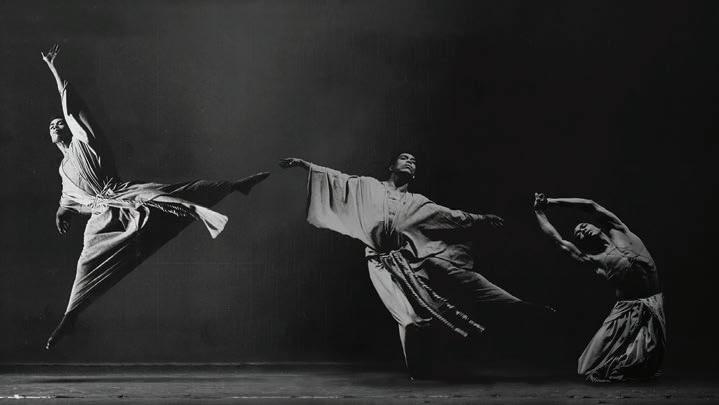
Some things are excruciatingly difficult to articulate in words, and can only be expressed in an abstract manner such as dance. Things such as the lonely success of Alvin Ailey, a gay man born in the depression in 1931 who, against all odds, was able to realize his dream. Choreographer, former Ailey company member, and friend George Faison reflects on their groundbreaking work that was rooted in Black liberation: “We didn’t have to go out to the street and protest, our protest was on the stage.” Director Jamila Wignot’s film gives voice to the silent protest in Ailey’s heart that did not have an audience. —S.F.
With beautiful cinematography and a gorgeous score, Captains of Za’atari follows two friends, Fawzi and Mahmoud, living in the largest Syrian refugee camp in Jordan. Their love of soccer unites them, providing an escape from life in the camp both figuratively and later literally when their team travels to Qatar to compete. Director Ali El-Arabi cra s a film of deep humanity, providing an exposé of the struggles and tragedies of refugee life, as well as the hope these talented young men possess in the face of nearly insurmountable odds. When provided a platform to share their dreams, they hope for a world where refugees can get opportunities for education, medical treatment, and sports, instead of pity, summed up with one of the final quotes, “Dreams cannot be imprisoned or confined.” —J.F.
In a foggy 19th-century village, a wild animal is ripping people apart. But we know it’s not a wolf, like everyone suspects. Eight for Silver deliciously revives and enhances the werewolf genre with Boyd Holbrook (Pierce in Logan) as the Van Helsing-like hunter-come-to-town
to avenge the death of his wife and son and rid the countryside of a pervasive evil. Director Sean Ellis succeeds in cra ing the mood and setting needed for solid suspenseful horror, and his new take on the lycanthrope myth is both fresh and gross, in a good way. —J.F.
Director Jonas Poher Rasmussen met Amin, the subject of his film Flee, when both were 15 years old. It wasn’t until both men were adults that Amin shared his secret harrowing story of fleeing the Mujahedeen in Afghanistan and arriving alone in Denmark by way of Russia. Today, as Amin prepares to get married to his boyfriend, his story, shared publicly for the first time, reveals secrets he had been hiding for 20 years about his family and his traumatic journey to freedom from war-torn Afghanistan to Russia and finally to Denmark. Beautifully animated to protect the identity of the main subject, Rasmussen’s film examines the lengths we will go to in order to survive and protect those we love. —J.F.
The class of 2020 at Oakland High School had a turbulent year, captured with immediacy and intimacy in Peter Nicks’s documentary Homeroom. As the only school in their district with its own police force, students, families, and the school board clashed a er seeing numerous online videos and firsthand experiences of violence against students by security. As COVID empties out the school and the BLM marches start, many students journey from working with the school establishment to leading protests for social change. The role of social media for students, like the world at large, moves from a distraction to a means of revolution, uniting youth in the fight for equality and autonomy. —J.F.
On New Year’s Eve 2019, thousands of colorful balloons float through the sky haphazardly, a terrifying harbinger of the cost to come for the Wuhan government jailing eight people for “spreading rumors about a fake pneumonia.” Outstanding director Nanfu Wang was prescient enough to send a covert team of cameras into hospitals, homes, and morgues to capture the truth and anguish, then follow the virus—and the bungling cover-up—across the sea to America. Have your tissues nearby. —S.F.
You know you’re in uncharted territory when Michael C. Hall, the star of the murderous hit series Dexter, is the least terrifying thing in a film. This dark fable is a breakout role for Charlie Shotwell, who plays John, the
too-quiet son who holds his family captive in a hole in the ground. Director Pascual Sisto’s gaze dri s languidly across the scenery, building the slow, quiet terror of the dreaded certainty of an awful situation. —S.F.
Taking two pairs of seasoned stage and film actors and putting them in a room for two hours to hash out a shared trauma sounds like the making of a great Tennessee Williams play, but it is instead a riveting and unforgettable feature by writer-director Fran Kranz. Mass was initially intended to be set on stage, Kranz said in the Q&A a er the Sundance premiere. The film instead allowed this actor-turned-director to put forth a powerful directorial debut about two couples coming together years a er a school shooting; one couple lost their son, the other couple’s son perpetrated the mass murder. Martha Plimpton, Jason Isaacs, Reed Birney, and Ann Dowd deliver award-worthy performances as parents coming to terms with the once-unthinkable that has sadly become more of a shared experience. —J.F.
A delightful update in the tradition of 80s films like Uncle Buck, where a crotchety adult befriends a teen with a bad attitude and wise-cracks them out of depression. A wonderfully infuriating, surly, and grief-stricken Sammy (Miya Cech) is no match for the charms and take-no-prisoners attitude of Margot, played by Rhea Perlman in a welcome return to the screen. Funny without being forced, and sincere without being schlocky, Marvelous is guaranteed to warm the hearts of wannabe baby goths everywhere. —S.F.
A curious magical realism metaphor for feminist despair, Ana (Grace Van Patten) is crushed by the patriarchy, and her essence is fractured into a merry band of sirens, representing different emotions that the real world does not hold space for, like timid fear and unchecked rage. The themes are applied with a light and jolly touch, creating a film that is quirky, bracing, and refreshing—in the manner of the first breath of air a er nearly drowning. —S.F.
Swedish hopeful Bella Cherry arrives in Los Angeles hoping to be the next top porn star. Pleasure takes the viewer on an explicit journey into the business of adult films from the perspective of an enthusiastic but naïve woman learning the ins and outs of the male-dominated world of porn. Cherry traverses the opportunistic competition and rapacious executives, enduring violence on set, all to fuel an industry that increasingly caters to the expanding, disturbing tastes of Internet fetishes. Writer-director Ninja Thyberg explores questions of com-

plicity and consent in the face of fierce coercion. She expanded her Sundance short of the same name into a brave and at times painfully cringeworthy feature on how women attempt to assert power as they erect their reputations in the adult entertainment industry. —J.F.
The new book from Chicago Reader’s own Maya

A fascinating look at how independent, non-marriage-minded women in the 1940s-60s joined religious orders to escape patriarchal society at large, only to find themselves in another patriarchal society—and then how some became a bunch of kick-ass nuns. Rebel Hearts is the illuminating story of the trailblazing women of The Sisters of the Immaculate Heart of Mary who, in 1960s Los Angeles, not only took on the dogmatic church doctrine, but also fought for civil rights, their jobs, and their autonomy against the powerful Cardinal McIntyre who tried to keep them under his thumb. Anita Caspary, Helen Kelley, Pat Reif, and Corita Kent, among others, redefined rules for nuns. An eye-opening look at an o -overlooked group of women who have changed what it means to selflessly serve others while also fighting for yourself. —J.F.
A compelling and revealing portrait of an American legend with the ebullience of a teenager. Director Mariem
Peréz Riera opens a door to Moreno’s unstoppable ascent to stardom as a teenage actor with an MGM contract, struggling as the industry relegated her to racist “dusky maiden” roles while in a torrid love affair with Marlon Brando. Riera mercifully doesn’t wallow in West Side Story and instead shares Moreno’s power as an activist and an EGOT-winning performer who continues to break barriers as an 87-year-old with a hit TV show, One Day at a Time —S.F.


Sweden had a strong showing at Sundance in 2021 and Sabaya might be their best offering. Director Hogir Hirori has made an emotionally haunting film about real-life super heroes in Mahmud, Ziyad, and their group who, with just a gun and a cell phone, evade ISIS to rescue Yazidi women and girls being held hostage as sabaya (sex slaves). Hirori astonishingly documents actual rescues, dodging real bullets, with these brave men and women who risk their lives venturing into the most dangerous refugee camp in the Middle East, Al-Hol in Syria. Tense moments sneaking into the camps searching amidst hundreds of tents, the women covered in burqas, are balanced with serene moments outside captivity where the rescued women can remove their coverings and taste freedom. —J.F.
A nostalgic yet informative look at the most successful
children’s television show in history. When it was created, Sesame Street was groundbreaking not only in its idea of providing honest, quality children’s programming without trying to sell kids products or speak down to them, but in assembling a team of educators, teachers, experts, even children to help inform their exhaustive approach. The film shines a spotlight on well-known players, like Jim Henson, but also on founders Joan Ganz Cooney, Lloyd Morrisett, composer Joe Raposo, and many of the lesser-known actors and characters. Several of the important moments in Sesame Street and television history are featured, including the memorable discussion of death a er the loss of “Mr. Hooper,” a script taken from the real-life death of actor Will Lee who played the beloved character. —J.F.
In 1969 a “Black Woodstock” festival was held in Harlem with more than 300,000 people in attendance, then forgotten by history. Questlove revives this electric, never-before-seen, de ly edited footage of Black joy and community, along with interviews of participants. Highlight performances include Stevie Wonder, Gladys Knight and the Pips, a show-stopping duet with Mavis Staples and Mahalia Jackson, and tiny blink-and-missthem cameos of Moms Mabley and Redd Foxx. —S.F.
Welcome to Lowell High School, the top school in the San Francisco area with a majority of Asian American students, or what one student calls “tiger mom central.” These young overachievers face immense pressure to succeed from themselves, their peers, and their parents in order to get into the top colleges, pinning their whole lives on a single test or acceptance letter. Most teachers, but sadly only a few parents, try to instill a greater purpose in these kids’ lives than going to Stanford. An interesting film about how kids pursue things without knowing why, at its best when occasionally digging deeper into issues of race, stereotypes, and privilege. —J.F.
A triumphant and well-deserved spotlight on the journalists of Khabar Lahariya, India’s only newspaper run by Dalit women—the lowest rung of the caste system. With steely tenacity and persistence, these women place themselves into terrifying situations to interrogate corrupt police officers and potentially violent Hindu Nationalists, with a de and skill not seen by many top network reporters. O en armed only with a dying cell phone and the truth, they successfully gain justice for forgotten victims. —S.F v
@joshua_flanders @SheriFlanders
Get showtimes and see reviews of everything playing this week at chicagoreader.com/movies
is, and hopefully those themes—purpose, belonging, illness, work, faith—won’t get lost in the cuteness. —MAX MALLER 115 min. Davis Theater, Landmark’s Century Centre Cinema, ShowPlace ICON
Veteran Russian writer-director Andrei Konchalovsky (who cowrote Andrei Tarkovsky’s Ivan’s Childhood and Andrei Rublev; his better-known directorial efforts include Siberiade and Tango & Cash) dramatizes the events of the 1962 Novocherkassk massacre, when 26 unarmed protesters were killed by Red Army soldiers and KGB operatives. Lyuda (Julia Vysotskaya) is a committed party official whose teenage daughter works at the auto factory where employees are striking against lowered wages and the rising cost of living; both Lyuda and her daughter get caught up in the events, which results in the aforementioned murders and labyrinthine cover-ups (in real life the massacre was kept secret until the 1990s). Lyuda is also a devout Stalinist, while her father, who lives with her, is a nihilistic Don Cossack, and her daughter represents the illusion of liberalism during the so-called Khrushchev Thaw—three epochs of Soviet politics under one roof. The drama is impelled by the daughter’s disappearance a er the bloody protest; as she searches for her child amidst a myriad of state complicities, Lyuda comes to question her fervent belief in communism. Konchalovsky cowrote the film with frequent collaborator Elena Kiseleva and shot it in blackand-white, in the boxy Academy ratio. Despite such familiar European art-house trappings, it’s nonetheless commanding as it considers both Soviet history and the fates of its characters. Vysotskaya’s performance in particular is riveting—through her acute portrayal, one witnesses these extraordinary phenomena: the challenging of a belief system and the extirpation of one’s tricky convictions. In Russian with subtitles. —KATHLEEN SACHS 120 min. Music Box Direct
I Care A Lot plays a lot like a spiritual sequel to Gone Girl, with Rosamund Pike reprising her role as a studied and successful schemer. As Marla Grayson, a crooked legal guardian who drains her elderly wards’
savings, Pike is perfection. She’s self-assured and ruthless in her pursuit of wealth, which she acquires through legal but dubious practices with the help of her business partner and girlfriend Fran (Eiza González). That is until they meet their match when their latest mark turns out to be more than they bargained for. A rich retiree with no living family, Jennifer Peterson (Dianne Wiest) was supposed to be the perfect victim. Unfortunately, she comes with strings attached via a volatile crime boss (Peter Dinklage) determined to squash Marla and Fran’s scam. Marla’s not willing to go without a fight, though, creating a high-action thriller that twists and turns until the last minute. —BECCA
JAMES 118 min. NetflixThis is a movie so sweet, and so inviting, that what’s most beautiful and complex about it is bound to be ignored by a great many viewers. Yes, it’s an immigrant story. Steven Yeun and Han Ye-ri play immigrant South Korean parents Jacob and Monica Yi, who leave bad prospects in California to take a gamble on land, which father Jacob Yi wants to farm in Arkansas while the family inhabits a trailer. But it’s also a story about a version of precarious working life in America that the Yis, who make a living manually sorting chicklets by sex at a hatchery, have internalized, and become a part of, long before the movie begins. Yes, it’s the “anti-Parasite,” a movie with very little to it at all of either absurdity, cruelty, or irony. But there’s a lot that connect the two. They both give a central role to family, for instance, even if Minari treats the obstacles to that family’s happiness as a quietly immense tragic fate and Parasite finds them funny. When director Lee Isaac Chung and Bong Joon-ho discussed the movie at a Variety magazine event last December, the first thing Bong asked Chung was if Chung’s parents had seen it yet. The question makes more sense the more we see memory album-like scenes inside the Yi family trailer. David, played by Alan Kim, steals the show as the kid under everyone’s heels. But the movie is about much, much more than how sweet and adorable David
In Nomadland, Chloe Zhao’s vividly somber and heartfelt neo-western drama adapted from Jessica Bruder’s eponymous nonfiction book, Fern (Frances McDormand) struggles to find her place on the open roads of the contemporary American west. Having lost her husband who recently died and her home when the local plant closes in her small Nevada town, Fern sells off her possessions and sets off in her van in search of work. A series of temporary jobs put her in touch with a loose community of nomadic travelers, espousing a disconnect from typical American life. Zhao’s story is both subtle and consequential, with cinematography composed of the sweeping western landscapes mixed with the mundane tasks of temporary labor that make up Fern’s daily life. Loss and instability pervade the film, both in Fern’s grief over her husband, and the unmooring of the collapse of her previous life in a boomand-bust Nevada town, and the temporary relationships that develop in her travels. Fern’s interactions with other nomads—with several appearances by the actual nomads described in Bruder’s book playing fictionalized versions of themselves—are fleeting but poignant, sharing moments of grace as they briefly cross paths and continue on down the road in search of fulfillment. —ADAM MULLINS-KHATIB 108 min. Hulu

Red Dot is a semi-contained, high-concept thriller with a strong reveal. Directed by Swedish filmmaker Alain Darborg, it follows Nadja (Nanna Blondell) and David (Anastasios Soulis) on a hiking trip intended to renew their deteriorating relationship. What starts as an idyllic getaway to snowy Sweden takes a foreboding turn, and soon the expectant parents are fleeing for their lives from an unknown shooter in the unforgiving wilderness. With a red dot perpetually trained on them, they do their best to dodge an untimely death but can’t escape several smaller yet still gruesome misfortunes. The resulting tension reaches a climax as the reveal identifies the killer and adds surprising context to the couple’s characters. A high-stakes take on fighting for family, the film ponders whether it’s better or worse to meet your fate face-to-face, that is, to exist in ignorant bliss or to understand your potential murderer’s malice.
—BECCA JAMES 85 min. Netflix
It’s been said that good things come to those who wait, and a er numerous delays, the highly-anticipated release of Saint Maud is finally here. True to the adage, it’s good—even great. The debut film from
writer-director Rose Glass paints an eerie portrait of a pious hospice nurse obsessed with saving her dying patient’s soul. An engaging meditation on faith and foolishness, the film follows the mysterious and mousy Maud (Morfydd Clark) as she grapples with sinister forces and a sinful past while caring for the world-weary Amanda (Jennifer Ehle). Anchored by Clark and Ehle’s captivating performances Saint Maud sees the women’s desires brush against one another in increasingly uncomfortable interactions that keep viewers guessing. Is Maud really a saint sent to do God’s bidding, or merely a troubled woman looking to save herself? Settle into the muted scenery, which comes with bursts of madness, to find out. —BECCA JAMES 84 min. Epix
Drenched in a dreamlike quality, The Sinners lures viewers into a dark and deadly world where writer-director Courtney Paige’s influences from Scream to Jawbreaker bleed through brilliantly. Part teen thriller and part police procedural, the movie follows seven girls who belong to a cultish clique called The Sins. The prideful Aubrey (Brenna Llewellyn) narrates, while the lustful Grace Carver (Kaitlyn Bernard) leads the greedy Katie Hamilton (Keilani Elizabeth Rose), the envious Stacey Rodgers (Jasmine Randhawa), the wrathful Tori Davidson (Brenna Coates), the gluttonous Molly McIvor (Carly Fawcett), and the slothful Robyn Pearce (Natalie Malaika). Together, the girls complete and o en commit the capital vices of Christianity. Struggling with their faith and fighting for their life when they become the targets of an unknown killer, the movie pushes past the standard dead girl narrative to provide a nuanced look at the teenage experience as each actor imbues their character with authenticity. —BECCA JAMES 96 min. In wide release on VOD
France’s official Oscar submission is a moving testament to coming out and staying together. Two of Us, the feature debut from Filippo Meneghetti, follows two neighbors who have been in love with each other for decades. Nina (Barbara Sukowa) is excited for them to sell their apartments and finally live the rest of their lives out of hiding, but Madeleine (Martine Chevallier) is having trouble telling her children about the move—and her relationship with Nina. This conflict pushes them apart, but when an unexpected health crisis emerges, Nina has to figure out how to care for Madeline and stay in her life without being discovered by her daughter, Anne (Léa Drucker). Two of Us is a tearjerker on paper, but it really comes alive in its performances. Sukowa, Chevallier, and Drucker are kinetic together, feeding off of each other’s love and desperation until it bubbles up out of control. —CODY CORRALL 119 min. Through 2/25, Facets Virtual Cinema v
It’s a well-known fact that for many older Americans, the home is their single biggest asset, often accounting for more than 45% of their total net worth. And with interest rates near alltime lows while home values are still high, this combination creates the perfect dynamic for getting the most out of your built-up equity.
But, many aren’t taking advantage of this unprecedented period. According to new statistics from the mortgage industry, senior homeowners in
Request
the U.S. are now sitting on more than 7.19 trillion dollars* of unused home equity.
Not only are people living longer than ever before, but there is also greater uncertainty in the economy. With home prices back up again, ignoring this “hidden wealth” may prove to be short sighted when looking for the best long-term outcome.
All things considered, it’s not surprising that more than a million homeowners have already used a government-insured Home Equity Conversion Mortgage (HECM) loan to turn their home equity into extra cash for retirement.
It’s a fact: no monthly mortgage payments are required with a government-insured HECM loan; however the borrowers are still responsible for paying for the maintenance of their home, property
taxes, homeowner’s insurance and, if required, their HOA fees.
Today, HECM loans are simply an effective way for homeowners 62 and older to get the extra cash they need to enjoy retirement.
Although today’s HECM loans have been improved to provide even greater financial protection for homeowners, there are still many misconceptions.
For example, a lot of people mistakenly believe the home must be paid off in full in order to qualify for a HECM loan, which is not the case. In fact, one key advantage of a HECM is that the proceeds will first be used to pay off any existing liens on the property, which frees up cash flow, a huge blessing for seniors living on a fixed income. Unfortunately, many senior homeowners who might be better off with a HECM loan don’t even bother to get more information because of rumors they’ve heard.
In fact, a recent survey by American Advisors Group (AAG), the nation’s number one HECM lender, found that over 98% of their clients are satisfied with their loans. While these special loans are not for everyone, they can be a real lifesaver for senior homeowners - especially in times like these.

The cash from a HECM loan can be used for almost any purpose. Other common uses include making home improvements, paying off medical bills or helping other family members. Some people simply need the extra cash for everyday expenses while others are now using it as a safety net for
*Source: https://reversemortgagedaily.com/2019/12/17/senior-housing-wealth-reaches-record-high-of-7-19-trillion
financial emergencies.
If you’re a homeowner age 62 or older, you owe it to yourself to learn more so that you can make the best decision - for your financial future. It’s time to reverse your thinking We’re
Reverse mortgage loan terms include occupying the home as your primary residence, maintaining the home, paying property taxes and homeowners insurance. Although these costs may be substantial, AAG does not establish an escrow account for these payments. However, a set-aside account can be set up for taxes and insurance, and in some cases may be required. Not all interest on a reverse mortgage is tax-deductible and to the extent that it is, such deduction is not available until the loan is partially or fully repaid.




AAG charges an origination fee, mortgage insurance premium (where required by HUD), closing costs and servicing fees, rolled into the balance of the loan. AAG charges interest on the balance, which grows over time. When the last borrower or eligible non-borrowing spouse dies, sells the home, permanently moves out, or fails to comply with the loan terms, the loan becomes due and payable (and the property may become subject to foreclosure). When this happens, some or all of the equity in the property no longer belongs to the borrowers, who may need to sell the home or otherwise repay the loan balance. V2020.12.22


NMLS# 9392 (www.nmlsconsumeraccess.org). American Advisors Group (AAG) is headquartered at 18200 Von Karman Ave, Suite 300, Irvine CA 92612. Licensed in 49 states. Please go to www.aag.com/legal-information for full state license information.
These materials are not from HUD or FHA and were not approved by HUD or a government agency.
More than 1 million seniors have taken advantage
In October 2019, Manae Hammond hopped in a car and drove from Chicago to Akron, Ohio, with her friend Eric Christopher. They’d known each other for a month, and they were heading to the first show by their band Hospital Bracelet. It’d been Christopher’s acoustic solo project for three months, and would end up operating as a live band for just five more before the COVID-19 pandemic put a stop to concerts indefinitely. But though Hospital Bracelet had played only around 20 shows by then—including the 14 on their sole tour, to the east coast and back in January 2020—they swiftly sold out vinyl preorders for their debut album, South Loop Summer, ten months later.
The album was released five weeks ago by Counter Intuitive Records, a key player in the current underground emo ecosystem. It’s the only full-band Hospital Bracelet recording since a single that dropped in January 2020. But that single has racked up nearly 600,000 Spotify streams—a startling number for a brand-new band in a niche scene—and the album is outpacing that success already.

Hammond joined Hospital Bracelet in September 2019 after Christopher used a Columbia College student social app to recruit a drummer. During the first full-band rehearsal (the group’s original bassist only lasted till that first show in Akron), Christopher heard from emo cassette label 3rd Row Records with an offer to release their solo material. The label was tiny, but this was still big news—it had already worked with several stars of the genre’s insurgent fifth wave, including Worst Party Ever (Seattle), Guitar Fight From Fooly Cooly (Chattanooga, Tennessee), and Commander Salamander (Washington, D.C.).
“At that moment, I was like, ‘Oh shit, I guess I’m in this—I cannot turn back now,’” Hammond says. The Akron gig where Hospital Bracelet first played as a band was at Bless This Fest, a daylong DIY gathering that also included crossover phenomenon Dogleg.
“I hadn’t gone somewhere else to go play a show in a long time,” Hammond says. “I was like, ‘Oh yeah, this was kind of a lot to do, but I don’t care. This is so much fun.’ We drove seven hours there and seven hours back over the weekend. We played the show, came back, and just immediately started practicing more and more.”
In November 2019, Hospital Bracelet brought on a new bassist, fellow Columbia student Arya “A.J.” Woody. Christopher’s solo material, packaged as the Neutrality Acoustic EP, came out that month on 3rd Row, which also released the full band’s first single, the sweaty and unvarnished ballad “Sober Haha
continued from 35
JK Unless.”
Hospital Bracelet released the single in January 2020, at the start of what’s still their only tour. The trio’s time on the road helped them work out the material they’d written together as well as the arrangements the new members had built around Christopher’s older songs. By the end of February, when they began recording South Loop Summer with engineer Adrian Kobziar, they were a tight unit. “Halfway through recording, we were like, ‘Oh shit, oh no, COVID,’” Christopher says. “We haven’t actually all been in the same room together since March.”
The pandemic also delayed the release of South Loop Summer, which they’d planned to drop late last year. Counter Intuitive didn’t get involved till the fall. Label founder Jake Sulzer had kept an eye on Hospital Bracelet since noticing them on bills with Counter Intuitive bands. Ryland Heagy, guitarist and vocalist for hyperactive D.C. duo Origami Angel, is one of Hospital Bracelet’s earliest champions.
“I wasn’t the biggest fan when I first listened to them,” Sulzer says. “I did enjoy the acoustic songs, but I didn’t love the sound of the original single for ‘Sober Haha JK Unless.’ I wasn’t that big a fan of the production value on it. My opinion didn’t really change until I heard the mixes of their new record. Then I was like, ‘Oh, they’re the real deal.’”
Counter Intuitive has worked with some of the underground emo scene’s most popular acts, including Mom Jeans, Prince Daddy & the Hyena, and critical darlings Oso Oso. Hospital Bracelet are in a position to build on their precedents. “The first era of bands that got the label o the ground, some of those bands have moved on, some of them have been quieter over the last few years,” Sulzer says. “I’ve been consciously thinking, ‘OK, I hope that I have another era of bands that can not only participate in the community that first era built, but also have one of their own.’ And I feel like Hospital Bracelet really helped me solidify, in my mind, that there’s a new era of the label happening right now.”
Hospital Bracelet are beginning a new era too. Christopher plans to move to Charlotte, North Carolina, in June, to be with their partner, which will break up this version of the band. Hammond and Woody will remain in Chicago, and Christopher is recruiting new musicians in Charlotte.
“It’s stinky, because I know that if we weren’t in a pandemic, we’d probably be able to do this a whole lot easier, and record something real that we want to do together,” Christopher says. “But we want to do something
before everything comes to a close, because we all really enjoyed our time together and like this band.”
Christopher, 19, had already been a touring performer for a few years before starting Hospital Bracelet. At age 14 they became a fan of indie wrestling and began training to enter the ring in their native Indianapolis. Known professionally as Arc Williams (and nicknamed “the Teenage Bottle Rocket”), Christopher traveled as far as Florida to throw themselves at opponents.
“There are a lot of states in the U.S. where you can’t wrestle until you’re 18,” Christopher says. “But I would travel to Pennsylvania, Illinois, Ohio, New York—all over the place.” In September 2018, Chicago promoter Kaiju Attack Wrestling hosted a tag-team match that Christopher considers a career highlight—the opposing team included Shotzi Blackheart, who went on to join the WWE.
Three months before that match, though, Christopher had been involved in a careeraltering car crash a mile from home. At their mom’s behest, they paid a visit to a chiropractor. “I went and I was like, ‘I have this really big important match next week,’” Christopher says. “‘Do you think I can still do it?’ They were like, ‘Absolutely not.’ I was like, ‘OK, cool. I’m still gonna do it.’ Then I went, and I had the match, and I couldn’t move my body the next day. I was like, ‘OK, I have to go back to the chiropractor now.’ They were like, ‘You can’t move your arms above your head right now. You need to take a break.’”
According to the chiropractor, Christopher had early-onset arthritis in their neck, either caused or aggravated by the crash, and it seriously complicated their wrestling aspirations.
“It turns out that you’re not supposed to fall a whole lot,” Christopher says. “That’s bad for your body.”
Christopher moved to Chicago in summer 2018 to study acting at Columbia College, and initially resumed wrestling training as well. But that only lasted till halfway through their first year of college—they decided to take a longer break from wrestling, which allowed them to spend more time with an earlier love.
Christopher had started writing original music at age 12, and around the same time had begun volunteering to work the door at an Indianapolis all-ages venue called the Hoosier Dome. “I lied about my age, so I was allowed to volunteer,” Christopher says. “I was like, ‘Yeah, I’m 15, I promise.’ I was not 15, I was 12.” The Hoosier Dome gave Christopher free admission to concerts, and before wrestling took over their free time, they saw tour dates
by Mom Jeans and Modern Baseball.Chicago quickly reignited Christopher’s love of music—the spark was a show at suburban DIY space Panda Palace. “I immediately fell back in love with going to shows all over again,” Christopher says. They made friends with a few people from the local scene, including indie singer-songwriter Nayla Jungheim, who’d later record the material on Neutrality Acoustic.
“Because of those people, I got on Twitter and got into the DIY community that’s online,” Christopher says. “I’ve been not nearly as involved as I’d like to be in Chicago shows and the local scene, but really, really involved with bands from all across the country and the friends I’ve made because of being online.” The Web is where Christopher met their partner and connected with Heagy from Origami Angel.
In June 2019, Christopher answered a call for performers from Panda Palace, sending in old solo demos. They got a gig and had to come up with a stage name. Just days earlier, they’d gone to the hospital after being sexually assaulted, and they hadn’t removed their wristband since the visit. “I realized that it’s really hard to play guitar when you have a hospital bracelet on,” Christopher says. “I was still thinking about names. And I was like, ‘This stupid little hospital bracelet has been the only thing for the last four days that has kind of kept me from going insane, and I have to take it o now.’ So it only makes sense that the only other thing that seems to be keeping me from losing my mind is named after it.”
The following month, Christopher debuted the solo version of Hospital Bracelet at Downers Grove instrument shop Evolution Music, booked by the promoter at Panda Palace. Detroit band Dogleg shared the bill. “Dogleg played at Hospital Bracelet’s first show ever,” says front man Alex Stoitsiadis. “We also sold them their first distortion pedal. It’s awesome to see how far they’ve come from just playing by themselves.”
Manae Hammond, 22, grew up around dance music—her mom is popular Chicago house DJ Lady D. For years Hammond resisted music’s call, but in middle school she got hooked on jazz and rock. As a seventh-grader, she enrolled in her school’s band class; she wanted to play drums, but that wouldn’t fly in her family’s 800-square-foot apartment. “I chose the trumpet, which makes no sense, but my mom was like, ‘OK, yeah, that’s more acceptable than the drums—you can mute a trumpet,’” Hammond says. “I did that for a year straight, and got my basic
music education that way.”
In her free time, Hammond taught herself how to play an acoustic guitar she’d owned since childhood and toyed with recording on GarageBand. While she was in high school at the Latin School of Chicago, a spot for a bassist opened up in the jazz band. “I really wanted to play guitar,” Hammond says. She’d never picked up a bass before. “I was like, ‘I guess that’s the only spot I have open.’ I ended up being an all-state bassist for the last three years of high school. That was when I really, really learned jazz, and really got my footing in that. And at night, I would go and play bass in any band I could get into.”
Hammond had her introduction to the DIY scene in January 2014, when she went to a basement show to see pop-punk-flavored indie band Parasol. “It was a religious experience,” she says. “I could touch the ceiling with my head if I stood on my tippy-toes. This loud, loud band was playing, and I was like, ‘This is amazing! How did I not know that this existed?’ I was hooked forever—it was a done deal.”
Now that her feet were wet, Hammond dove in with the aid of the DIY Chicago Facebook group. Within a few months, she’d joined a noisy art-rock group called Vaguewaves; by 2015, she was playing with Oxford Comma, a cheeky indie-rock band active in Evanston’s teen emo scene. She also had a solo project, Jyant Steps, but she put it on the back burner after a fried computer lost the files of her debut album. “At that point, I was like, ‘Oh, so maybe this isn’t meant to be,’” she says. “‘Maybe I’m supposed to be a supporting musician for the rest of my life.’ I took it really heavily.”
In fall 2016, Hammond moved to Los Angeles to attend Whittier College. “I immediately realized that if I was gonna be a musician in California, I needed way more money than I had,” she says. “I lived that year by the seat of my pants, financially.” Near the end of her time there, she was living in a closet off campus because she couldn’t a ord room and board.
California wasn’t a total wash for Hammond, though: she met her romantic partner, Indigo Finamore. Together they formed the experimental electronic-pop duo Oux, and they both transferred to Columbia College.
After returning to Chicago in 2018 (Finamore would follow later), Hammond got right back to juggling multiple musical projects. She joined postpunk group Blush Scars, but Oux increasingly took precedence in her creative life. “When it’s just two people in the band, half the work is on you and half is on the other person,” she says. “If you want to make great music, you have to put your whole foot
into it. And that was something I just needed more time for, especially being in school at the same time.”
Hammond dropped out of Blush Scars but continued gigging as a support player when she could. She contributed to a few Columbia College jazz ensembles and backed rapper Mykele Deville in concert. She started taking drum lessons too, because she still had an itch to scratch. “I was like, ‘I just want to do something really loud, energetic, and fun again,”
she says. “I just missed that.” Then she saw Christopher’s call for bandmates. “I was like, ‘Oh, an emo band,’” Hammond says. “‘They need a drummer? Sure.’”
Arya “A.J.” Woody, 20, went to their first DIY concert in September 2019, shortly after moving to Chicago to go to Columbia College. Woody says they su er from social anxiety, but they wanted to see the show badly enough to get a ride with
Hospital Bracelet, top to bottom: Eric Christopher, Manae Hammond, and Arya “A.J.” Woody CHRISTINE KOS
another student they barely knew. “When we got there, it was a house, and the whole entire place seemed to be, like, just for music, which I hadn’t thought of as a concept,” Woody says. “Everything was new on top of new. It had a really nice community feel.”
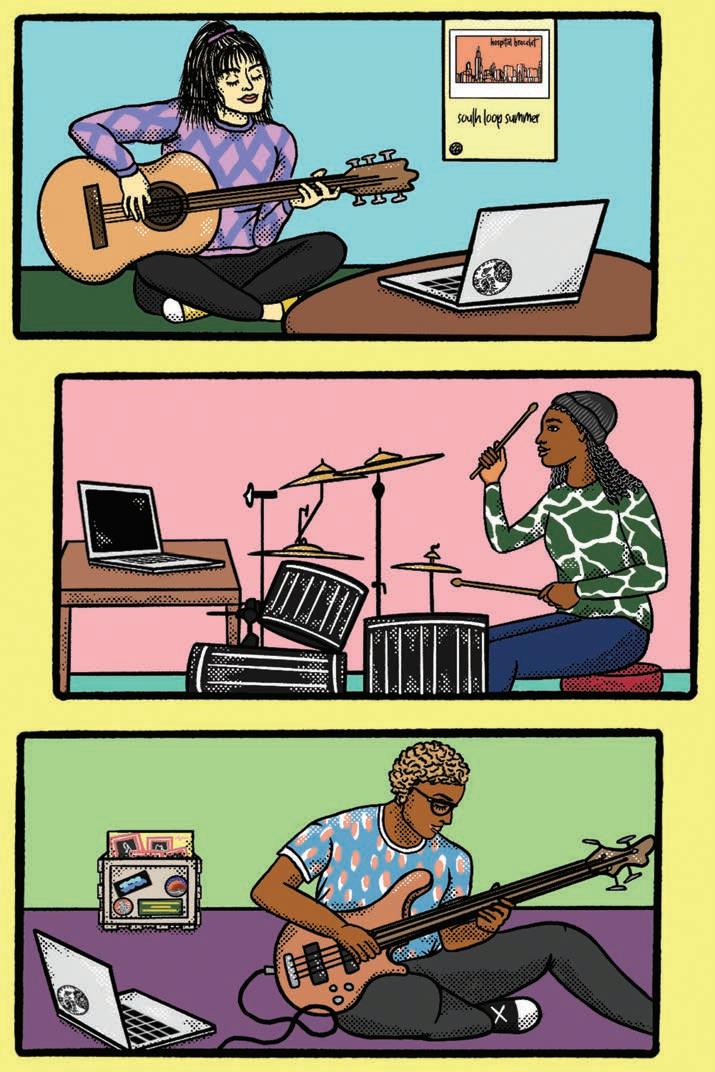
Woody grew up playing in school jazz bands in the suburbs of Richmond, Virginia. “I was playing bass,” Woody says. “I started on upright and then moved to electric. I used to be in my school orchestra from third grade until, like, the middle of high school.” They briefly attended Nazareth College just outside Rochester, New York, before transferring to Columbia for its more robust arts education and diverse student body.
Woody met Hammond and Christopher shortly after moving here, Christopher just before that first house show and Hammond in a music class that had started in late August. Woody ran into Hammond and Christopher in late September and asked when Hospital Bracelet would perform next. “They mentioned that they might need a bassist for the show,” Woody says. Woody joined the band soon after Bless This Fest in Akron and began helping write what became South Loop Summer.
Some of the songs on the album are material Christopher wrote before they met Hammond and Woody—a couple also appear on Neutrality Acoustic . But the rhythm section quickly learned where to apply muscle to powerlift Christopher’s raw songs. “Eric’s songwriting is very tight, so it’s easy to follow structure and feel where momentum is supposed to be going,” Woody says. “And Manae’s drum parts are insane.”
Hospital Bracelet have evolved a nimble, sprightly sound that foregrounds Christopher’s galloping, mathy guitar ri s and powerhouse voice—they sing in a higher register and with more confidence than most emo vocalists. Hammond and Woody ratchet up the songs’ intensity with focused, hyperactive energy. You can hear that the three musicians get along well. “It’s been fun,” Woody says. “It’s felt like I’ve known them for a little bit longer than I have, which only happens occasionally for me.”
Pittsburgh booking agent Alex Martin manages Hospital Bracelet and books them through their collective, You’ve Got a Friend in Pennsylvania. Before the pandemic hit, Martin was booking 30 acts, including Ori-
gami Angel, whimsical LA band Glass Beach, and mathy Pittsburgh group Short Fictions (in which they play bass). “With Hospital Bracelet, we were getting tour offers before the record was even finished—people were going after the band just because Eric is so captivating as a human being,” Martin says. “They have taught me that there’s not one way to do things. There’s not one way to book a band, there’s not one way to make it work.”
Christopher is extremely online, with more than 17,000 TikTok followers, and genuinely enjoys promoting Hospital Bracelet. This helped a lot once the pandemic made it impossible for the band to play shows.
When Illinois entered its first statewide lockdown last March, Woody returned to Richmond. Christopher then went to North Carolina to live with their partner for a few months. The bandmates dropped out of touch for long periods. “There were plenty of times where I just had to fall o the earth for a little bit, because I was going through a shit-ton,” Christopher says. “And then there were times when both of them had to do that too. In the end, we’ve always come back to being like, ‘Yeah, we’re a band. Right now we’re a band and it rocks.’”
Christopher returned to Chicago last summer, and in July they went back to the studio with Kobziar to wrap up their contributions to South Loop Summer. “All there was left to do was guitar, vocals, and harmony,” Christopher says. “We were like, ‘Oh shoot, we don’t get to do gang vocals now.’ But I would rather not have gang vocals than have a virus.”
In December, Christopher broke the news about their upcoming move to North Carolina to Hammond and Woody. Christopher no longer had school obligations keeping them in Chicago, having dropped out of Columbia after two years—in September they’d begun taking online classes toward a teaching degree from Grand Canyon University.
Christopher intends to put together a new band once they get settled in Charlotte, but the bond they formed with Hammond and Woody will endure in Hospital Bracelet’s music. “With those two, I was starting to make music that I always wanted to make that I didn’t think I was capable of,” Christopher says. “Manae and Arya both helped me make the kind of sound that I’ve been wanting to do for a long time. And I’m really thankful for them.”
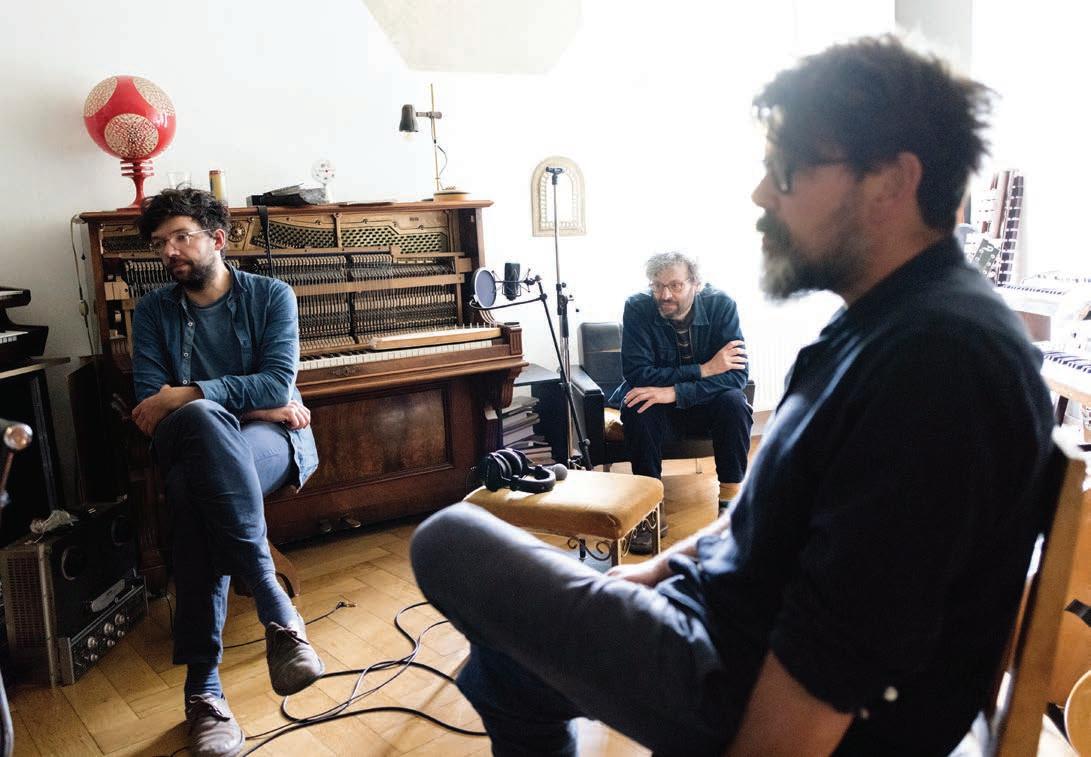
johncarpentermusic.bandcamp.com/album/lostthemes-iii-alive-a er-death
John Carpenter is a master of thrills. The legendary filmmaker and composer unnerves and titillates by fusing sight and sound—how the light catches a blade or outlines a breast, for instance, and the way heartbeat rhythms drive his bare synths. Because Carpenter’s horror and sci-fi movies establish a visual and emotional vocabulary for his music, the albums in his Lost Themes series similarly build up dangerous tension followed by resolution. That’s what makes his latest release, Lost Themes III: Alive After Death , surprising. Instead of being faithful to this formula, Carpenter and his longtime musical partners—his son, Cody, and his godson, Daniel Davies, son of the Kinks’ Dave Davies—have created an ambient unease that’s never fully realized or resolved.
Tracks such as “Weeping Ghost” and “The Dead Walk” have the manic, aggressive energy of someone escaping, stalking, or fighting—arguably the hallmark of Carpenter’s most beloved songs—but they’re not juxtaposed with pieces that evoke calm or recovery. Instead, Carpenter uses his distinctive flourishes—electronic bass lines, shimmering keyboards, and groaning chain-saw guitars—to create a simmering anxiety. This could be a conscious reaction to the pandemic, or to a sociopolitical climate fraught with hypervisible daily peril; it’s just as likely, though, to be a response to a new generation of synth artists inspired by Carpenter (such as Carpenter Brut and Boy Harsher), who more o en create atmospheres and experiences than clear story lines. As musicians, Cody Carpenter and Daniel Davies work primarily in soundtracks, so they’re adept at serving narrative—an ambition they leave unrealized in Lost Themes III . But they’ve created something interesting by evoking an imaginary horror you can never totally escape—it’s certainly more compelling than a real one. —MICCO
CAPORALELONG-RUNNING GERMAN GROUP the Notwist perfected their airy combination of lovelorn indie rock and tender electronic sounds nearly two decades ago, but once they got it just right, they apparently decided never to repeat themselves. They preceded the new Vertigo Days (Morr Music) with an instrumental album steeped in the wallpaper aesthetics of library music (2015’s Messier Objects ) and a live full-length whose tension and aggression contrast with the relatively restrained feel of their studio work (2016’s Superheroes, Ghostvillains & Stuff). For Vertigo Days, they reached out to musicians outside indie rock, and two prominent Chicago jazz artists make crucial contributions: Angel Bat Dawid’s snaking clarinet intensifies the hypnotic magnetisim of “Into the Ice Age,” and Ben LaMar Gay’s resonant vocals bring a serene power to the nonchalant trip-hop of “Oh Sweet Fire.” The Notwist experiment with their sound throughout the album, which helps me hear its familiar baseline elements di erently. Markus Acher’s tender, understated vocals on “Where You Find Me” remind me of the band’s best classic material, but when the clanging, stuttering percussion comes in, I can’t keep hearing this song as the same old band. —LEOR
GALILChicago’s Englewood B.U. is as much an alchemist as a rapper, combining elements to create effects that defy easy explanation. On his new debut, 99 B.U. (Matthew Mason Music), the mature grit in his lilting voice gives his dusty instrumentals a worldliness that’s difficult to manufacture. He loves storytelling, and as his lyrics saunter casually atop checkered soul samples and sinewy percussion, his narratives gain extra dimensions as if by magic. On “Jabba,” B.U. juxtaposes brief anecdotes of youthful joy with painful snapshots of present-day loss, and when he mentions close childhood friends who’ve died, his voice tenses up as if he’s grieving all over again. “Nobody gave a fuck about how we feel,” he tersely raps, suddenly sounding a shade hoarse. B.U. understands how isolating it can feel to lose a close friend in a society indifferent to Black death, but he can express empathy with enough poise to make anyone feel a little less lonely. —LEOR GALIL
Mechina, Siege


Self-released mechinamusic.bandcamp.com/album/siege







Progressive symphonic metal group Mechina are based in Chicago’s western suburbs, but I wouldn’t blame you if their inhumanly technical sci-fi sound convinced you they weren’t from Earth. For nearly 15 years, with album a er album and single a er single, Mechina have built an intergalactic narrative so complex that their most devoted fans can’t follow it—even the person diligently assembling a Fandom wiki explaining Mechina’s evolving chronicle admits that the task is beyond them. “I will be wrong about some things,” they write, “and there are gaps in the story which I don’t understand.” In a 2019 interview with Chicagoland podcast The Metal Experience, guitarist and programmer Joe Tiberi says the futuristic tale begins with a world-eviscerating war that pits religion against civilization-building forces, and grows to incorporate a theory about universe simulations.
For those new to Mechina, the new Siege is a great place to jump in: the album offers a singular, detailed vision so immersive that lyrical context feels supplementary. Mechina labor meticulously over every note in their vast, cinematic sound, no matter how fleeting—according to that same Metal Experience interview, it took them an entire year to program the computerized orchestration for 2013’s Empyrean. Singers Mel Rose and David Holch deliver pristine duets over an onrushing matrix of rapid- fire double kick drum, brawny palm- muted riffs, and slaloming strings, and the band’s unearthly blend of ultraclean, perfectionist djent and synthetic symphonic library music telegraphs their sci-fi obsessions as surely as the hypersaturated digital artwork on their album covers. Mechina’s exacting grandiloquence feels ready-made for a
blockbuster video game—if they ever tire of telling this career-length story, maybe that’s the next creative frontier for them to explore. —LEOR
















 GALIL
GALIL
Roscoe Mitchell & Mike Reed, The Ritual and the Dance astralmitchellreed.bandcamp.com/album/theritual-and-the-dance


I’m a live-music addict, and it sometimes feels completely unreal that I haven’t been to a concert in almost a year. But one of the pandemic’s few silver linings is that some musicians are digging into their archives and issuing old live material that might otherwise have stayed on the shelf. Such is the case with reedist and composer Roscoe Mitchell and drummer Mike Reed. They’ve both contributed hugely to Chicago’s jazz scene, though Mitchell hasn’t lived here in ages (he’s now based in Fitchburg, Wisconsin), and I’ve seen both of them play many times. I’ve also seen lots of shows at the Hungry Brain and at Constellation, both of which Reed owns. But there was no way I could’ve caught their collaborative set on October 22, 2015, as part of the Oorstof concert series in Antwerp, Belgium. The fine Astral Spirits label has released that performance as The Ritual and the Dance, digitally and in a pressing of 500 LPs, and the album treats us to some live alchemy that might never have reached our ears if not for our current circumstances. Mitchell, a deeply thoughtful sonic prankster who’s best known as a cofounder of the Art Ensemble of Chicago, mostly takes the lead in this continuous instant composition. His sax flutters, drones, and skronks in its own uniquely unyielding way while Reed’s drum textures tag in and out of the ring. And when Mitchell backs off into his distinctive elongated, pitch-shifting tones, Reed takes the opportu-

continued from 39
nity to shine. Sometimes they both take the foreground at once in a fantastic convergence, building sparse minimalism into crescendos of fierce free jazz or the hardest bop you never heard. The concert ends with Reed maintaining a meditative drum pattern while Mitchell chimes delicately—and then the crowd goes wild. The high quality of the production lets you convince yourself that you’re hearing the peaks and valleys of this mind-bending, soulstirring concert in the flesh. I still miss feeling the physical vibrations pumping out of a PA and seeing sweat pouring off musicians’ faces, but I’ll take what I can get right now—especially if it comes in a gatefold sleeve with art by Roscoe Mitchell himself!
—STEVE KRAKOWMogwai, As the Love Continues Temporary Residence mogwai.bandcamp.com/album/as-the-lovecontinues
Mogwai have never presented themselves as a sentimental band, but the (mostly) instrumental Scottish postrock group are leaning into nostalgia to commemorate their 25th year: they’re releasing their tenth studio album, As the Love Continues , almost exactly a quarter-century a er their debut single, “Tuner” b/w “Lower.” Though the new record explores novel musical channels of the electronic persuasion, Mogwai also remain loyal to some of their own traditions—most notably by enlisting producer Dave Fridmann (a founding member of Mercury Rev), with whom they’ve worked on several catalog highlights, including 1999’s Come on Die Young and 2001’s Rock Action As the Love Continues was constructed remotely—the players recorded their parts in the UK, and Fridmann primed and polished them in the U.S.—but that ocean of separation can’t be heard or felt anywhere in its hour of
music. ATLC plays like a welcome next chapter of the journey Mogwai began with 2013’s Rave Tapes, which updated their classic postrock sound with vocoder-filtered singing and synth-centric songs. Conceived during COVID-19 lockdowns, ATLC reflects the band’s escapist approach to the studio, urging us to join them beyond the realm of reality with the help of headphones and magical thinking. Mogwai attempt to cut the tethers between space and time with unhinged guitars (“Drive the Nail”), carefully crafted atmospheres (“Dry Fantasy”), and a dazzling anthem driven by the previously underutilized vocals of guitarist Stuart Braithwaite (“Ritchie Sacramento”). These pieces are relatively pensive in tone, but vestiges of Mogwai’s cheeky, guileless rock past remain on tracks such as “Supposedly, We Were Nightmares” and “Ceiling Granny.” The B side of ATLC is bolstered by a pair of distinguished collaborators: one-man string section Atticus Ross pours a prismatic froth of melody over the neo-psych shoals of “Midnight Fit,” and avantgarde saxophonist Colin Stetson embroiders intricate harplike arpeggios atop the patient groove of “Pat Stains.” Mogwai recently admitted in a press release that they’ve “advanced without a plan since they were teenagers”—a comical confession from a band who’ve made a legacy of willful grandeur. What a comfort to know that beauty can not only be conceived but also endure without map or destination.
—SHANNON SHREIBAKPink Sweat$, Pink PLanet Atlantic pinksweatsmusic.com
There isn’t much to the story behind David Bowden’s stage name, Pink Sweat$. As the Philadelphia singer-songwriter told DJ Booth in 2018, it was inspired by a passing comment at the studio where he was recording. “I would wear these pink

sweatpants every single day,” he said. “This dude, he didn’t know my name, and I wasn’t around, and he was like, ‘Yo, where’s pink sweats?’” Thankfully the songs that Bowden crafted for Pink Planet have a lot more depth: the new Pink Sweat$ album is a soulful tour de force that solidifies his place in the modern R&B canon. Bowden’s career has blossomed since 2011, when he began working at Sigma Sound Studios, the epicenter of Philly soul in the 1970s. At Sigma, he worked as a demo vocalist and songwriter, adding his touch to recordings by the likes of Florida Georgia Line, Tierra Whack, and Max. After Sigma closed in 2015, Bowden turned more of his attention to his own material, and in 2018 he realized his vision of pop-R&B crossover on the debut Pink Sweat$ album, the all-acoustic Volume 1 (Human Resources), whose straightforward love song “Honesty” showcases his heartfelt tenor over nothing but rhythm guitar. On Pink Planet, Pink Sweat$ expands his sound with a bigger band and songs that could’ve come from a modern-day Donny Hathaway (“Pink City,” “Pink Money”). But Bowden hasn’t completely abandoned the minimalism of his first record. “At My Worst,” released as a single last fall, recalls the great songcra of “Honesty”; its gentle melody, punctuated with finger snaps, feels like a lullaby sung to a sweetheart. On the louder side, “Not Alright” and “Give It to Me” sound like songs that the Weeknd should’ve played at the Super Bowl. With Pink Planet , Bowden has built a world where his ballads can shine. —SALEM COLLO-JULIN
Archie Shepp & Jason Moran, Let My People Go Archieball
archieshepp.bandcamp.com/releases
A er saxophonist Archie Shepp became known in the 1960s as a fierce musical and political voice in what was then called the avant-garde, he charted
a different path. In 1977, Shepp recorded a collection of traditional spirituals (and one jazz standard) in a duet session with pianist Horace Parlan titled Goin’ Home , which is as reverential as his earlier records are fervent. Saxophonist and pianist Jason Moran looks back at the direction and repertoire of that 70s album on the new Let My People Go, a duo with Shepp that compiles material from performances recorded in 2017 and 2018. Shepp doesn’t merely refl ect quietly on the past—though Moran shares his elder’s deep appreciation for these historic works, he continuously pitches him daring changes. As Shepp’s low notes nod to swing-era tenor players on Duke Ellington’s “Isfahan,” Moran’s fast high-register runs, which might seem to work in contrast, become an ideal complement. Chicagoans may also note that Shepp’s vibrato sometimes echoes Von Freeman. On the duo’s reconstruction of John Coltrane’s “Wise One,” Moran builds a series of arpeggios that deviate from Shepp’s breathy and meditative tone while anchoring everything with hints of the blues. Shepp is also an actor and playwright, and he delivers sections of “Sometimes I Feel Like a Motherless Child” and Billy Strayhorn’s “Lush Life” as appropriately wearied half-sung, half-spoken monologues. Despite the gravity of some of its material, Let My People Go never sounds too somber. The playful chord progressions that Moran tosses out at the end of Thelonious Monk’s “’Round Midnight” nod to Monk’s penchant for humor—and elicit a fun response from Shepp, who knows that challenging audiences also means constantly testing himself.
—AARON COHEN
Aki Takase, Christian Weber, and Michael Griener, Auge Intakt

intaktrec.bandcamp.com/album/auge
Berlin-based pianist Aki Takase has been perform-
ing for more than 40 years, and in that time she’s engaged with contemporary composition, spoken word, and even turntablism—the trio Lok 03 includes her husband, fellow pianist Alexander von Schlippenbach, and their son, DJ Illvibe. But no matter where she roams, her playing remains fundamentally rooted in jazz. Her 1978 debut album, Aki , featured a piano-bass-drums trio, and on the new Auge she revisits that classic jazz setting for the first time in more than a decade. According to the album’s liner notes, written by former Reader staffer Peter Margasak, this lineup on Auge developed organically out of Takase’s long-term acquaintance with drummer Michael Griener, a fellow veteran of Berlin’s improvised-music scene who first saw the pianist in action when he was a teenager. About three years ago, Griener introduced Takase to Swiss bassist Christian Weber, his partner in an excellent combo with American saxophonist Ellery Eskelin, and they hit it off so well that she enlisted the two men to join her in developing a piano trio that operates according to an egalitarian group dynamic.
Takase composed four of the album’s 14 tracks, and each of her pieces contains opportunities for another player to transform or complete her ideas. The other ten pieces are jointly credited, and while they were created spontaneously, they feel more collectively orchestrated than freely improvised. The way each musician gently introduces their instrumental voice to “Last Winter” and “Out of Sight” shows their shared commitment to mutually respectful interactions and satisfying outcomes. Thankfully, this diplomatic atmosphere doesn’t prevent them from challenging one another: on “While in Rome,” each of them first plays a part that suggests an evolution away from a comrade’s idea,





and then all three converge to make an elegantly cohesive closing statement. Their empathy for and responsiveness to one another’s input make Auge a bold expression of the piano trio’s ongoing creative potential. —BILL




 MEYER
MEYER


Waltzer, Time Traveler Side Hustle wltzr.bandcamp.com/album/time-traveler
Waltzer founder Sophie Sputnik spent half the 2010s fronting Fort Lauderdale blues-punk duo Killmama from behind a drum kit—she anchored the band’s sparse arrangements in time while lighting them up with her fire-breathing vocals. A er Sputnik moved to Chicago a few years ago, she got down to work on Waltzer, a solo project that fuses her grungy garage attitude with her love of neosoul. Late last month, she emerged with Waltzer’s debut album, Time Traveler (Side Hustle), which bundles together 50s doo-wop melodies, weathered blues riffs, and surging rock climaxes in redhot, rambunctious songs that feel up-to-the-minute but unmoored in time—they’re a great complement to the ghostly neo-pop that former Chicagoan Meghan Remy makes as U.S. Girls. Time Traveler includes the country-tinged throwback “I Don’t Wanna Die,” where Sputnik sings like she knows death intimately—and, well, that’s because she does.
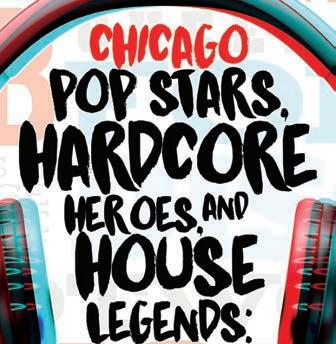
In a recent interview with Ari Mejia at CHIRP, Sputnik briefly talks about surviving leukemia as a child.

“It changed my entire life,” she says. “I felt really grateful that I had this idea that I’m not immortal.” Sputnik supercharges Waltzer’s music with purposeful drive, flooding it with all the life force at her command. —LEOR GALIL v



IN 2018 , Reader critic Peter Margasak described Jessica Risker ’s album I See You Among the Stars as “creating a warm, watery, almost womblike space.” Risker isn’t just a folk-pop artist but also a professional therapist, and her more-or-lessweekly podcast, Music Therapy, has been a bright spot in this bleak year. Recorded live on Instagram , it features conversations with local musicians, artists, and fellow therapists: Brianna Tong of Cordoba, Angel Marcloid of Fire-Toolz, and Isabel Cristina of Half Gringa discuss creativity, identity, and the music business, for instance, and Malory Dahl of the Chicago Counseling Center addresses seasonal affective disorder. Risker also uploads Music Therapy to Spotify, YouTube, Google Podcasts, and Apple Podcasts.

When local shoegaze band Diagonal dropped their 2018 debut album, Tomorrow , Gossip Wolf joked that they must have access to a time machine. Since then, the band have dropped tantalizing singles (such as “Anticipation” and “Negatives”) that look back even further, to the space rock of Hawkwind and the potent grooves of Krautrock masters Can. Both tracks appear on their new self-titled album, due Friday, February 26, via Portland label Little Cloud Records. The CD version has two bonus tracks, including the entrancing 2019 single “Detroit.”
Footwork dance collective the Era haven’t slowed down for the pandemic. In the spring, they partnered with nonprofit Masks4Chi to distribute cloth masks to locals in need (the Era delivered 4,000 themselves). They’ve also been making short dance films, including an homage to Indigenous Peoples’ Day called “Eschecagou.” On Tuesday, February 16, the Era dropped “She Pick the Speed,” a dreamy rap single produced by DJ Spinn; the crew has been “footworking with words” for about five years, and the new track spotlights their smoothness on the mike.
—J.R. NELSON AND LEOR GALILGot a tip? Tweet @Gossip_Wolf or e-mail gossipwolf@chicagoreader.com.

F b
Súle Greg Wilson banjo workshop: Songs From the African American, Caribbean, and African Traditions 2/21, 1 PM, livestream at oldtownschool.org
TALsounds 2/26, 8 PM, livestream at youtube.com/constellationchicago F b
Teenage Bottlerocket, Sack, Ray Rocket, Old Wives 3/27, 8 PM, livestream presented by Riot Fest b
Valley Maker 3/20, 7 PM, livestream at gctv.stream b
We Banjo 3 3/13, 4 PM, livestream at citywinery.com b
Peter Yarrow & Noel Paul Stookey of Peter, Paul, & Mary 10/9, 7 PM, Genesee Theatre, Waukegan b
Never miss a show again. Sign up for the newsletter at chicagoreader. com/early
Tallest Man on Earth 3/14/2022-3/15/2022, 8 PM, Maurer Hall, Old Town School of Folk Music, rescheduled; sold out
Louis Tomlinson 4/15, 8 PM, Chicago Theatre, postponed b
Vio-lence, Dysphoria, Wraith, Gavel 11/6, 7 PM, Reggies’ Rock Club, rescheduled, 17+ Stephen Wade 4/23/2022, 8 PM, Maurer Hall, Old Town School of Folk Music, rescheduled b
NEW
Phil Angotti and friends with Tony Richards 2/22, 8 PM, livestream at facebook.com/ fultonstreetcollective F b
Aniba & the Sol Starz 2/27, 7 and 9 PM, Bourbon on Division
ARC Music Festival 9/4-9/5, Union Park
David Brighton’s Space Oddity 5/7, 7:30 PM, Genesee Theatre, Waukegan b
Brit Floyd 8/5, 8 PM, Genesee Theatre, Waukegan b
Chicago Soul Spectacular 3/5, 6:30 and 9 PM; 3/12, 6:30 and 9 PM; 3/18, 6:30 and 9 PM; 3/26, 6:30 and 9 PM; 4/2, 6:30 and 9 PM, Epiphany Center for the Arts
Daybreaker presents A Joy Supreme: Dancing to Motown Magic featuring Boyz II Men, Thelma Houston, MC Lyte, and more 2/20, 10 AM, livestream; Zoom access provided with registration F b
Explosion Sonidera featuring Mega Cumbia & Grupo Aline, DJ Atomiko, DJ Papimix, DJ Julio Sierra 3/6, 6 PM, Watra Night Club
Olivia Flanigan 3/27, 8 PM, livestream at youtube.com/ constellationchicago F b
The Fray 10/16, 8 PM, Genesee Theatre, Waukegan b David Grisman mandolin workshop: Tone Poems with the Dawg 2/28, 1 PM, online workshop hosted by oldtownschool.org
Happy Together Tour featuring the Turtles, Chuck Negron, the Association, Buckinghams, Vogues, Cowsills 8/7, 7:30 PM, Genesee Theatre, Waukegan b
Intocable 9/4, 8 PM, Rosemont
Theatre, Rosemont b Ithaca Underground presents Keir Neuringer, Beau Mahadev, Jason Calhoun, Flose 2/19, 7 PM, livestream at twitch.tv/ experimental_sound_studio
F
Julian’s House Party at the Drive-In Diva Edition featuring Lisa Lisa, Sweet Sensation, Shannon, Dajae, DJ Livia, Bobby D, Mike “Hitman” Wilson, Julian “Jumpin’” Perez, and more 5/1, 5 PM, SeatGeek Stadium, Bridgeview b
Listeso String Trio 3/3, 6:30 and 9 PM; 3/17, 6:30 and 9 PM, Artifact Events, 17+ Little River Band, John Ford Coley 8/21, 7:30 PM, Genesee Theatre, Waukegan b
LP’s Happy Hour featuring Jim Becker and John Hasbrouck in conversation with Lawrence Peters 2/19, 5 PM, livestream at hideoutchicago.com
Dan McGuinness 3/20, 8 PM; 4/24, 8 PM, Carol’s Pub Mekons History: A conversation with Jon Langford, Sally Timms, and Greg Kot 3/14, 1 PM, hosted by oldtownschool.org
Vic Mensa 2/19, 8 PM, livestream at vans.com/ channel-66.html F b
Million Tongues Festival
Part 5: Celestial Earth Strings featuring Meg Baird, Bill Stone, Marissa Nadler, Jeffrey Alexander, Ash & Herb, Bill MacKay 2/21, 2 PM, livestream at twitch.tv/ experimental_sound_studio F b
New Wave 80s Digital Brunch with DJ Greg Haus 2/21, 2 PM, livestream at twitch.tv/ djgreghaus F b
Night Shade featuring Ayoo, Koshka, S3abass, Leo Vahn
2/26, 6:30 PM, Le Nocturne Chicago
Ono performs Russell Atkins‘s The Corpse 2/25, 7:30 PM, livestream at riverwestradio.com F
Option: Jim O’Rourke 3/1, 7 PM, a performance and conversation with Ken Vandermark, livestream at ess.org F b
Jeff Parker guitar workshop 2/24, 7 PM, hosted by oldtownschool.org
Camila Mennitte Pereyra
Quintet 3/13, 8 PM, livestream at youtube.com/constellationchicago F b
Red Riding Hood 2/27, 6:30 PM, Golden Triangle Retirement Party 3/11, 8 PM, livestream at audiotree.tv/ stream/retirement-party b
Riley Brothers 2/27, 8 PM; 4/3, 8 PM, Carol’s Pub
Scott Bradlee’s Postmodern Jukebox 9/30, 8 PM, Genesee Theatre, Waukegan b
The Show Goes On Online: Presenting Jazz and Improvisation During the Pandemic featuring Kurt Elling, Bryan Farina, Orbert Davis, Chris Anderson, Marguerite Horberg, Olivia Junell, and Steve Rashid 2/18, 7 PM, a panel discussion hosted by the Jazz Institute of Chicago and moderated by Jazz Journalists Association president Howard Mandel. livestream at facebook.com/jazzinchicago F
Simple Remedy 2/19, 8 PM; 3/13, 8 PM, Carol’s Pub Slackfest featuring the Slackers, DJ Chuck Wren 11/12-11/13, 8 PM, Reggies’ Rock Club, 17+
Lloyd Snyder 3/6, 8 PM, Carol’s Pub
Macie Stewart & Lia Kohl 2/19, 8 PM, livestream at youtube. com/constellationchicago
Slim Cessna’s Auto Club, Bellrays 5/7, 8 PM, Beat Kitchen, canceled
Christopher Cross 10/14, 8 PM, Genesee Theatre, Waukegan, rescheduled b
Brian Culbertson 11/17, 7:30 PM, Rialto Square Theatre, Joliet, rescheduled b
Dance Gavin Dance, Animals as Leaders, Issues, Veil of Maya, Wolf & Bear 9/21, 5:30 PM, Aragon Ballroom, rescheduled b
Iris DeMent, Ana Egge 3/21, 7 PM, City Winery, postponed b
Alan Doyle, Chris Trapper 4/29/2022, 8 PM, City Winery, rescheduled b
Get the Led Out 3/4/2022, 8 PM, Rosemont Theatre, Rosemont, rescheduled b
James Hunter Six 3/12, 8 PM, City Winery, postponed b
Lone Bellow 11/7, 8 PM, Thalia Hall, rescheduled, 17+
Moonrunners Music Festival featuring Days N Daze, Bridge City Sinners, We the Heathens, Crazy & the Brains, Tejon Street Corner Thieves, Matt Pless, Apes of the State, Suburbanists, Escape From the Zoo, Brittany Avery, Lonewolf OMB, King Strang, and more 10/910/10, 11 AM, Reggies’ Rock Club, rescheduled
Off Broadway, Handcuffs 10/16, 8 PM, Reggies’ Rock Club, rescheduled, 17+ Peach Pit, Haley Blais 5/12, 9 PM, House of Blues, canceled
Jeremy Pinnell 3/5, 8:30 PM, Carol’s Pub, canceled Sepultura, Sacred Reich, Crowbar, Art of Shock 3/14, 7 PM, House of Blues, postponed, 17+
Marty Stuart & His Fabulous Superlatives 11/21, 3 and 7 PM, Maurer Hall, Old Town School of Folk Music, rescheduled b
The Weeknd 1/23/20221/24/2022, 7 PM, United Center, rescheduled and show added b
Widespread Panic 11/17-11/19, 8 PM, Chicago Theatre, rescheduled; sold out b
Acid Mothers Temple & the Melting Paraiso U.F.O. 3/6, 7 PM, livestream at levitation-austin.com
Sebastian Bach, Stitched Up Heart 6/9, 7:30 PM, Joe’s Live, Rosemont Besnard Lakes 3/6, 6 PM; 4/3, 6 PM, livestream at subt. net b
Corky Siegel's Chamber Blues Extravaganza featuring Ernie Watts, Marcella Detroit, Lynne Jordan, Cantor Pavel Roytman, Frank Orrall, and Toronzo Cannon 3/6, 7 PM, livestream at citywinery. com b
Def Leppard, Mötley Crüe, Poison, Joan Jett & the Blackhearts 8/29, 4 PM, Wrigley Field b
Frames 9/23, 7:30 PM, the Vic, 18+ Gray Sound presents Charmaine Lee 5/11, 7:30 PM, livestream at graycenter.uchicago.edu F b
Nielsen Trust 2/24, 8 PM, livestream at audiotree.tv/ stream/the-nielsen-trust b Robin Trower 9/11, 7:30 PM, Copernicus Center b Vetiver, Meg Baird, Suzanne Vallie 2/26, 8 PM, livestream at go.seated.com b
Waltzer TV: Season II, EpisodeII featuring Waltzer, Woes, Ratboys, and more 2/25, 8 PM, livestream at noonchorus.com/ empty-bottle-waltzer-tv F b v
CHICAGOANS OF NOTE
“When I was working in politics, we always went to the community for answers. Community organizations are going to be around a lot longer than any politician.”
As told to JAMIE LUDWIG
Beth King, 44, is deputy director and director of development and communications at Intonation Music, a Bronzeville-based organization that helps Chicago youth make music on their own terms. She believes that music is community, and that community is where meaningful change starts.
Music has always meant community to me. I moved around too much as a kid.
I went to four schools for eighth and ninth grade, but I could always find somebody who abused black eyeliner like I did, which meant they shared my politics and the music I liked. When I was 13, my mom sent me from Cleveland to LA to live with my dad, but it was easy to find community around music no matter where I was living. Sometimes that was
really terrible hardcore with way too many rules and misogyny, but it all led me to get into local politics.
For most of my 20s I worked in local government in Portland, Oregon, with the most incredible mayor [Vera Katz], who taught me so much about what could be accomplished through sheer determination and creative problem-solving. I’d been scraping together a community college education, not knowing how to do anything, and knowing I would never be the smartest person in the room. The story of my life has kind of been: work as hard as possible and try and outwork everybody. I did nine years in Portland, so when I came to Chicago in 2005, it was like coming home.
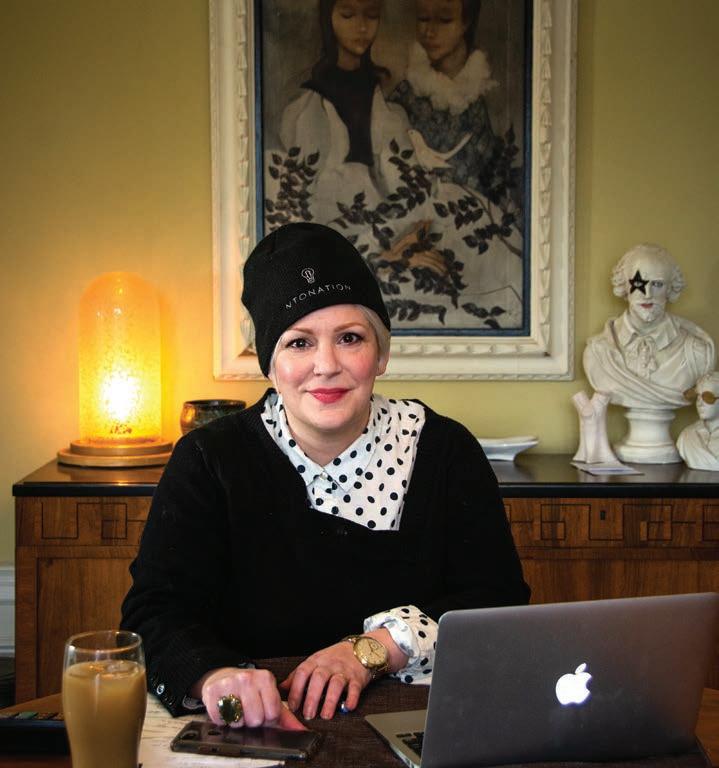
In the midwest, it’s kind of taboo to be an asshole. There’s a sense of community, and people want to do good, so you look around and see how you can help and you just hustle. I initially came here to help a friend open a gallery, and it was the purest experience of sales, buying and selling art and antiques.
My father, who is legitimately kind of a con man—when I moved in with him at 13, he was a professional gambler—was so excited. He was like, “Every job in the world is sales. You have to connect with people and make them invest in your story or way of doing things.” I always thought, “That’s gross.” But now as a fundraiser, when people ask “How the hell can you do that?” I tell them, “I’m providing people with opportunity. This is the greatest job in the world.”
I got my master’s for free while working at DePaul’s College of Education and learning how to be a fundraiser. And I was a scholarship administrator too. So I felt like Robin Hood. I was raising the money to give it away, and talking to a lot of kids who were like myself.
I didn’t get my bachelor’s till I was 28. It was wonderful to be an older student and really think about, “This is what I want to learn: how to think and research and reason.” During this time, I also allowed myself to be immersed in music as my own little private thing.
I reconnected with the founder of Intonation [Mike Simons] about three years ago. When I first moved to Chicago, I volunteered for him, working next to his father putting on
a music festival [the 2005 Intonation Music Festival]. When he told me his development director was leaving and asked if I knew anybody, I was like, “Look no further, buddy.”
Pre-pandemic, [the Intonation Music] model was to partner with schools and parks and get students to come together year-round in school, after school, weekends, and summers to form their own bands. They name the band, and they democratically pick a song that becomes their curriculum, whether that’s a Drake song, a Bikini Kill song, a Bon Jovi song, or whatever else they want. Then they learn every instrument for that song—guitar, bass, keyboards, drums, and vocals. Every student learns each one over the course of eight to ten weeks. At the end of that period, they put on a performance.
We don’t require students to learn how to read music, so it’s really playing by doing. And because they play every instrument, there’s a lot of camaraderie and peer learning and teaching. If you played drums last week and I’m playing them this week, you know how you struggled and you can help me.
All of our instructors are working musicians, and just about all of them are multiinstrumentalists, so they know how to break down a song. For younger students, the first couple of lessons might be as simple as clapping exercises to get the rhythm down. And that will turn into a drum lesson, which leads to a bass lesson, and so forth. There’s a six-toone student-to-teacher ratio, so we’re talking really small groups.
About five years ago, we decided to have a geographic focus area of Bronzeville. It’s like a hub-and-spoke model. For instance, we’re at Ellis Park, and right next door is Doolittle Elementary School, and right behind Ellis is the UChicago Charter Donoghue Campus, and a couple of blocks away is another school. So the idea is that we’re with all of those schools during the school day. And then we can do an after-school program at the parks with the same kids, and then we’ll do a summer camp there, a deep dive on weekends, et cetera.
We want those kids from third through 12th grade, because when we have those kids for years and years, the retention and the
social-emotional learning skills grow incrementally. We also create other opportunities, like all-star bands. We had our first graduating class of students two years ago. Of the five students, some had been with us since they were six years old.
When the pandemic hit, we had two big goals. One was to reach out to our families to figure out what technology they had at home and what kind of programs the students wanted while the lockdown was going on. The second was to keep every instructor working during the lockdown.
Our instructors took a deep dive into what kind of platforms we could use virtually to get the kind of collaboration that we get in classrooms and what kind of equipment would be needed for students at home. They came up with the idea that all of our students needed MIDI controllers and that we could work over this music education platform called Soundtrap. They designed this suite of pilot programs that we had up and running by early April.
We had a program called the Daily Beat, where every week there would be one song that you’d drop in and work on twice a day, three times a week. We did a video of the week, and we did an instrument ownership program, where students that had been with us for two years were sent a new guitar, bass, or keyboard.
Our donor committee community has been incredible. Our costs obviously went up to do this, but since the summer, every one of our students has received a MIDI controller of their own, which allows them to play every single instrument and record it and produce it and share it with their classmates. We have lost some enrollment because CPS and the Chicago Park District are our biggest partners. But I can’t even express how needed any kinds of arts education is for students right now.
I can’t imagine being a student and not being able to get out of my house or have my own people and creative outlets for all the emotions you go through as a teenager. It’s great to have something where you don’t necessarily need to put that into words.
The communities we serve are majestic— it’s been the greatest privilege of my life to get to work in Bronzeville and get to know its history and community—but they are incredibly divested of arts and education resources, among other things. This city is deeply segregated, and so many Chicagoans don’t know much about Bronzeville. But what this neighborhood has contributed to American music is insane.
I work at Kennicott Park, which is at 4400 S. Lake Park. That’s half a block from Muddy Waters’s house. I can walk to Louis Armstrong’s house. I can also walk to the Harold Washington Center, which used to be the Regal Theater, which opened eight years before the freakin’ Apollo. And the Regal was where Aretha Franklin was crowned the queen of soul. There’s also Curtis Mayfield and Chaka Khan and the Staples Singers, and that’s just music.
It gets really exciting for me when I get to be in a building in Ellis Park, and know Otis Rush grew up across the street. Whether or not our students know who the heck Otis Rush is, that’s shared soil. Our students are so amazingly talented, and when I see them onstage, knowing they are a part of this legacy of changing the way modern music sounds is exciting.
It’s also exciting on a grander scale. Not everybody is going to be a Chaka Khan or a Curtis, but they might get a moment to see a path forward. They might get recognition for these gifts, and that opens up worlds. If nothing else, it provides immediate community and recognition around this thing that moves us all, which is music.
When I was working in politics, we always went to the community for answers. Community organizations are going to be around a lot longer than any politician. I’m not shading any hardworking politicians, but when I get to speak with the people in the community of Bronzeville, those are the people that are making real change. It’s not some mandate from someone up on top. And that’s something I think punk rockers have always known. You want a festival, you do it yourself.
Book Club members receive an additional 10% off at the following stores:
The Book Cellar | 4736 N. Lincoln 60625 773-293-2665 | bookcellarinc.com
Bookie’s | 10324 S. Western 60643 312-890-3860 | bookiesbookstores.com

Bucket O’Blood Books and Records | 3182 N. Elston 60618 312-890-3860 | bucketoblood.com
The Dial Bookshop | 410 S. Michigan, 2nd Floor 60605 dialbookshop.com
Madison Street Books | 1127 W. Madison 60607 312-929-4140 | madstreetbooks.com
Pilsen Community Books | 1102 W. 18th St. 60608 312-478-9434 | pilsencommunitybooks.com
Roscoe Books | 2142 W. Roscoe 60618 773-857-2676 | roscoebooks.com
Semicolon | 515 N. Halsted 60642 312-877-5170 | semicolonchi.com

Seminary Co-Op Bookstore | 5751 S. Woodlawn 60637 773-752-4381 | semcoop.com
Volumes Bookcafe | 1474 N. Milwaukee 60622 773-697-8066 | volumesbooks.com
Women & Children First | 5233 N. Clark 60640 773-769-9299 | womenandchildrenfirst.com
This yearlong partnership with independent bookstores is supported by the Poetry Foundation.



Mikki Kendall Hood Feminism: Notes From the Women That a Movement Forgot Book Club Month:
October 20
Author Talk: 10/22/2020
Sonali Dev Recipe for Persuasion
November 20
Natalie Moore
The South Side
April 21
4/22/2021
Rebecca Makkai
The Great Believers
May 21
5/27/2021
Fatimah Asghar If They Come for Us
Dr. Eve L. Ewing is a sociologist of education and a writer from Chicago. She is the awardwinning author of the poetry collections Electric Arches and 1919 and the nonfiction work Ghosts in the Schoolyard: Racism and School Closings on Chicago’s South Side. She is the co-author (with Nate Marshall) of the play No Blue Memories: The Life of Gwendolyn Brooks She also currently writes the Champions series for Marvel Comics and previously wrote the acclaimed Ironheart series, as well as other projects. Ewing is an assistant professor at the University of Chicago School of Social Service Administration. Her work has been published in The New Yorker, The Atlantic, The New York Times, and many other venues. Her first book for young readers, Maya and the Robot, is forthcoming in July 2021.
Maudlyne Ihejirika is an award-winning Chicago SunTimes urban affairs columnist with 30 years of experience in journalism, public relations, and government.

Building on a B.A. in journalism from the University of Iowa and an M.S.J. from Northwestern University’s Medill School of Journalism, Ihejirika’s work in state government and media has resulted in countless achievements, including serving as president for both the National Association of Black Journalists Chicago Chapter and the Chicago Journalists Association; ranking one of “The 25 Most Powerful Women In Chicago Journalism” in 2019; publishing her book Escape From Nigeria: A Memoir of Faith, Love and War; and launching Ihejirika Media & Communications Group to manage media for members of U.S. Congress, Illinois Legislature, and City Council. Her awards include the Studs Terkel Award, national and local awards from the Society of Professional Journalists and National Association of Black Journalists, and several civic awards, including the Chicago Defender Woman of Excellence and African Festival of the Arts Community Servant Award. Ihejirika is a frequent guest contributor on PBS-TV’s “Chicago Tonight: Week In Review” and FOX-32’s “Good Day Chicago,” and she has appeared as a political analyst on CNN, TV One, ABC, CBS, NPR, WBEZ, WVON, and V103.
She currently pens the Sun-Times “Chicago Chronicles,” long-form columns offering diverse narratives and untold stories of inspiring people, places, organizations, and issues in Black and Brown communities. Follow her at @maudlynei on Facebook, Twitter, and Instagram.
Presented by:
11/19/2020
Riva Lehrer Golem Girl
December 20
12/17/2020
Emil Ferris
My Favorite Thing Is Monsters
January 21
1/28/2021
Eve Ewing 1919
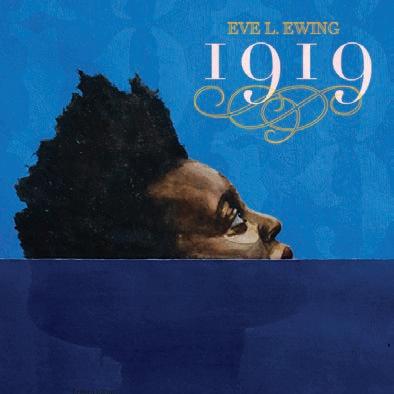

February 21
2/25/2021
Nnedi Okorafor Remote Control
March 21

3/25/2021
Presented by:
June 21
6/24/2021
Kayla Ancrum
Darling
July 21
7/22/2021
Jessica Hopper (TBD)
August 21
8/26/2021
Precious BradyDavis I Have Always Been Me: A Memoir
September 21
9/23/2021
Book Club membership includes: Exclusive access to conversations between Authors and the Reader Discounts to your favorite independent bookstores

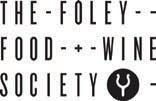

A curated monthly newsletter

A membersonly discussion forum Special offers from Reader partners

Q : I’m a gay guy living in New York in his late 20s. My boyfriend has really been emotionally impacted by the pandemic having been a frontline worker. I think he is suffering from some mild depression or at the very least some intense anxiety so I just want to preface this by saying I completely sympathize with what he’s going through. Before the pandemic we had a really good sex life, but lately he hasn’t been interested in sex at all besides a few assisted masturbation sessions. While I know that
these aren’t usual times, I can’t help feeling rejected. Normally, I would suggest opening up the relationship, for the sake of both myself and him, and I think that he might benefit from having sex with some guys where there isn’t an emotional investment. Of course, right now that isn’t an option. I want to be there for him and we otherwise have a solid relationship, but this issue has been making me feel hurt. I’ve encouraged him to masturbate without me but I do wish he could include me more in his sexual life. Do
you have any other thoughts or advice? —THANKS FOR READING
A : As much as I hate to give you an unsatisfactory answer, the only way to find out whether his loss of libido is entirely pandemicrelated, TFR, is to wait out the pandemic and see if your sexual connection doesn’t rebound and/or if opening up the relationship is the right move for you guys as a couple. But if you suspect the collapse of your boyfriend’s libido has more to do with what he’s witnessed and
endured as a frontline worker than it has to do with you or your relationship, TFR, therapy will do him more good than sleeping with other guys or masturbating without you. Urge him to do that instead.
Q : My dad is dying. He had a stroke two days ago and is in a coma with no brain function. My aunt (his sister) is trying to make me feel guilty for not traveling to see him. Even though I’m pregnant and high risk. I would have to take an airplane across the country and multiple public buses to see him. I would have to risk my baby’s life to say goodbye to a man I love with all my heart. She insists that if I don’t, I didn’t love my dad. I’m heartbroken. I keep calling his hospice and they set the phone next to his head so I can talk at him. He was so excited about my pregnancy, and I know he would not want me to risk it. But now not only am I grieving my father, I feel guilty and selfish. Am I right to be angry? My aunt’s brother is dying. She’s sad. Everyone is sad. But this is not the first time she has used guilt to try and control others in moments of trauma. —CRYING
A : There has to be someone in your life who would be willing to step in and tell your aunt to go fuck herself. If there isn’t, COMA, send me your aunt’s phone number. You have every right to be furious with your aunt for giving you grief when you have all the grief you can handle right now. Don’t get on that plane. And if your aunt never speaks to you again, COMA, just think of all the guilt trips she won’t be able to drag you along on in the future.
Q : I am a 26-year-old heterosexual girl. A er four years with my boyfriend (and
with the pandemic on top of it), we started to experience sex issues. It is mainly from my side, I (almost) never get satisfaction out of sex. I’m always enthusiastic about having sex but I don’t feel “involved” and I could literally be solving math problems in my head while we have sex. As the situation is frustrating, I talked to him and suggested that more foreplay could help me stay engaged and enjoy the sex. He was puzzled by my “need for foreplay” to reach orgasm but committed to trying. However, a er minimal initial effort, he stopped trying and the limited foreplay ceased. He probably got frustrated by the amount of time I require to “warm up” and his efforts dried up and he began rebuffing me whenever I attempted to initiate sex. Recently a er he turned my sexual advances down yet again, I decided to masturbate. The result was him being upset and taking offense at my “unpleasant behavior.” Should I feel guilty about masturbating when he turns me down? I am hurt and very frustrated by this situation.
TURNS HARSH
A : Allow me to decipher the message your pussy is desperately trying to send you, MATH, as you lay there doing math problems while your boyfriend treats your body like it’s a Fleshlight: “Wouldn’t you rather masturbate alone and in peace than ever have to fuck this asshole again?”
Everyone requires a little foreplay, women require more than men do, it takes women longer to get off than it takes men (five minutes on average for men, 13 minutes on average for women), and very few women can climax from vaginal intercourse alone. Any straight guy who isn’t willing to do the
work—provide the necessary foreplay and come through with the non-PIV stimulation or concurrent-with-PIV stimulation required to get a woman off—doesn’t deserve to have a girlfriend. DTMFA.
Q : I’m a 53-year-old gay man and I’ve never been hornier in my life. I really need to guzzle about a quart of jizz right now. I haven’t been dating anyone and the COVID isolation has intensified my loneliness but it’s the lack of D that’s driving me to distraction. The last time I sucked a dick was the a ernoon Los Angeles began its first shutdown. Here’s the thing. I just had the first dose of the vaccine, and the second is scheduled in a couple weeks. Is it safe to suck someone’s dick who has also had the vaccine? Everything I found on Google only talks about how the vaccine may affect pregnant women. What about us cum whores? —GOT THE FEVER FOR THE FLAVOR

A : Where have you been? I predicted at the beginning of the pandemic that we were entering a new golden age of glory holes. Two months later the New York City Health department was recommending “barriers, like walls, that allow sexual contact while preventing close face-to-face contact,” aka glory holes—and that was the harm-reduction advice given by health professionals long before vaccines became available. Seeing as you’re vaccinated, your risks are going to be lower. But to play it safe: build your own glory hole, invite a guy over, tell him to keep his mask on, and avoid close face-to-face contact by staying on your knees on the other side. v
Send letters to mail@ savagelove.net. Download the Savage Lovecast at savagelovecast.com. @fakedansavage
My boyfriend’s libido has collapsed Guilt trips, glory holes, and being there for those you love right now
JOBS
ADMINISTRATIVE
SALES & MARKETING
FOOD & DRINK
SPAS & SALONS
BIKE JOBS
GENERAL REAL ESTATE RENTALS FOR SALE
NON-RESIDENTIAL ROOMATES
MARKETPLACE
GOODS
SERVICES
HEALTH & WELLNESS
INSTRUCTION
MUSIC & ARTS
NOTICES
MESSAGES
LEGAL NOTICES
ADULT SERVICES
QA Automation Engineers to both lead and collaborate in cross-functional team environments, using modern Agile software development methodologies to develop, test, integrate & coordinate software development to support roll out of nextgen products. Lead positions req. MSc in Comp Sci/Engr or related + min. 3 yrs expr. or BSc. + min. 5 yrs. expr. or equiv. combo. Team members require MSc in Comp Sci/Engr or related + 1yr expr. All req handson development expr with JAVA/J2EE, Agile/ SCRUM, coding & testing in C#, Python & automating ETL programs; writing SQL Queries & w/web-services testing skills. JAVA Developers to develop, create and modify software that will integrate with external databases, in cross-functional teams, using industry best practices to implement scale-able applications and databases that support business processes. May req MSc in Comp Sci/Engr or related, or equiv + min 2 yrs expr; or may req BSc +3 yrs expr. All must have background in object-oriented languages, coding & testing, automating ETL programs, writing SQL Queries& web-services testing. Informatica, Maven, Jenkins, JIRA, GIT, BITBUCKET or similar tools & familiarity w/AGILE/SCRUM development process & black box testing needed. Send apps to HR Manager, Levio Consulting Inc., 55 E Monroe Street #3800, Chicago, IL 60603.
HRG Realty Management LLC seeks Maintenance/Repair Coordinator in Evanston, IL. Plan, schedule, and coordinate general maintenance, major repairs, and remodeling or construction projects for senior living residential property. Bachelor’s degree and 24 months related experience required. Mail resume to Attn: David Sherman, 1946 W. Lawrence Ave., Chicago, IL 60640.
SALES: Kraft Heinz Foods Company seeks Associate Director, Sales to work in Chicago, IL & manage relationships w/key retailers working w/field sales & category marketing for Kraft Heinz frozen portfolio. Degree & commensurate exp. req’d. Apply online by searching R-34858 at kraftheinz. avature.net/careers/ SearchJobs.
ANALYTICS LEAD
Affirm, Inc. has job opp. in Chicago, IL: Analytics Lead. Prfrm quantitative analysis on co.’s loan portfolio. Mail resumes refernc’g Req. #AYL60 to: 650 California St., 12th Floor, Attn: K. Lukaszewski, San Francisco, CA 94108.
Senior Financial Analyst needed by PEAK6 Group, LLC in Chicago, IL to develop, implement & analyze enterprise-wide financial planning design, strategies, policies & campaigns. Reqs Master’s or foreign equiv in Finance, Accounting Sci. or related field & 2 yrs exp as Accountant. Reqs CPA license & completion of CFA Level I Exam. Exp must include data migration for accounting ERP sys. & exp. in NetSuite, QuickBooks, Adaptive, Excel, Visual Basic for Application, Java & SQL. To apply, mail resume to L. Moore, PEAK6 Group, 141 W Jackson Blvd, Ste 500, Chicago, IL 60604.
(St. Charles, IL) Nidec Mobility America Corporation seeks Software Validation Engineer I w/ Bach or for deg equiv in EE, Electron Eng, CE, Vehicle Eng, or rltd fld & 1 yr exp in job offered or analy cust reqs & transf flow charts & state diagrams to create test cases incl 1 yr exp w/ comm-used concpts, pract & proced of auto protoc; 1 year experience applyng control method to develp control strat realiz in real vehic environ; 1 yr exp eval simul in Matlab/Simulink & also on Hardware-in-the Loop (HIL) Simulator; & 1 yr exp w/ trad vehic, battery electr-vehic (EV) hybrid electric vehic (HEV) & fuel cell electric vehic (FCV). Apply to HR, 3709 Ohio Ave, St. Charles, IL, 60174
TECHNICAL
Cisco Systems, Inc. is accepting resumes for the following position in Chicago, IL: Network Support Supervisor (Ref#:CHI071A): Assist and direct diagnosis and troubleshooting of wireless, security, switching, and other various network-related issues reported by customers and partners to Network Support Engineers. Please mail resumes with reference number to Cisco Systems, Inc., Attn: G51G, 170 W. Tasman Drive, Mail Stop: SJC 5/1/4, San Jose, CA 95134. No phone calls please. Must be legally authorized to work in the U.S. without sponsorship. EOE. www.cisco.com
Coffee C. Café, Chicago, IL, seeks Accounting Specialist. Duties incl: Process financial statements for corp accounts. Set up acct. systems for biz units to streamline reporting. Process sales tax returns & monthly retail sales tax. Process payroll in compliance w/tax law & payroll tax returns. Annual filing of corp income tax returns. Reconcile or note and report discrepancies. Gen’l office duties: Fill in shifts as needed. BS/BA in accounting, biz admin, or rel’d & at least 2 yrs of work exp. in a corp role req’d. Send resume & refs to HR, c/o Coffee C. Café P.O. Box 791, Wilmette, IL 60091.
Loyola University
Chicago is seeking a Research Assistant Professor in Maywood, IL to Perform activities rel to work investigating mechanisms by which enteropathogenic Escherichia coli disrupts intestinal epithelial tight junction under the supervision of researcher. Pls send resume to Gail Hecht (ghecht@luc.edu) & ref job #021477.
Loyola University
Chicago is seeking an Enterprise Architect in Chicago, IL to research & analyze basic & complex issues surrounding the technologies & systems of the institution, making recommendations surrounding improving technologies, cost effectiveness, efficiency & practices at an enterprise level across the institution. Pls send resume to Jim Sibenaller, Jsibena@ luc.edu & ref job 120183.
Syndigo LLC seeks QA Analyst in Chicago, IL for cust. rqmts procsg & test doc devlpmt. ISTQB Cert. reqd. Telecommute avail. Mail resume to Syndigo Attn: Randall Kooistra 141 W Jackson Blvd Ste 1220 Chicago, IL 60604
Exhibit Manager – Coordinate booth/demo equip for trainings/ workshops worldwide; manage logistics with NA and Euro teams; comms w/ vendors and contractors; on-time booth set-up & dismantling, incl work stations; plan demo systems with Ops and Support teams; coordinate special demo equip (microscopes, ultrasounds, C-Arms) and manage demo agenda; tech consultation re product displays; control budget; ensure cost saving w/ contractors and services; booth compliance with Corp Identity/Values; work w/ Event Mgrs re Marketing info flow; work w/ Prod-
uct Mgrs re appropriate display; work w/ Mktg Comms Mgrs/Designers re product messaging and graphics; comms w/ organizations, booth contractors, service providers; troubleshoot during exhibit hall (installation, exhibit, and dismantle); coord logistics f portable program and main booth; visualize booth concepts with 2D/3D software (tech drawings, cable plans, graphic placements). 50% natl/ internatl travel. Reqd: BS in Biz Admin; 3 yrs exp in event/tradeshow planning; 1 yr exp with Sketch up 3D modeling software. Exp may be concurrent. Must have perm US work auth. Contact N. Bandukwala, HR, Brainlab, Inc., 5 Westbrook Corp. Ctr., Ste. 1000, Westchester, IL 60154.
K042088 - Spraying Systems Co. is seeking a Field Service Engineer in Lehi, UT and Glendale Heights, IL with the following requirements: BS degree in Technical Systems Management, Engineering or related field or foreign equivalent degree. 2 years of related experience. Required skills: provide technical information and troubleshooting assistance on electro-chemical application equipment and hydraulic spraying apparatus to customers, sales representatives and vendors (2 yrs); investigate customer complaints or requests on agricultural chemical spraying applications, sprayer plumbing and precision farming solutions and report results and recommendations (2 yrs); create product support documentation and technical support literature related to agricultural nozzles, boom components, valves, spray wands and strainers (2 yrs); set up, perform and report on spray pattern distribution using Schachtner liquid patternater and Kaiser Controls Opto 22 program and spray droplet size measurements using Oxford Laser Visi-sizer Imaging Analyzer (2 yrs). Company headquarters located in Glendale Heights, IL. 50 % TRAVEL REQUIRED; MUST LIVE NEAR A MAJOR AIRPORT IN THE NORTHWESTERN U.S. Send resume to resume@ spray.com.
TransUnion, LLC seeks Consultants for Chicago, IL location to create & maintain sw applications & automation frameworks. Master’s in Comp Sci/Comp Eng or Info Tech/ Systems, or any Eng. Field + 2yrs exp. or Bachelor’s in Comp
Sci/Comp Eng or Info Tech/ Systems, or any Eng. Field + 5yrs exp. req’d. Req’d skills: exp deploying & releasing server-hosted software solutions, bitbucket, Confluence, Version control, Powershell, Jenkins, TFS, .NET, CI/ CD Pipelines, Azure, issue tracking, Linux, Python, JavaScript. 20% telecommuting permitted. Send resume to: A. Goodpasture, REF: NS, 555 W Adams, Chicago, IL 60661
Actonia, Inc. seeks IT Project Managers for Chicago, IL to lead complex IT projects. Master’s in Comp Sci/ related field+2yrs exp OR Bachelor’s in Comp Sci/ related field+5yrs exp req’d. Req’d Skills: software quality assurance; analyzing large datasets; managing IT sales teams; Java; C; SQL; SSIS; Linux Operating Systems. Send Resume to hr@actonia. com, Ref: SML
Software Engineer(s) Chicago, IL - Develop & implement object-oriented n-tier software applications, including webbased applications. Mail resume to Anna McGinty at RedMane Technology LLC, 8614 W Catalpa Ave, Ste. 1001, Chicago, IL 60656. Must reference job code VR68. E.O.E.
Light-filled 1bdrm, 1 bath condo freshly painted with hardwood floors, exposed brick, gas fireplace, w/d in unit, fitness center and inbuilding secure parking. $1775/mo. 773-4501022; konajules@gmail. com


Spacious 1BR condo at Lincoln Park. $1195. Water, Heat and Cooking gas included. Laundry on site. Storage space. Close to shopping, CTA and Lake. (224)8041391
Lake House For Rent @ BASS LAKE, Indiana: 1bdrm (9X11), 1 bath (handicap),eat in kitchen,LVRM, Forced air heat & AC, Stove, Frig, Microwave, Paved driveway, Pier, view of lake, No Pets, You pay utilities, $600m + $600 security, 1 year lease. Call 574-806-1049 for video & pictures.
Information in the Right Hands is a Powerful Thing. Save the link you might need it someday https://culper.us/en/ about-us/
CLEANING SERVICES
CHESTNUT ORGANIZING AND CLEANING SERVICES: especially for people who need an organizing service because of depression, elderly, physical or mental challenges or other causes for your home’s clutter, disorganization, dysfunction, etc. We can organize for the downsizing of your current possessions to more easily move into a smaller home. With your help, we can help to organize your move. We can organize and clean for the deceased in lieu of having the bereaved needing to do the preparation to sell or rent the deceased’s home. We are absolutely not judgmental; we’ve seen and done “worse” than your job assignment. With your help, can we please help you? Chestnut Cleaning Service: 312-332-5575. www. ChestnutCleaning.com
COUNSELING & PSYCHOTHERAPY
Danielle’s Lip Service, Erotic Phone Chat. 24/7. Must be 21+. Credit/ Debit Cards Accepted. All Fetishes and Fantasies Are Welcomed. Personal, Private and Discrete. 773-935-4995
EROTIC PHONE CHAT

Sexy Singles, Sweet Coeds, Hipster Gals. Only .99c. 800-Sexy Gal; 800-739-9425. HARDCORE ADULT
TALK! Busty Babes, Ebony Hotties, Older Ladies. 866-515-3699, only $10 per call.
MOVE IN AFTER WE GET TO KNOW EACH OTHER 50 w m iso 30/45 f 420 friendly dog owner, NON LIBERAL, possible job as well. chicagohomegrown420@ gmail.com
Be found by the perfect partner
In India, from being a person who has to do the hard work of finding and screening, we’ve made the candidate feel special by being the one who is found. (MITDAD057) 826-104-2902
A hot fun one night stand? call 24 7 Fun cool clean single white male ...Call for pics 773-977-8862
House For Rent @ BASS LAKE, IN: Newly renovated 3bdrm, 1 bath, eat in kitchen, stove,Frig, fireplace, yard, Pier, view of lake, you pay utilities, 1 year lease, $875m + $875 security. Call 574-8061049 for video + pictures.
WANT TO ADD A LISTING TO OUR CLASSIFIEDS?
Email details to classified-ads@chicagoreader.com
IN THESE DIFFICULT TIMES we need not isolate. If you are feeling overwhelmed, stressed, anxious, or depressed we can talk. I can help you better understand these situations and create solutions for them. My practical approach entails a therapeutic alliance that is affirming, empathic, and interactive. To talk contact Michael J. Bland, Psy.D., LCPC. Northside location. 773-404-8161. Michael@BlandTherapy. com/www.BlandTherapy. com
Master Older Sub Female married white master 52 seeks older sub female who needs discipline pleasure and punishment will Train I can host and seeking discreet LTR can em dragonmastercs69@ gmail.com 224-292-9899
Submit your Reader Matches ad today at chicagoreader. com/matches for FREE.
Matches ads are not guaranteed and will run in print and online on a spaceavailable basis.
































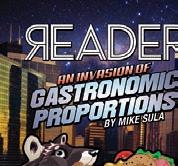














Join our community supported shery to reserve your share of our harvest. You’ll get a seasonal assortment of sh and crustaceans harvested just for you! Your share is delivered directly to your door every month you’re enrolled with stories from the shing grounds and mouthwatering recipes you’ll love.


ta ke $25 off your first premium si tka seafood share month with cod e chireader25 Expires 7/31/2021























Our small-boat shermen harvest with care using low-impact gear. Your wild seafood is meticulously handled from the moment it’s plucked from the frigid North Paci c waters, immediately iced, hand- lleted, and blastfrozen for sashimi-grade quality and fresh-from-the-ocean avor (yum)!


We always pay our shermen above-dock prices, which allows them to harvest like craftsmen and deliver the highest quality. We guarantee our sh is traceable to the source, so you know exactly where it comes from. And we donate 1% of revenue to causes preserving the wild. That’s sh you can feel good about.
 Blast-frozen at the source for a fresh taste!
Responsible seafood direct to your doorstep!
Blast-frozen at the source for a fresh taste!
Responsible seafood direct to your doorstep!
Oyez, oyez! After nary a three month hiatus, the Chicago Foodcultura Clarion rings out again. This time for its penultimate number, to be distributed once more across Chicagoland in a 2700 copy print run as an insert in the Reader. Not that any of the authors or editors of issue number one ever managed to get a hold of a properly inserted copy! So count yourself lucky if you did, or could make a sandwich wrapper out of it, as per our instructions. But now watch out for the new one in your neighborhood Reader box!
For those who missed the first issue, let me explain. The Chicago Foodcultura Clarion grew out of a collaboration between the Barcelona/Miami-based pioneer of food art Antoni Miralda and the University of Chicago anthropologist Stephan Palmié. Under the generous auspices of a Mellon Foundation grant awarded to them by the University of Chicago’s Richard and Mary Gray Center for Art and Inquiry, Miralda and Palmié taught an experimental course entitled “Foodcultura: The Art and Anthropology of Food and Cuisine” in the fall of 2019. Together, the two of us sent our students out on ethnographic missions into Chicago’s wonderfully variegated food worlds. A number of their projects will be presented in this issue of the Clarion. But before editorializing about the cornucopia of Chicago food writing and imaging that awaits you in this issue, gentle reader, let me tell you a story. It is about romance, twentieth century intellectual history, and—you guessed it—food. But let me first thank Hazal Çorak who alerted me to what you are about to read.

On a cold February afternoon in 1947, Nelson Algren, then on the cusp of a literary breakthrough, took the El to the Loop to meet Simone de Beauvoir in the Palmer House Hilton’s Le Petit Café. On her first trip to America, de Beauvoir had encountered Algren’s long-time friend Richard Wright in New York, and Wright and Mary Guggenheim (who made the contact) suggested that she meet him once in Chicago. As is well known—indeed, the Reader carried a good story about it some years ago—it was the start of a passionate (but mostly long distance) love affair that lasted until a somewhat bitter end in 1964. We also know that the evening of that February day in 1947, de Beauvoir’s soon-to-be “beloved Chicago man” took her on A Walk on the Wild Side through the Neon Wilderness of W. Madison Avenue (known as Floptown since the 1920s) and to a number of serious dives: the kind that The Chicago School of Sociology had been studying ethnographically under the direction of Robert E. Park since the mid-1920s (resulting in such memorable ethnographic—now historical—documents on a Chicago that has ceased to exist like Paul G. Cressey’s dissertation “The Taxi Dance Hall,” Paul C. P. Siu’s on “The Chinese Laundry Man,” Frederick Thrasher’s The Gang, or Nels Anderson’s The Hobo). What we do not know is where and what Algren and de Beauvoir ate for dinner that evening. We can speculate on hearty Polish fare or the skimpy bar food that used to be offered for free to happy hour drinking patrons. As de Beauvoir later recalled, afterwards they repaired to his “hovel without a bathroom or a refrigerator, alongside an alley full


FRUITS OF ANTH 25320 2-3 A Tale of Two Tapas Bars: El Internacional and Café Ba-Ba-Reeba! at the Dawn of Small Plates America, el amanecer de las tapas
4 A Bowl of Nostalgia, or Discrimination: Korean-style Chinese Food in Chicago's Koreatown 5 La Chaparrita, ANGELINA, La Dama Blanca, and César the TAquero
6-7 Chicago Hot Dog Places: A Fading Art 8-9 Blood Buttons: A stockyards fashion trend revival 9 THE GIFT OF Raccoon 10 TABLE SCRAPS 11 Love Food in the Time of Covid-19 11-12

of steaming trashcans and flapping newspapers.” Good existentialist that she was, to de Beauvoir, this seemed “refreshing after the heavy odour of dollars in the big hotels and elegant restaurants, which I found hard to take.” Years later, de Beauvoir (of all people!) wrote Algren that she’d even cook and clean for him. Imagine that! The Man with the Golden Arm and The Second Sex—two books rarely mentioned in one sentence (shouldn’t they?)—appeared two years later.
Such are the known unknowns, as former Secretary of State Donald Rumsfeld once so memorably put it. But, we can have a guess as to that dinner in the winter of 1947. In part this is so because before Algren attained national and international fame as a writer (Hemingway rightly called him the American Dostojevski), this grandson of a contrarian Swedish immigrant who converted to orthodox Judaism in New York and (much to the chagrin of his family) took to itinerant prophecy soon after, earned his first spurs in the context of the New Deal WPA Federal Writers Project. From its inception under the New Deal in 1935 to its shameful destruction by the House Committee on Un-American Activities in 1943, the Federal Writers Project employed thousands of writers, artists, and professionals who had lost their jobs in the publishing industry. Next to Algren, who joined the FWP in 1936, its Chicago office staff alone included Saul Bellow, Arna Bontemps, Jack Conroy, Katherine Dunham, Studs Terkel, Margaret Walker, and Richard Wright—a veritable who’s who of youthful Chicago artists who would soon be propelled to national and international renown. A major focus of their work was the Illinois version of the 48 state guides the FWP was compiling, but other projects in which Algren was involved included “industrial folklore,” for which he interviewed barflies, gamblers, prostitutes, loan-sharks, drug dealers, boxers, addicts, petty criminals, and other characters in the bars, pool halls, and brothels of “the sleaziest skid row district of Chicago” (as his friend and FWP colleague Jack Conroy later recalled). Elements of these interviews often found their way into Algren’s novels and short stories in virtually verbatim form—a poetic ethnography of the multi-ethnic, multi-racial underclass that had formed in cities like Chicago, the kind of “lumpen” that Algren, more so perhaps than any American author at the time, so successfully strove to humanize—in their own language. But Algren also worked on the Midwestern version of the FWP’s “America Eats” project, whose stated goal was to “produce a series of regional guides describing immigration, settlement and customs as these factors related the universal language of food.” The results, however, remained unpublished at the time.
Fast forward to the 1970s. Algren whose literary fame had sadly faded by then, was going through a rough patch and held a silent auction in his apartment on Evergreen Street. As Chicago’s first genuine celebrity chef and friend (Continued on p. 2)
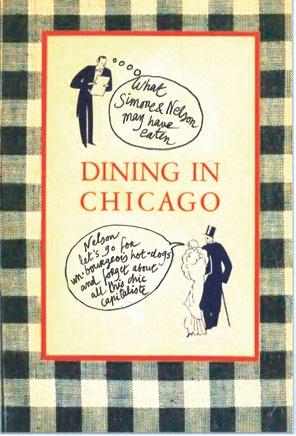
of Algren’s, Hungarian born Louis Szathmáry, recalled, he immediately spotted a typescript entitled “Am. Eats. Algren”, took a quick look at it, decided that he had to have it for his collection, and placed a winning bid (Szathmáry was a monomaniacal cook book collector whose vast library is now housed at the University of Iowa). Algren turned to him and said “Lou, are you crazy? You are bidding too much for that manuscript. The recipes in it are lousy. It was a government writers project. I did it because I needed the money.” After Szathmáry had taken a closer look, he had to agree: “I told him that some of them were easy to follow, others sketchy, and a few impossible: for instance, the Flemish booya—60 gallons, with 30 pounds of oxtail, 10 pounds of beef soup bones, 4 fat hens and half a bushel of tomatoes”. Algren laughed. “He said the book was his but the recipes were not. He had collected them from various sources— housewives, farmers, sailors, tavern owners, greasy-spoon cooks—and wrote them down as best he could. He wished me luck in case I really wanted to do something with them.” Which Szathmáry eventually did. After having cooked and re-written most of the recipes, he published America Eats in the University of Iowa Press’s Iowa Szathmáry Culinary Arts Series in 1992.
More a poetic evocation of waning rural foodlore written in New Deal populist style than an ethnography of the rapidly changing Midwestern foodways of the 1930s, America Eats nonetheless is a remarkable document of the diversity of ingredients that were then about to merge into the chunky stew of Midwestern cookery: from Native American, French colonial, American homesteader, and African American elements, to contributions from Scandinavian, German, Polish, Russian, Belgian, Italian, Jewish, Hungarian, Serbian, Spanish, Lebanese, Mexican, and Chinese immigrants. “Such a cauldron” Algren writes, “would come to contain more than many foods; it would be, at once, a symbol of many lands and a melting pot for many peoples.” America Eats also gives us glimpses into the transformation of immigrant tastes, no doubt under the impact of the rapid industrialization of American food, then already under way for a considerable time. Of the Serbians in Libertyville and elsewhere, Algren tells us how “the parents are used to a well-organized and well-seasoned meal, but the children prefer mostly fried food, sandwiches, sweets and cold soda water…sitting at the same table with their children and holding in their hands sizeable chunks of barbecued lamb, the parents look at their American-born children in wonder and dismay, unable to understand an attachment to cold sodas and hot dogs eaten together.” Clearly, even as Algren penned these lines, fast food was dawning on the horizon.
Curiously, what Algren doesn’t tell us is what his fellow Chicagoans in West Town, River North, Bronzeville, Backof-the Yards, The Delta, Bridgeport, or other working class neighborhoods were eating. That, one would have to extract from his novels—a splendid task for an aspiring future culinary historian. But it brings us no closer to the question of what Algren and de Beauvoir might have eaten on their first date that winter day in 1947. Perhaps it was a steaming bowl of barszcz with uszki, or golabka studded with kielbasa and other smoked meats. Perhaps a plate of chop suey (America Eats lists a recipe for “tin suin pai kwe” or “pork with sweet-sour sauce”) or chow mein whose slightly outré turn of the twentieth century reputation had worn off by then. Perhaps a couple of tamales, which, as Peter Engler demonstrated in the last issue of the Clarion, had become a fixture of Chicago’s nightlife long before 1947. Chicago’s first pizza joint had emerged on W. Taylor Street by 1924, and indeed, when de Beauvoir returned to Chicago in May, Algren took her to Little Italy for pizza and chianti. But that evening in February, Simone and Nelson may well have simply wolfed down some hot dogs—which by that time, had assumed their characteristic “Chicago-style” seasonings and fixings: no ketchup, never! – before they retreated to their love nest for the night.
Further research may help to solve that riddle, but as for me, I am now happy to turn to the contents of this issue of the Clarion Falling, as this issue does, into the first days of Lent, we prepared for you what 19th century Catholic immigrants to Chicago from Germany’s region of Suebia would have called a “Herrgottsb’scheisserle” (little Good Lord cheater) or more properly “Maultasche” (mouth pocket), the latter term designating a large, raviolo-like stuffed pasta, the former describing its function: hiding morsels of ground meat mixed with spinach between two layers of pasta dough so God wouldn’t become aware of one’s sinful culinary delight. What we have for you, in other words, is a clandestine feast, hidden, as always, between the covers of the Chicago Reader. This time, the ingredients are student projects on upscaled home cooking and street food, and ofrendas for the día de los muertos in Pilsen; an anthropological meditation on Korean Chinese comfort food, nostalgia, and racism; an interview with the owner and cook of a Little Village taquería that doubles as a shrine to La Santa Muerte; an essay by the foremost historian of the Chicago hot dog; another one on a historic raccoon feast; yet another on the “blood buttons” once produced at the Chicago Stockyards, and still one more on our artistic director, Miralda’s role in bringing tapas to the U.S.; there is work by artists Patty Carrol, Jen Delos Reyes, Eun-ha Paek, Raina Wellman, and a fistful of table scraps concerning such matters as Shrimps de Jonghe, and the geometry common to gyros, döner kebab, and tacos al pastor. Who knew that they all represent instances of the frustum! Think about this when you head to your favorite carved meat stall: there’s got to be a mathematical formula for such Euclidian culinary objects, from the first cut to the last! But now enjoy. You have our absolution for indulging in the Clarion during Lent (providing you can find a copy).
By Stephan PalmiéAt the time of writing this article, it has been almost one year since many of us have sat in a restaurant. In the age before lockdowns, I remember hearing complaints of missing home cooked food—after 315 days of domestic confinement, 915 meals prepared and eaten inside my kitchen (this is a very rough, likely inaccurate estimate, given that I have lost the concept of a proper eating schedule), I predict that these grievances will subside in at least two years.




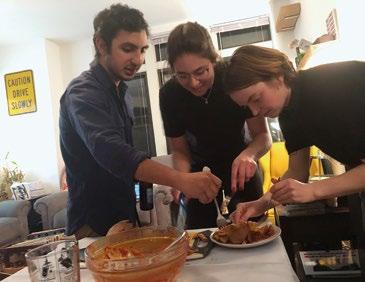
Exactly a year before we were exiled from restaurants and mandated to cook at home, we embarked on an academic exploration into what exactly differentiates the restaurant experience from home cooking.To each of our group members, eating, and more specifically sharing a meal, was understood as a ritual act. Certain customs, tools, and practices are shared across the world, but others are idiosyncratic to one space. There is a certain homogeneity to dining in a restaurant that is contrasted by peculiar family traditions that one only observes when eating in a home environment. The smallest deviation from one’s expectation at a restaurant may be enough to ruin a night out, but when grandma serves the same four-ingredient soup she’s made for 40 years in mismatched bowls and cutlery, it’s somehow the best meal you’ve ever had in your life. With this in mind, we headed to Sinha, where the home kitchen and the restaurant perfectly coalesced.
Arriving at Sinha for Sunday lunch, we were ushered into Jorgina Pereira’s living room, in her Near West Side home-restaurant. We helped ourselves to the cheeses and fruit laid out before being invited downstairs into her dining room. Here, we sat at a long table with other groups, with whom we shyly ended up chatting as if to new faces at a friend’s dinner party. Jorgina, owner and chef, seemed to truly encompass the role of host—both greeting us and showing us to our table, but later on serving us greens halfway through our meal straight from the pan to the plate. We, similarly, occupied space somewhere between customer and guest—helping ourselves from the heaping platters in the center of the table, but still settling up the bill at the end. We wanted to explore this ambiguity, this space between the restaurant and the home, the public and the private. And so, we held our own dinner; a $10 per-head six course meal cooked for friends out of an apartment kitchen. We cobbled together enough cutlery, crockery, and chairs for our guests and produced a total of 66 plates, each inspired by memories of home-cooked meals, a feat considering the chef-to-space ratio of the kitchen. We didn’t eat with our guests, instead taking the roles of host, server, chef, and bartender.
It will no doubt take time before we are comfortably back in restaurants and before the hospitality industry has recovered from the effects of this pandemic. But one day we will get back to dining out and hosting others. And until then, we shall continue to both enjoy and endure the home-cooked food that we so longed for previously.
Día de los Muertos, a period of festivity and observance within Latin America, is a reunion of the living and the dead in service and remembrance. Despite its origins in pan-Roman Catholic dogma, in Mexico this holiday is centered around the more folk and spiritual traditions of altar making, the creative processes of display and performance, and lastly, at the center of my research, the food offerings (ofrendas). From chocolate to squash (calabaza), sculpted sugar skulls (calaveras) to pan de muerto the prominence of sweets in spaces of solemnity made me think about the paradoxes inherent to the festival’s historical context and symbolic presence, specifically within Mexican-American culture. My research questions were tri-fold: How does sweetness as a response to death complicate our traditional notion of grief and healing, and does this reaffirm or challenge Mexican stereotypes?
During the creation of a sugary ofrenda, how does one strike a balance between visual appeal and quality of composition, and is there a loss of intentionality/ integrity if aesthetics are placed in the focus? Finally, how does the nature of the ofrenda itself change in post-modern MexicanAmerican society?




Through an ethnographic survey of Pilsen’s annual Día de los Muertos Xicágo celebration,


I wished to explore how spiritual connections were created by altars. It wasn’t until my time observing that I recognized that I should be asking another question as well: who was facilitating this connection with the dead? The altar makers, and precisely the bearers of this knowledge, were women and young girls, their daughters and granddaughters. These women bring about healing; to themselves through the process of creation, and to others who can experience what they have created from their knowledge.
In photographs and interviews, I delved deeper into the visuospatial portrayals of food to make sense of the conflict between the artificial and the real. Many altars exhibited plastic fruits, conchas made of fabric, store bought pan de muerto and calaveras (which are inedible). It is traditionally known that one must put out as ofrendas recently prepared mole, tamales, sweets, the freshest flowers and fruits because they are the strongest in essence and aroma, and the souls can take that with them. Though in my interviews, many claimed that there is no difference between storebought and handmade foods: it is more about the action of placing the bread on an altar, of honoring the deceased life. This transition of the edible to the inedible, the handmade to store-bought, brings
in dimensions of modernity, such as the industrialization of sugar. The rise of consumerism, and thus poor eating habits, produce and commodify the new ofrenda

Traditional practices originating from pre-Columbian rituals are pushed into postmodern Chicago society, changing the nature of the ofrenda itself. The overwhelming amounts of highly-processed foods such as instant ramen or Cheetos reflected a sort of decay through daily consumption that is commemorated and remembered.
For my final project, I made an altar of sorts, centered around the mouth itself: the place where food meets tongue, where habit begins and destruction may occur, to produce a larger exchange of life and death. Thus, I entered the mouth of a muerto, informed by my favorite highly-processed sweet
Cheloh-abgoosht with Gondi (Iranian-Jewish Chicken Soup with Meatballs) and Matzo Balls.


Timpano

Wine and a Blackjack Hand

in my Cuban-American culture: guava paste (pasta de guayaba), and the most culturally significant sugary ofrenda of Día de los Muertos: the Mexican calavera comprised of meringue powder, sugar and water. The tongue was formed by the repetitive layering of pasta de guayaba strips on a chicken wire mesh infrastructure.
The teeth surrounding the tongue were plaster blocks, covered in a sweet shell of sugar, merengue



and water. The Happy Meal (a symbolic trinity of Burger, Fries and Coke) was placed in the center, as a socio-economic reality. The smell, structure and material bounced between artificiality and authenticity, the profane and the holy, death and life.


The story of Tio Jr., a deceased relative of the Gonzalez family, was told through the ofrendas of sunflower seeds and Monster Energy drink. In his life before his death, his brother recounted that the habit of drinking this beverage became excessive; compounded with an undiscovered illness, this excessive consumption led to his death. Why would this drink be commemorated and offered in his life after death, I asked? It is about celebrating his life, not his death. The response allowed me to think about the symbol of the ofrenda holistically, as a spatiotemporal object undergoing cultural negotiation. They are celebrations of the life of the deceased and all that comes with that: their likings, their pleasures, their vices. It is a narrative of the deceased told through their consumption habits. The memories that come along with that are what remind them of the personality of Tio Jr. and his story within their larger family history. Monster Energy drink was a motif in Tio Jr’s story: a pattern of pleasure through a device of destruction.

Through ethnographic surveys of Chicagoland restaurants, including Susie’s Noon Hour Grill, Rice and Bread, Superkhana International, and El Ideas, we explored the notions of fine dining and home food, discussing questions of aesthetic, nostalgia, comfort, and belonging. We examined food’s relationship to both elevation and comfort in search of concepts of “essence.” Our research was strongly driven by a desire for understanding the essentialization of habitus into dishes or meals. Our final presentation took the form of a home cooked dinner where we prepared a variety of dishes and their representations in order to evoke the notions of culinary nostalgia we encountered in our surveys and personal experiences.
For this meal, we prepared vada pav, a classic street food found across the streets of Mumbai that involves sandwiching a deep fried potato fritter in a bread bun, laced with three different chutneys, tamarind, coriander, and dry garlic-sesame. For one of our ethnographers, as an Indian who grew up outside of India, vada pav is the food that first tied him to the space of the country itself.
Another dish we recreated was fried rice, a street food that can be found in every Chinese restaurant around the world. To construct our fried rice dish, we broke down the components of the original recipe and experimented with the aesthetics, forms, and contexts. Rice is the main star of the dish, a powerful ingredient because it absorbs the flavors introduced to it. We decided to cook the leftover rice with Maplewood bacon fat because we wanted the rice to become a carrier of the fatty, salty flavor. Next, please allow us to introduce rib-eye steak; an ingredient that is often associated with western cuisine and luxury, we added this cut of beef to an otherwise economical street food. Through this juxtaposition, we wanted the audience to reimagine what fried rice is and what it could taste like.
As we enjoyed our meal, what struck us was the feeling of comfort in eating street food—this is one area that across cultures creates a sense of belonging, shaping the space of the street into a place in our memories and a place much like home. Perhaps it is the sensation of eating with our hands, or that it is fried and full of flavor, or perhaps it is the shared experience of the dish as it is eaten by so many across the country and world. We felt that to begin the dinner with street food would be a great start for conversation around comfort outside the home, as well as new flavors and foods newly entering the home—an elevation through both its visual representation and existence on the menu. As we welcomed our guests with our recreated street foods, it began our journey to find comfort outside and elevation within the home.
Menu
Vada Pav

Akutagawa
Galbitang

Steak Fried Rice


Bacalao, reconstituted, was on the menu when Café Ba-Ba-Reeba! opened to innocent but curious Lincoln Park diners on December 26, 1985. But dried, salted codfish was also, oddly, dangling amid a curtain of jamon, garlic and dried chilis above the bar at Chicago’s first tapas restaurant.

“Whole smoked hams and dried salt cod hanging from rafters add a Spanish note,” according to the Chicago Tribune in its review of the 21st restaurant in Lettuce Entertain You Enterprises’ mighty empire (14 years after founding partner Rich Melman invented the salad bar at R.J. Grunt’s). Like many of Lettuce’s concepts, it was a hugely popular novelty at the time. It was also one of the very first tapas restaurants in the U.S; often credited with helping to launch America’s obsession with an adapted form of Spanish drinking food. Along with a now defunct Las Vegas satellite, it had no small influence on the small plates trend that arose in the aughts and persisted up until the pandemic (for better or worse).
It’s likely that the majority of mid-80s cool kids—bolstered by nearby DePaul University— who lined up for hours in those early days didn’t think anything of the bacalao bobbing above the bar. But it’s not a common accent in Spanish tapas bars, where the simple act of placing a piece of bread atop a glass of wine to keep the flies out, evolved into a galaxy of bar snacks and an enshrined, communal eating culture.
But Montse Guillen certainly thought it was strange. And she would know—there was codfish hanging at her restaurant too.

Guillen was a Catalan chef of increasing renown in the early 80s, when she and her partner, Clarion jefe Antoni Miralda, opened El Internacional in Manhattan’s Tribeca neighborhood. Not only was it the very first tapas restaurant in the United States, it was an evolving two- floor art installation with a sidewalk mosaic of Coca-Cola cans at the entrance and an enormous replica of Lady Liberty’s crown on the roof (featured in a yearslong opening credit cameo on Saturday Night Live). Inside, the Columbus Trophy Bar served blue margaritas under four large, hanging bacalao, and in the Marina Room, diners snacked on Guillen’s patas bravas, orejas de cerdo vinagreta, and bunuelos de bacalao above
four whole salted cod fish on a bed of blue salt sunk in the floor.
Bacalao is a recurring motif in Miralda’s work. “I’ve always been interested by the codfish itself,” he says. “Not only for the importance it has in nutrition in the world: it was on all the transatlantic voyages. This was about survival. But also because it has an incredible shape like a triangle. A codfish has a presence, really, a holy presence.”

It also has a pronounced olfactory presence. “Their smell is always a trademark!”



For this reason, they aren’t a common presence in Spanish tapas bars—at least in uncooked form. Montse Guillen might have neglected to mention this important piece of advice the evening she was summoned to the table of two young men visiting from Chicago who said they were planning to open a tapas bar in their midwestern meat-and-potatoes metropolis. “‘You need to have somebody from Spain in the kitchen,’” she told them.
So Guillen was surprised and flummoxed to encounter the bacalao above the bar about a year later when she dropped by the new Café Ba-Ba-Reeba! on a short visit to Chicago.
“This I remember very well,” she says. “I talked with my friend: ‘Look they copied this maybe. They’re thinking in Spain they put codfish in the tapas bars.’”
Guillen and Miralda moved on to other projects not long after that, but Café Ba-Ba-Reeba! has endured, recently celebrating its 35th birthday with a $70 “Tapas Tasting Menu” for carryout or delivery. And just last week Lettuce “temporarily closed” it’s two-year old River North Spanish wine bar Bar Ramone, replacing it with a new outpost, Lil’ Ba-Ba-Reeba! Its longevity is emblematic of LEYE’s overall success over the decades, with a number of carefully curated restaurants that present gleaming, easy-to-swallow facsimiles of particular cuisines or environments. These restaurants are both beloved for their theatrics and criticized for practicing a kind of Disneyfication of culture and cuisine.
There was, in fact, a Spaniard in the kitchen when Ba-Ba-Reeba! opened in 1985. Chef



 By Heangjin Park
By Heangjin Park
As a Korean living in Chicago, I cook and eat Korean foods at home. To be precise, I have learned to create a culinary version of “Korea” in my kitchen over the years. Still, there are a few dishes that I cannot cook at home, often making me feel a terrible craving. Then, I dine out. When I venture out to cure my cravings and homesickness, I am doomed to have higher expectations. I am doomed when I find that my beef blood cake in broth is flakey. I am miserable when I find my cold noodles are chewy and don’t have a hint of buckwheat. I feel lost when I drive an hour and a half to get a bowl of Korean pork sausage soup, only to find that it is never close to what I imagined. I drive home for another hour and a half, feeling the distance between Seoul and Chicago in my mouth. Nevertheless, there are exceptions. There are places where I know with certainty I can be cured of
homesickness. I can feel closer to the home I left almost ten years ago. There are foods I think are even better versions of the dishes I have eaten in South Korea. However, it can be slightly complicated to explain when the food I crave is “Chinese.”
Dishes like jajangmyeon (noodles with black bean
sauce), tangsuyuk (fried pork with sweet and sour sauce), and jampong (noodles with spicy broth and seafood). The best way to label them is Korean-style Chinese, but the only way to explain what they are is through history.

In the late 19th and early 20th centuries, many Chinese immigrated to Korea to avoid natural disasters and wars, or find work opportunities. Some of them opened Chinese restaurants for other Chinese migrants and travelers, as well for local Koreans. The Chinese restaurants in Korea adapted to Korean customers, which often resulted in the creation of new dishes. For example, jajangmyeon is a Korean adaptation of Chinese zhajiangmian, a noodle mixed with black bean sauce popular in the Shandong region. Over the years, the black bean sauce for the noodles became sweeter, and onions and potatoes were added. The Korean version is now completely different from the original Shandong dish, and can only be found in South Korea and overseas Korean communities. Jampong is a Chinese noodle adapted to Japanese tastes and ingredients, and later introduced to Korea through an overseas Chinese network. Various seafood is added to Japanese champon, the main difference from the original Fujianese noodle (tangrousimian). Korean jampong is different from both Fujianese and Japanese versions with copious amounts of pepper oil and gochugaru (chili pepper flakes) added. Tangsuyuk, on the other hand, is not so different from the Cantonese dish guloujuk made of fried chopped pork with sweet and sour sauce. But the dish does not have as long of a history, as it was invented to accommodate the tastes of Englishmen in China, and later introduced to Koreans and others all over the world.
Gabino Sotelino was born in Vigo, Spain, and began cooking at the age of 14 in kitchens all over the world before joining forces with Melman to revitalize the legendary Pump Room. Together they opened LEYE’s first fine dining restaurant, Ambria, followed by the French bistro Mon Ami Gabi, before Sotelino convinced the boss to open a tapas bar.
At first Melman thought the chef said “topless bar” (a joke both men still tell). Neither remember visiting El Internacional during the research and development phase. Nor do they remember whose idea it was to hang bacalao above the bar. But Melman is open to the possibility that they were inspired by it.


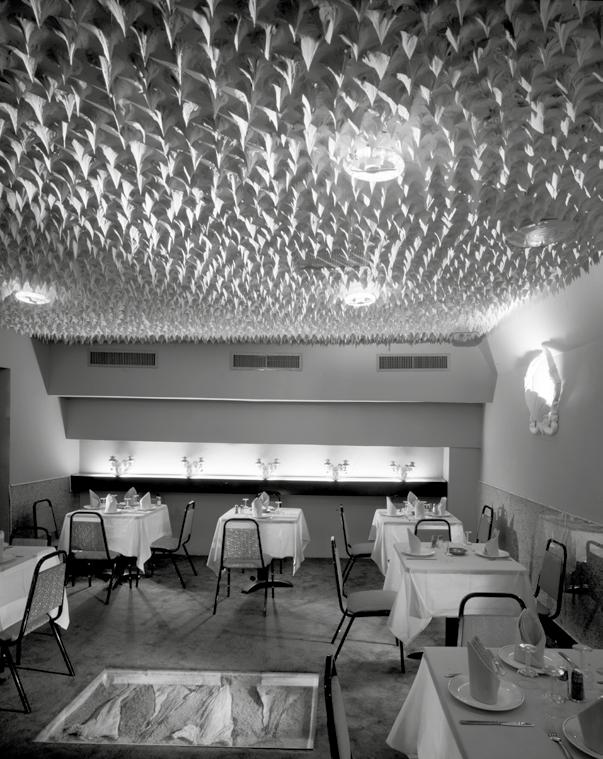
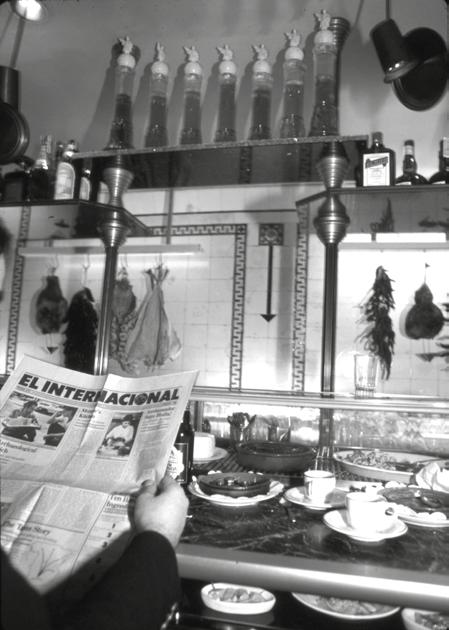
Sotelino and Melman had different visions for the restaurant. The chef wanted a rigorously authentic Spanish experience, and his menu prototype included things like tripe, pigs feet, and barnacles. Melman was sure Chicago wasn’t ready for this: “I said ‘Gabi there’s no way we are opening up. I just don’t feel it. I’m telling you we’re gonna get killed.’
Changes were in order. “I’m not interested in the six people who know it’s authentic,” says Melman. “I said, ‘Hey, I don’t know how they dress in Spain but I want to get crazy.’” We changed 80% of the menu. We left the paellas and the hams and stuff that were good and then we opened it. And I had a lot of fun.” Servers wore capes. Flamenco dancers stamped and tapped among the tables. Chicago ate it up.
It’s unclear when or why the hams and bacalao above the bar were retired. It’s undoubtedly a good thing that the restaurants that took their inspiration from Café Ba-Ba-Reeba! and El Internacional didn’t deploy salt fish as a decorative element.
As for Melman, he recognizes that the dangling bacalao was a mistake. “We fucked it up!” he laughs. And El Internacional? “Maybe we did get an inspiration for what was going on there.” After all, he didn’t get where he is today by ignoring inspiration when it strikes. He offers a quote from his unpublished memoir: “Imitators blindly copy an idea. But creative people are often inspired by something they see, or taste, or hear. Take an idea. Make it better. Make it your own. Make it fit your organization and culture.”
Jajangmyeon, jampong, and tangsuyuk are undoubtedly the most popular menu items in “Chinese” restaurants in South Korea. Unless it claims regional specialties or authenticity, most “Chinese” restaurants in South Korea serve Chinese dishes adapted to Korean preferences. Chinese food is not only popular, but also affordable and accessible in South Korea. A bowl of jajangmyeon or jampong costs about 5 dollars, and tangsuyuk for two or three people is about 15 dollars. More importantly, Chinese restaurants are everywhere, both in urban and rural areas. In South Korea, there are about 20,000 Chinese restaurants, one for every 2,500 Koreans. Most of them offer delivery services. To be more accurate, they almost exclusively rely on delivery. Food is delivered hot in less than half an hour, often with no extra delivery fee. Since Chinese food is such an affordable and accessible luxury, most Koreans grow up eating Chinese food once in a while, learning to love the greasy, spicy, and sweet delicacies delivered to their homes.
Now there are quite many Korean chefs cooking these Korean-style Chinese dishes. But historically, Chinese restaurants in South Korea are run and owned by overseas Chinese, what Koreans call hwagyo They are ethnic Chinese who migrated to Korea in the 19th and 20th centuries and have lived in South Korea for generations. Most came from the Shandong province (like zhajiangmian). The South Korean government made it almost impossible for hwagyo to obtain South Korean citizenship. They could neither claim the citizenship of the People’s Republic of China nor go back to their hometowns, as there were no diplomatic relations between the two countries during the Cold War. They were technically the citizens of the Republic of China (Taiwan), with which they did not have any personal or cultural connection. As fears of them becoming influential capitalist figures like overseas Chinese in Southeast Asia grew, hwagyo experienced political, economic, and social discrimination. As non-Korean citizens, they were not protected or even compensated when their land and buildings were seized by the government. Most companies refused to hire them. As such, they were forced to run their
own business, mostly Chinese restaurants. In the 1960s, about two-thirds of Korean hwagyo worked in the restaurant industry. But even their restaurant business was threatened with unreasonable policies such as a ban on serving dishes with rice and strict price controls.
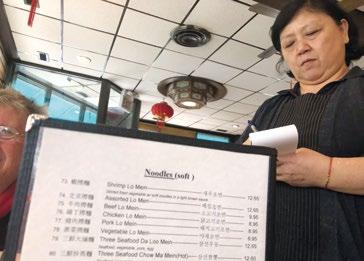
So it was no wonder many hwagyo moved to the United States to avoid political, economic, and social discrimination in South Korea. Many hwagyo chose to become chefs in Chinese restaurants in the U.S., even those who didn’t originally work at Chinese restaurants in South Korea. Their visa and residency application review would be expedited if they were qualified as “special technicians.” Those who did not have any cooking experiences opened Chinese restaurants for (white) American customers, who would enjoy simple, easy-to-cook Chinese dishes. Those who had some cooking experience in South Korea opened Chinese restaurants for Koreans, joining Korean American communities. Their Korean-style Chinese food reminded Korean Americans of their homes and childhood memories, thus mediating the relationship between Korean Americans and hwagyo in many American cities, including Chicago.
Chicago proudly hosts a few Korean-style Chinese restaurants. Old restaurants are located in Albany Park, where Korean communities thrived between the 1970s and 90s. Peking Mandarin (Aseowon) is one of the oldest Korean-style Chinese restaurants in Chicago, which opened in the early 1980s. Among Koreans in Chicago, Peking Mandarin is known for its spicy jampong. VIP (Gukbinbanjeom), closed in 2016 due to the owners’ retirement, was loved for its tangsuyuk Great Seas (Daeyangjang) is probably the best-known Korean-style Chinese restaurant among non-Korean Chicagoans, obviously for its lollipop chicken wings, kanponggi in Korean. Like the owners of VIP, the Great Seas’ owner retired in 2016, but the restaurant (along with its chicken wing recipe) was purchased and now run by another hwagyo who ran multiple Chinese restaurants in Michigan.

Albany Park is no longer considered Koreatown, as most Korean Americans moved to northern suburbs for better education and
larger houses. Albany Park functioned as the commercial center for Korean communities after the exodus, but many restaurants eventually moved to or opened in suburbs where many Koreans now live. Great Beijing (Daebukkyeong) in Lincolnwood, one among the oldest Chinese restaurants in Chicago, is known for its jajangmyeon Yu’s Mandarin in Schaumberg and Chef Ping in Rolling Meadows are popular Korean-style Chinese restaurants for family gatherings.
When you enter the restaurants, you are immersed in a fantastical world created by food and decoration that evoke nostalgic sentiments. Photographs, calligraphy, lanterns, and dolls are all mobilized to represent a version of “China” for customers. You are served hot jasmine tea without asking. Upon your order, you will be served a few side dishes: chopped raw onions with black bean sauce, pickled yellow radish (a Korean adaptation of Japanese pickle), and cabbage kimchi (not the Chinese cabbage for typical Korean kimchi). These are a combination of side dishes unique to Korean-style Chinese restaurants. Chinese food is meant to be shared; scissors, unusual utensils to see on restaurant tables except in Korean restaurants, make sharing noodles a little bit easier and less messy.
A perfect recipe does not make great Chinese food. A chef with knowledge, techniques, and experiences does. You can taste the differences between Chinese food cooked by experienced hwagyo chefs and the one made by non-hwagyo cooks. Every detail in the dish—temperature, texture, balance between flavors, and colors—indicates the gap between them. Chicago’s Korean-style Chinese restaurants have served great Chinese dishes with hwagyo chefs in their kitchen. But their chefs, who came to America and worked at restaurants for almost 40 years, are reaching retirement age, if not already retired. Can other people in the kitchen cook the same food? If so, who?
The owner-chef of VIP restaurant confided in me when he decided to retire: his kids are all pursuing professional and successful

careers. He tried teaching his Mexican line cooks, but they struggled to reach his standards. He decided to close the restaurant rather than selling it to others. He did not want anyone else—those who did not share his cultural background and culinary experience—to come in and sell unauthentic, poorly-made Chinese food, disappointing his longtime patrons. Other Korean-style Chinese restaurants face somewhat similar dilemmas. The owners’ kids are pursuing more lucrative careers rather than inheriting their businesses, which the hwagyo restaurateurs have always aspired to, and their kitchens are often run by migrant workers from Central America.
These changes in the restaurants’ kitchens have created quite interesting linguistic scenes. In Peking Mandarin, the owner’s family speaks to each other in Mandarin, but speak to their kitchen staff in Spanish, as Spanish-speaking chefs and cooks now run their kitchen. They speak in Korean to their longtime Korean patrons and young students who come to cure their homesickness (like me). Still, they speak fluent Spanish or English with non-Korean clients, especially Spanish-speaking customers from the neighborhood. Do not get me wrong.
Peking Mandarin still serves amazing jampong and tangsuyuk, better than most Chinese restaurants in South Korea. Their care for details is more noticeable when you order takeout. Food is carefully packed to maintain the
ideal temperature and slightly undercooked for a long trip. This level of care and attention is a great virtue, especially during the pandemic, when we cannot fully enjoy hot Chinese food in restaurants anymore.

Korean-style Chinese food has adapted to people’s tastes and local conditions outside China, cooked by people moving across borders for political and economic reasons. For many Koreans and Korean-Americans, it has a magical power to bring a bowl of “Korea” where they grew up, curing their homesickness. For many hwagyo who are working 10 hours a day every day however, it symbolizes the social discrimination that forced them to move across the continents and marginal socioeconomic positions both in South Korea and the United States. For many nonKorean customers, it is just delicious “Chinese” food cooked by amazing chefs, some of whom are not from the hwagyo family anymore. In the end, Koreanstyle Chinese food in Chicago’s restaurants is multiple things for various groups of people, being served through the connections and tension among them.
Heangjin Park is a Ph.D. Candidate in Anthropology at the University of Chicago. He has conducted research on the food industry and trade in China and South Korea, exploring the relationship between food, nationalism, and globalization.
Angelina Méndez is the owner and watchful culinary supervisor of one of Chicago’s most unique taquerías, La Chaparrita (“the short little lady”), situated in Little Village, just off 26th Street at 2500 S. Whipple. In operation for the past 20 years, La Chaparrita could be described as a bastion of exceptionally good Distrito Federalstyle tacos (no lettuce, tomato, crema, or other nonsense, please), expertly cooked to Angelina’s specifications (no griddling the meat, ever) by the Veracruzano César Castillo, were it not for the fact that La Chaparrita doubles as a public shrine to Mexico’s folk saint Santa Muerte (“Holy Death”), replete with a massive altar to what devotees often affectionately call “la dama blanca” or “la flaquita.” As Angelina told Miralda and Palmié, it all started
out as a grocery store financed with the help of her mother—the pioneer tamalera on 26th street— who refinanced her home to give her recently immigrated daughter a start as an independent culinary entrepreneur. Given the role Santa Muerte played in Angelina’s coming to the U.S., right from the start, her altar originally inhabited a space behind the counter, but about 10 years ago, Angelina and the saint decided that it was time to offer devotees a space of public veneration and pious offerings. Ever since then, people have been coming to La Chaparrita both to eat and to pray, or to leave offerings at the now prominently displayed shrine to “la flaquita.” Up until the time of Covid-19, Angelina hosted a public ceremony and feast in honor of Santa Muerte’s saint’s day on November 1st every year.
But let us have Angelina tell the story her own words— how it all started back in Mexi co City, Distrito Federal:

I became a devotee of Santa Muerte when I was married to the father of my daughters, my first husband, in Mexico. I had a lot of problems with him because he judged you a lot, he was a very jealous man. It wasn’t a good life, was it? So, among the needs of wanting my husband to change, and, in this case, the son to change for my motherin-law, she and I happened upon the topic that a woman had bewitched him. It was why he was like that and why he acted like that. Because of the beliefs

But, course, Angelina is not only devotee La dama blanca; she is also savvy businesswoman who designed the beautiful tabletops and much else in the restaurant
of my mother-in-law we went to look at a person who cured witchcraft, right? The healer told me, “Ask the saint. Ask the saint to help you.” Obviously, I began to ask of her and ask of her. It didn’t change my husband because he was a liar. But Santa Muerte gave me the strength to get out of this cycle, out of this toxic relationship. In these years, my mother was already [in the United States], therefore I was practically alone in Mexico with my family. But, ultimately, my mother, my main support system, wasn’t here. So, I began to ask the saint for the strength to leave this bad relationship. That she would help me to change my daughters’ lives, and I decided to


get rid of my husband. I spoke to my mother, “Ma, I don’t want to live with Luis. I don’t love him anymore, I want to be with you.”
And let me tell you, when I came, I came with my two daughters and in my bag I brought Santa Muerte. I brought my daughters and Santa Muerte. And in truth, it was her who opened the path for me. I prayed to God, then to Santa Muerte. I prayed, “God, if it’s for my benefit, please open the doors of the United States to me. If you think I’m doing something wrong by destroying my marriage please do your will.” I stopped praying when I crossed the border. My mother was my coyote, or the one who helped me cross the border. We

didn’t need a coyote, my mother was mine. She traveled from here from Chicago to Nogales to bring me. When I was crossing the border, I entered through the exit. As people came out, I went in. And let me tell you something, instead of people pushing me out because I was going the other way, people made their way for me to pass. So there I prayed, “My little saint, my little saint helped me, she comes with me.” And so, God knows, he opened the door of this blessed country for me and I arrived to the United States. I arrived with my friend in the bag. As I’ve said, I have a lot of faith in her. Santa Muerte will not solve all of our issues because Santa Muerte is a being of light that intervenes for us with the all powerful. It is not that Santa Muerte is a god and God is another god, no. There is only one God, but God has his servants.
Since then Santa Muerte has been Angelina’s faithful pro tector and companion:

I think of it like this: I tell the truth to Santa Muerte. In the morning I pray to her here inside my house. I light incense every day, and when I get to the business I do the same. I do the sign of the cross, and I light her incense. My faith in Santa Muerte is as if she were like a living person. I talk to her like I’m talking to you, right? I say, “Mother, we’re going to do this and this and this and this and this.” As if you feel the answer yourself, as if we will or not. When I said to her “Comadre, I’m going to change your party because it’s cold.” And as when one is left with this doubt, am I doing it right? It’s like an answer, no —right? When making a decision, she says, “okay.” We start to speculate. Because like the way you go to people so much in the cold, because you will be more comfortable. So it is like an affirmation. That is the way I manifest it, right? But many people have told me that Santa Muerte has presented herself, that they have seen her at the foot of her bedside, at the foot of her bed.
But, of course, Angelina is not only devotee of La dama blanca; she is also savvy busi nesswoman who designed the beautiful tabletops and much else in the restaurant. She also is someone with very clear ideas of what good taco estilo DF should taste like. As she ex plained,





I’m the one who has the ideas. I like to stay in the store after closing and I like to program or plan. I like to program how to change the business. I’ve always had this thing where I like to stay and design mentally the changes I’m going to do. And little by little the taqueria has become a product of my imagination. It is my source of income, it is the place where I feel happy, where I am comfortable, where I do not mind working, where it does not disturb me. I feel happy here in this business. I’m very grateful to God above all for so many blessings, for so much he gives me. After arriving here with only the clothes that I was wearing, and well, I have been very blessed. Thanks equally to the support of my mother, who has always been there to protect me in my decisions, right? And in my aspirations. No, right now my mother is old, she can’t work anymore.
We asked her if the menu in La Chaparrita has changed over the years, but she was adamant that hadn’t—nor would.
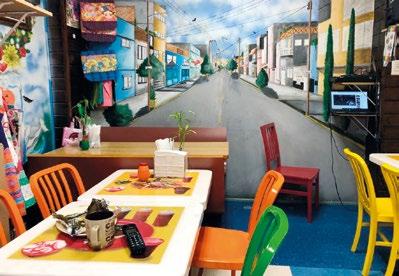

What I like to be careful with in this regard is that the taste needs to always be the same. We don’t change it, nor do we vary it because what I want is that people, when they come, taste the flavor that is closest to Mexico City. Because that’s what I represent, D.F., tacos in the style of D.F. Therefore, this is what I try to preserve in the taste of the tacos. The preparation of the meat is always the same so that when the client comes back, they find that same flavor, right?
It’s one of my concerns, the day that I or my mother dies, what’s gonna happen to La Chaparrita?
Because none of my daughters want to learn the preparation process.
If I die or I don’t want to work anymore, I can’t work anymore or something like that, what will happen to that business? My daughters are going to take care of it, but they are going to completely change everything because they don’t know how to do anything. They don’t know how to prepare, but they don’t want to learn. Then, no. Because I am one of the people checking, I eat a taco and say “It lacked salt,” and I talk to the person who is preparing. “You know that you need to add more salt, you are not putting the salt that I told you, the portion of salt that I told you.” Right? So, I try to take care of these points. The taco sauces, these sauces, no one else makes but me. Now it’s the same. I have great support from César. Actually, César is a man who supports me, helps me, takes care of me. He is a super worker, really.
I have many clients who come from faraway places. They come from New York, Los Angeles, Las Vegas, Atlanta. Every year, their favorite taquera is La Chaparrita. They say, like always, “Everything is really good.” This
is what I like to maintain. That’s why, in the taqueria, there aren’t extras, no lettuce, no tomato, no avocado, no cheese. There’s nothing. The easiest thing is to buy it and sell it to your client. Right? But then what happens? Then there’s not going to be tacos in the style D.F. Because in D.F. you don’t eat tacos with extras, nor with lettuce, tomato, cheese, cream, or avocado. My mind has never been fully set, so if the client wants cream, even if it is D.F. style, I’m going to sell him the cream. I like to be authentic.
The recipes are mine, yes. César when he came to work for me he already was a taquero, of course. But he was working a style on the griddle. So I told him, “Look César, here you work in my style, not in the style of ‘La Chiquita,’” because he worked in “La Chiquita.” Everywhere, they work with the griddle, regularly in all the taquerías. And he accepted my way of working, right? From the beginning I had to correct several things that are required, but now there’s no need for that anymore. And no, César loves making tacos, he is making tacos and he is singing. He doesn’t sing well, but with lots of sentiment. That’s what counts.
César agrees:
I’ve always said that every worker working in any type of work, as long as he does it with gusto, the things come out well. Because there’s some people who don’t. Like in a restaurant if you order something from one person who doesn’t like their work, it’ll come out alright. But, if you order something from a person who actually enjoys their work, it’ll come out differently. It really does count if you enjoy it or not. It’s like putting your own seasoning into what you do. You have to do the things with gusto and enjoyment. Because really, if you do something that you like, you’ll do it right and you’ll put your effort in it. Even if the ingredient is only a pinch of salt because they’re doing it with gusto.
According to César, the two bestselling fillings at La Chaparrita are tripa (tripe) and carne al pastor (pork sliced off a rotating cone) of which they sell up to 50 tacos each on a good

day. Other popular items include cabeza (head), sesos (brain), molleja (sweetbreads), lengua (tongue), suadero (boneless chuck), longaniza (minced meat sausage), chorizo (pork sausage), and carne asada (skirt steak). We asked whether American customers would eat organ meat. “That’s one of the things I thought too,” replied César.

“Well, the American doesn’t eat food with guts or the head… they don’t eat the brain. But that’s what I thought. There are those who really eat the tacos with tripe, tacos with brain, with all of it!” We commented that he was educating them, but César saw it differently:
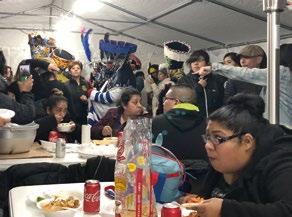
It’s that us Mexicans, we have a way of thinking where we see something we don’t like and we say we don’t like it. But we try
it and then we say whether we like it or don’t like it. One time, well a few times I know, some chefs have come here to eat and they told me that what looks the ugliest is the best to eat.
Of course, he makes fillings for vegetarians, too: nopales (cactus), hongos (mushrooms), calabacita (squash). Not that very many of them visit La Chaparrita, but César will fix a meatless taco, huarache or tlacoyo according to the customer’s specifications.

In the end it all boils down to the crucial question: “the quickest and cheapest?” To which César’s answer is: “tacos!” Done well, of course, just like at La Chaparrita.


Recipiente izquierda: Pozole (carne de puerco, grano de maíz, chile guajillo, ajo, cebolla y sal con epazote).
Plato derecha: Mole Rojo con Pollo, Frijoles refritos, Tinga de Pollo (pechuga de pollo desmenuzada y cocinada con cebolla, tomate, sal, aceite, chile chipotle y laurel), Tortilla de Maíz.
Like all cities, Chicago is composed of neighborhoods. Mostly defined by ethnicity, Chicago has been the classic example of immigration and settlement in America. It used to be said that if you wanted to see Chicago’s ethnic mosaic, travel down Halsted Street. Poles on the north side, followed by Greeks, Italians, Jews, Czechs (called Bohemians in Chicago and later supplanted by Mexicans), Chinese, Irish, Lithuanians, African Americans, Bulgarians, and Serbs and Croats, among others. Many of these neighborhoods developed around industries large and small that made Chicago an industrial powerhouse. Drab as factories and housing might have been, grimy from industrial pollution and poverty, every neighborhood was enlivened by public art. Mostly in the form of store signs and décor, this vernacular art signaled to a visitor the identity of the neighborhood they were in.
First things first: what is a Chicago hot dog? It is a sausage normally made of finely chopped beef stuffed into a “natural” casing made from sheep’s gut. The hot dog is heated by steaming or poaching in a hot water bath, then placed in a top sliced bun and, when fully loaded, is adorned with a slip of mustard, chopped onions, sliced pickle, bright green relish, thin tomato slices, small pickled hot peppers, and optionally a sprinkling of celery salt. Some hot dog stands serve an older style called “Depression Dogs.” These are more plainly accoutered with mustard, onions and perhaps relish. One thing joins all stands, or rather the lack of one thing: ketchup. Upon pain of banishment from the city, there is never ketchup on a hot dog—though chili is permitted, grudgingly.
From the 1930s until recently, hot dogs stands were a main vehicle for identifying and signifying the nature of each neighborhood. The signages of these stands told stories about the stand owners, their ideas and aspirations, visions of an existing and imagined world. Smiling dachshunds set into buns, giants holding up hot dogs, huge Chicago-style hot dogs overflowing with toppings, hot dogs with legs and arms dancing and marching, and hand painted menus crowded with items in bright colors adorn the hot dogs stands. Over a number of years, Patty Carroll has photographed these stands, documents of local
cultures and themselves pieces of art. They are the core of our book Man Bites Dog: Hot Dog Culture in America. Now just a few years old, the book is sadly more of a historical document, as gentrification and changes in taste have caused a decline in the numbers and variety of old hot dog stands.
The architecture of the traditional hot dog stand is influenced by the kind of food served. These are basically single-food eating establishments, stationary versions of pushcarts or temporary stands. Many are simply small boxes which have remained the same or have been embellished
over time. They are typically not like cafeterias or diners; sit-down, multiple food outlets. Some stands do have a few outdoor tables or, more commonly, counters, but they are not dinein places. Form and function come together in the practical, folk architecture of the hot dog stand.
Of the décor, there are two basic styles. One is a utilitarian eatery, its signs more descriptive of the food served. The other is a form
of entertainment, with signs and symbols meant to amuse and lift the visitor from the ordinary world. The styles can be graded from spare to baroque. Here, again, the style is a mixture of neighborhood and individual visions. If the hot dog stand represents its neighborhood, then often the decor emanates from the local cultural style and from the individual operator who may or may not come from that locale.
Signs, figural art, and even the architecture of these stands reveal a number of influences.
Some are nostalgic. Others are fanciful and celebratory, meant to remove us from this specific time and place like a carnival or street fair. Some are clearly the work of a highly individual character, still others emulate modern corporate feeding places. There are other categories, but all work within circumscribed forms and colors depictions of the hot dog in particular, food in general, and a red and yellow color scheme. What follows are some of the categories of décor and perhaps meanings of several classic hot dog places.
Unlike corporate fast food restaurants, Chicago food stands mean more than just places to get food. Here, hot dog stands are symbols of time and place,

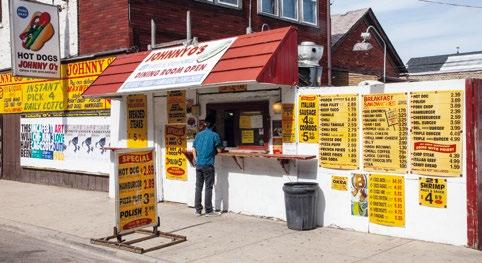

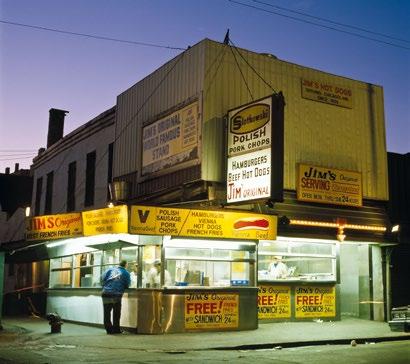


where one-time children recall their family, friends, home, and neighborhood. By its signage and very existence over time, the neighborhood stand represents just that place. It is on these grounds that people argue about the qualities of hot dog stands, the intangibles of warm memory and of taste memory as well. For those raised on the local hot dogs, biting into one evokes the past. And the ones people remember most fondly usually have an antique quality about them, often a kind of grunginess—antithesis to the national chains that adds to the physical and imagined flavors. It is this quality that creates a fellowship of hot doggery, one reason for the powerful attachment of Chicagoans to their hot dog stands, especially those with which they grew up. It is also the reason why in the past Chicagoans have been resistant to any other kind of hot dog, such as New York style.
Historically, hot dog vendors do not live in the world of large scale food processing and marketing. They are people who live at the fringe of the greater market, and as such an entryway for immigrants into the American economy. Travel through the city, in the wellworn urban neighborhoods that have not been subjected to gentrification, and there will be stands where they have been for more than fifty years. And so we see the vendors in their businesses, hopeful and at the same time hopeless. Often their signs are crude expressions of those hopes set amid a fading urban life. They await the next customer, most knowing that their dreams stop here. Far from expressing the reality of hard economic facts, many exist as a state of liminality, a world of expectation beyond this one. It is a kind of anti-modernity in a world determined to be modern.
To aficionados, the proper preparation of a hot dog is a skill, and the hot dog itself is a work of art. So are the places from which they are sold. Many hot dog joints in their design and decor are forms of vernacular art. The iconography means more than art for art’s sake, though it may be that, as well. There are cultural attitudes here often expressed as myths
and symbols. In the traditional sense, anthropomorphized hot dogs and depictions of giant food are all standard themes in folklore. Here they are symbols of the American cornucopia. Hot dog stands and carts, the food itself, and the contexts, represent some of them.
The simple stand is a box with a cut-out window. The vendor remains inside and pushes the product out through the window. The methods of selling reflect differences in culture. The street cart stands in the open, the seller hawking his product, a part of the street crowd. It is the oldest form of selling and the roughest. The stand purveyor to the contrary is sheltered from the crowd, almost anonymous within their dark box. Shielded and permanently fixed, the stand owner’s status in these lower reaches of the economy is greater than that of the street hawker. The barrier between seller and customer adds to a sense of ownership and pride of place. This begets art and so stands are decorated in bright colors and plastered with colorful banners.
Hot dog stands and carts that deliberately decorate themselves as throwbacks to another era, latching onto a familiar popular sentiment. That is, they are no longer old neighborhood eateries, bearing naive art, but have




been transformed into some imitations of what they once were.
Utilitarian design, spare and to the point with simple decor, becomes fanciful and then explodes into baroque artifice.
Since hot dog carts and stands have class distinctions inherent in them, the decor can as well.

That may mean not elegant decor but horror vacui, that is, a desire to decorate every possible vacant space. The interior walls of many stands are covered with pictures or have shelves and glassed in counters filled with knick knacks. Usually they depict neighborhoods in times past, old commercial signs and the local sports teams. Neighborhood community expressed in nostalgia is the main underlying theme. It is one of the enduring ideas that make the Chicago hot dog what it is: part of the city’s cultural fabric.
Carnevale
Borrowing Mikhail Bakhtin’s definition, hot dog eateries might represent Carnevale, alias Mardi Gras. In traditional European societies, it is a time when the ordered world is turned upside down, and representative of all that is rude, base, and vulgar. Many a hot dog stand expresses this theme. The painted decor, figural and sculptural art is often
By Paige ResnickBefore nose-to-tail was a fad embraced by guilty meat-eaters who couldn’t bear to give up the satisfying marbling of a good rib steak, the notion of using the whole animal was a capitalist venture with the aim of attaining maximum profit. Now, you can find an abundance of nose-to-tail cookbooks lining the shelves of Barnes and Noble; hard-bound, embossed covers, complete with glossy pages, encouraging their readers to find an interested neighbor or three to split the cow with, as if this were a reasonable suggestion for the book’s target audience. This showy trend is just the sequel. We have to return to the blood-soaked kill floors of Chicago’s former stockyards, where the original, practical whole animal butchery began.
When rail lines began to materialize around the country beginning in the mid-1800s, stockyards sprang up around them, as the transportation of live animals and butchered meat became much more efficient thanks to the newly invented refrigerated train cars. As Chicago became a major railroad center, it also quickly became the epicenter of the meatpacking industry, processing more meat than anywhere else in the world between the Civil War and the 1920s. Known as the “hog butcher for the world,” the 375-acre Union Stockyards could accommodate 75,000 hogs, 21,000 cattle and 22,000 sheep at any one time, butchering 400 million livestock between 1865 and 1900.
Meat wasn’t the only product to come out of the Union Stockyards. Nearly every part of the animal was somehow used to minimize waste and maximize profit. Hooves were made into glue, livers turned into free lunch for the stockyard workers, and intestines were used for sausage casings and the production of violin strings. But with an average of 39 liters of blood in a single cow and millions of livestock butchered every year, the Union Stockyards had a blood problem; hemacite solved it. Invented by a Dr. W H Dibble in the late 1800s, hemacite is a material made from the blood of pigs or cattle mixed with sawdust and subjected to hydrau-
grotesque: smiling Dachshund dogs encased in buns, ready to eat, giant hot dogs dressed as Hercules and his mate with glowing eyes. The loaded up Chicago hot dog is itself a grotesque figure and so are the many representations on stands. Some are more crudely made than others, but the idea is the same: hot dog stands are often places where modernity has not penetrated. Here the old Carnevalesque holds sway, places where formal categories of our culture are ignored. Carnevale represents the wild side, and that is why so many stands are not standardized, why hot dogs are “rude,” and why we think of them as “fun.” They are.

If Carnevale means the grotesque in spirit, it also means huge amounts of food. Street and fast food purveyors tapped into a main American idea: abundance. The quality of food is not necessarily what matters, but the amount, especially large quantities of meat. Hot dog imagery is heavy on the idea of abundance. A statue of Paul Bunyan holding a gigantic hot dog used to stand before a hot dog place in Berwyn, a near Chicago suburb. Pictures of giant hot dogs in buns and “loaded with everything” are everywhere, on and in stands. Windows of stands, whether in strip malls or freestanding, are routinely plastered with so many signs offer-
ing hot dogs specials and other foods that one hardly knows that these are windows at all.

The Chicago hot dog often is BIG, and when the primary offering is not, the operator will lay two in one bun for the hungry customer. For Americans, traditionally, more is always better, and cheap is better yet.

Visiting a Chicago hot dog stand is not just about eating a quick snack. It is kind of anthropological immersion into the core of Chicago’s traditional culture. This was a place of ethnic working class neighborhoods filled with petty entrepreneurs whose vernacular art represented their ideas about the world. Of all these ideas and myths, those
about food are clear: abundant food based on meat, at low cost, served and eaten quickly, is the American ideal.
Bruce Kraig is Professor Emeritus in History and Humanities at Roosevelt University, Chicago. He has written numerous articles and books on food history with special expertise in the hot dog history and Chicago’s food history. Some of these are Hot Dog: A Global History Man Bites Dog: Hot Dog Culture in America with Patty Carroll, and The Chicago Food Encyclopedia (with Carol Haddix and Colleen Sen).
Patty Carroll has been known for her use of highly intense, saturated color photographs since the 1970’s. Carroll has exhibited internationally and has won multiple awards including Photolucida’s “Top 50” in 2104 and 2017. Her work featured here resulted in the book, Man Bites Dog, with Bruce Kraig, a cultural history of the Hot Dog published in 2012 by Alta Mira Press.
lic pressure. Inexpensive, versatile, and virtually indestructible, hemacite was used to make a number of common household products; doorknobs, roller skate wheels, telephone receivers, jewelry, and, perhaps most intriguingly, buttons. These small, dark red fasteners decorated the shirts of millions, carrying the remnants of the slaughterhouse along on a daily basis. Department store advertisements boasted about their hemacite products, encouraging customers to ditch the “plain black” variety.
Despite its widespread use and enticingly creepy aura, hemacite is noticeably absent from much of current and former writing about the stockyards. In the almost 400 page Illustrated History of the Union Stockyards (1896) by W. Joseph Grands, there is but one mention of blood buttons on one page: “A percentage of the blood is used for blood sausage; also for a coloring matter for dark colored headcheese. A portion also goes through a crystallizing process and is used in the manufacture of buttons.” An online search for “blood buttons” leaves Google utterly perplexed, spitting out results for “I <3 Blood Donation” pins and burgundy-colored leather buttons from specialty Etsy sellers. When I inquired to Dominic A. Pacyga, the Chicago historian who originally piqued my interest in these grisley fasteners, he himself seemed entirely disinterested: “It seems odd to me that the offhand mention of these buttons has proven to be so interesting to people.”
A search of “hemacite” on eBay yields one result, a blood doorknob, dark chocolate brown with a sunburst design, listed for $35 (although the seller gave me a private offer for $20 when I placed it on my watch list, warning me in an email, “A few other interested buyers also received this offer—it won’t last long. Hurry and take advantage right away!”).
So besides this enthusiastic eBay seller, why have we lost interest in this bloody, cost saving product?
Hemacite swiftly lost popularity with the advent of plastic, which was even cheaper to produce, as well as being more flexible and durable. The production of plastic completely replaced hemacite by the mid
to late-1900s. But in an era when eco-consciousness could be considered a trend, why wouldn’t people give up their plastic for a more earth-friendly option? If we are making fabric out of mushrooms, why wouldn’t we make buttons out of the blood of animals already slaughtered for their meat?
I would argue that blood is having a comeback, and blood buttons will be the next “vintage” fashion trend to see a revival. Social media has been a breeding ground for the popularity of blood-based products, particularly for its Instagram-worthy shock value.


The internet has been privy to high-end vampire facials, a combo of microdermabrasion and a “rejuvenating” face mask of your own platelet-rich plasma, made popular by celebrities like Kim Kardashian.
More recently, you can watch the mildly horrifying TikTok trend where teen girls spread menstrual blood on their faces for momentary internet fame and the alleged promise of breakout-free skin.

So it’s not crazy to think that with the right marketing and influencer support, hemacite could find its way back into the homes of American consumers. I can imagine a world in which DIY blood button kits, complete with intricate silicone molds and individually packaged vials of blood and sawdust, make the rounds on Pinterest and Etsy, where YouTubers film videos demoing their newfound craft with click-bait-y titles like “I TRIED A DIY BLOOD BUTTON KIT AND I REGRET EVERYTHING.” Perhaps even a spread in Vogue, the birdlike shoulders of towering models draped in white dress shirts, red blood buttons popping against the crisp ivory. That’s all to say, blood buttons may return as a “retro” trend, restoring a forgotten remnant of the Union Stockyards from a profit-centered past to a chic future.
In some circles, I am known as the raccoon lady, though truly I did not set out to earn this exalted title.



Long ago at a potluck, I sampled some severely over-roasted Mr. and Mrs. Raccoon. I considered it a worthwhile check-off on my life’s list of unique edibles: interesting to have tried, but if another opportunity never presented itself, so be it.
I never gave it another thought until coming upon an online query from David Hammond, a friend seeking a butcher for the trash-mining varmints in his life.


My second chance at raccoon dining was inspired by a Chicago Tribune article featuring the Delafield American Legion Post 196’s Annual Coon Feed. Tom McNulty created the Coon Feed in 1927 to raise money for veterans and youth programs. This event, held at the Post on the last Saturday of January, has taken place annually for nearly a century (unfortunately it was cancelled in 2021). Delafield, just west of Milwaukee, is less than two hours from home. Why not go?
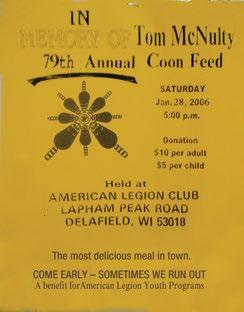
As a gentleman at Moto took my coat, I handed him a plastic bag holding my container of racoon. I inquired if they might consider warming it up so everyone could have a taste, generously offering the staff a sample as well. If they objected, could they please refrigerate it until we left. He promised to consult with Chef Cantu and advise.
After we sat down to dinner, a waiter inquired how many would like to try the raccoon? Ten of the 11 diners affirmed their interest. Of course, there was considerable humor and maybe some nervous tittering about what we were to eat.



I assumed they would simply heat up the raccoon and serve it unadorned. I never dreamed it would be granted the four-star presentation treatment paired with a suitable wine. What wine to serve with raccoon? Moto’s talented sommelier had probably never pondered this question before. At the American Legion, beverage pairing didn’t require much thought: “Let’s grab a beer at the bar!” Moto’s solution was to split a pour of Schubert Syrah between the improvised course and the skirt steak that followed. As
I returned in 2006, and after eating, I waited for those gentlemen to congregate in the kitchen. It took a while because not only do they kill, clean, and cook these raccoons, they also serve the food to a very appreciative crowd.
Eventually several of them were in the kitchen for a break. I reminded them of their gift and told them of the Moto dinner, and how a sample intended for a curious friend turned into what later became a popular item on Moto’s menu. These gentlemen showed the same astonished look as we all did that evening when their raccoon became roadkill.
As I was leaving, they gave me another container of raccoon, this time a half gallon. I reminded them I was coming back next year, though I couldn’t guarantee this half gallon of raccoon would attain the celebrity status of the previous quart.
to drown the raccoon in barbeque sauce. While it may taste safe and familiar, it would hide and not enhance the raccoon’s flavor.
By Peter EnglerMeals were being served on a firstcome first-served basis until the meat was gone. I walked in two hours after the event began, inquiring if they had any raccoon left. “Is all you want ‘coon?” a man wearing a raccoon emblazoned apron asked me.”Yes!” The guy sized me up and advised, “Great, the ticket is half off because all we have left is ‘coon, brown gravy and bread.”
Earlier there were mashed potatoes, sauerkraut and stuffing. For those unwilling to try raccoon, they offered ham.
Unlike my first encounter, I was impressed by this raccoon dinner at first sight. It was juicy like a pot roast. Raccoon is a boney rascal, so one must gnaw, chew and suck to get every wee bit, leaving a plate of bones honoring all the cooks’ efforts.
After dinner was over, I was directed to the gentlemen who prepared the dinner. I naturally asked Hammond’s question, “Where can you find someone to butcher a raccoon?” They gave me a polite but quizzical look. “Young lady, all of us are hunters. We carefully field dressed the raccoons, then later cut them up.”

I then recounted my first dreadful raccoon experience, and told them their raccoon was a completely different and flavorful experience.
They beamed with pride at my compliments. These fine and fit gentlemen, obviously veterans of World War II, cooked 60 raccoons for this event.
As I was leaving, one of the huntercooks kindly presented me with a quart of raccoon meat to enjoy later.

A few days later, I went to a dinner at Moto, Homaro Cantu’s early temple of molecular gastronomy in Chicago, carrying the raccoon in a deli container for David Hammond to taste. Since he had spent considerable time trying to locate a raccoon butcher, I felt he should have a sample of what he had so long desired. If he didn’t like it, then he could cease his efforts.
the sommelier correctly predicted, “It should rock with the raccoon.”
The raccoon arrived on a square white plate, yellow stripes on the left and right, plus a dashed line up the middle. There was rice, pasta, and beans mounded in one quadrant and edible rice paper printed with an image of a raccoon in another. As I used my fork to extract some raccoon, I noticed immediately a change in the texture. Rather than the coarse chunks of meat on the bone, they had deboned it and shredded it more finely, yet the taste was very much the same. Only then did I see the larger picture: the presentation was of a roadkill raccoon, with the animal’s guts splattered across the pavement!
A few months later there was an article about Moto in Time magazine of April 4, 2005 which began:
When a recent guest at the chic Chicago restaurant Moto brought in a Tupperware bowl of warm raccoon meat and asked chef Homaro Cantu to “do something special with it,” the master chef did not flinch. Employing one of his latest innovations, he turned on his Canon inkjet printer and, using meat-flavored inks, printed out an illustration of a raccoon on edible starch paper. He stewed the meat with juniper, placed the paper on top and dubbed the tasty entrée “road kill,” much to the delight of his guest, an avid hunter. All in an evening’s work at Moto, where customers are starting to catch on that whimsy is the chef’s specialty. “We’re dinner and a movie, all wrapped up in one,” Cantu says.

Throughout the next year I often wondered how those wonderful gentlemen who hunted and cooked the raccoons would react to learning what had become of their gift of raccoon meat. I could have called them up or written a letter, but I waited until the next Coon Feed to update them on how their gift kept on giving.


around the armpits and anus. I knew instantly this was destined to share at the annual picnic of LTHForum, a Chicago food chat site. I froze it as-is with plans to deal with the fat and glands later.
Recalling my initial disappointing raccoon, I knew roasting or grilling would be pointless. The Annual Coon Feed taught me a simple braise is best. I knew better than
For the picnic, I decided to cook the raccoon like a pot roast using a pressure cooker. I began by spending perhaps ten minutes trimming fat and a silverskin enveloping the raccoon. This silverskin had the same slippery loose quality like one experiences grasping a cat’s skin; lifting away though the cat is firmly planted and not moving. I then proceeded to remove the legs in whole sections and disposed of the tail. I seared the legs in a few tablespoons of vegetable oil in my large canning pressure cooker, then later the body. Once the body was seared on one side and beginning to sear on the other, I added at least a pound of thinly sliced onions to cook until softened. I returned the legs to the pot with a quart of veal stock, two cups of water, some salt and freshly ground quatre épices. I cooked the raccoon for an hour in a pressure cooker with a ten-pound weight. Once depressurized, the meat was fall-off-the-bone tender. The cooking liquid was reduced by a third, tested for seasoning and poured over the raccoon meat.
When Mike Sula of the Chicago Reader and family arrived, he inquired, “Did you really bring raccoon? I promised the kids it would be here!” Sure enough, I opened a heated insulated container to reveal the tasty creature. In the spirit of the gift that keeps on giving, many people tried it, or at least looked at it.
One cannot count on the gift of raccoon from friends forever. Luckily, I found that freshly frozen raccoon is available at a retail store on Chicago’s West Side. A friend tipped me off to Mario’s Butcher Shop (5817 W Madison St) selling raccoon for 99 cents a pound (now $1.19). It is frozen with its head, paws and boney remainder of a tail. These bits remain to assure the purchaser the carcass is not a stray cat. The helpful butchers offered to remove the head at no extra charge, but I chose to keep the beast intact. Dinner prep began with a beheading.
Catherine Lambrech t is a food explorer. A founder of Greater Midwest Foodways Alliance, Chicago Foodways Roundtable (sister organization to Culinary Historians of Chicago) and LTHForum.com, a Chicago culinary chat site. Editor of Heirloom Recipes from the Illinois State Fair, A Bicentennial Project
I suggested next time I should come early and help make the raccoon dinner. They accepted my offer probably thinking I would never follow through.
The next year in January, I drove up three weeks in advance of the dinner to help clean the raccoons. They were supposed to begin at 9 AM, and I arrived at 10 AM just in time to watch them close up shop. I forgot the Senior Citizen Factor: they always arrive early and leave early.
The day before the Coon Feed, I returned to help chop vegetables and assemble the stew. I arrived before they did by an hour. I did the least favored tasks of chopping apples and onions, completed before their arrival. I then prepped carrots and celery, some chopped to cook with the raccoon and others sliced into sticks for a relish tray.
Once the brined raccoon meat, apples, celery, carrots, and onions were laid out in deep restaurant pans, the kitchen manager added pepper and pickling spices. Each pan was then wrapped in foil. Water to braise would be added on Saturday morning, then the pan popped into the oven for a long, slow cook.
Once my association with raccoon became well known from a Chicago Tribune article, life got even more interesting. A friend met with me in a parking lot, and upon opening his trunk,he revealed a gift of a freshly killed raccoon, so fresh that rigor mortis hadn’t yet set in. Having learned long ago that more opportunities arise from saying yes than no, I took it. I was advised to trim off the fat and scent glands
9 lb Raccoon (frozen with head, paw, and tail will net about 4 pounds after preparation)

White vinegar (to rinse)

1 tablespoon Quatre-Épices (or ground allspice)

2 teaspoons salt
1 1/2 lb onions, halved lengthwise, then thinly sliced into half moons (6 cups)
6 large garlic cloves, finely chopped
1 quart chicken stock (or water)
2 cups water
Initial preparation of the raccoon is essential: Remove and dispose of the head, paws, and tail.

If the membrane is still present after skinning, remove as much membrane enveloping the raccoon as possible with a sharp knife or razer blade. This membrane has the same slippery loose quality like one experiences grasping a cat’s skin. Aggressively trim fat and scent glands on the front and rear legs, as well as along the spine. These glands are marble or pea-sized with streaks of fat and will adversely flavor the meat.

Preheat oven to 375ºF.
Portion the meat into legs, rib cage, and spine. Rinse in vinegar, pat dry, then apply seasonings of salt and Quatre-Épices.
In a Dutch oven, add half the onions and garlic, then arrange raccoon pieces on top and add remaining onions and garlic. Add the stock and water, then bring to a boil. Place Dutch oven in preheated oven. After one hour, turn the raccoon, then continue cooking another 60-90 minutes until the meat is very tender, similar to a pot roast. Return Dutch oven to the stovetop. Over medium-high heat, reduce cooking liquid to two cups. Adjust seasonings and then pour over the raccoon.
Alternatively, cook in a pressure cooker with a 10-lb weight for an hour.
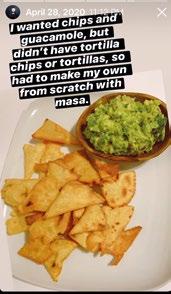

Quatre-Épices
2 tablespoons white peppercorns (you can also use black)
1/4 teaspoon freshly grated nutmeg
1/2 teaspoon (about 12) whole cloves
1/4 teaspoon ground cinnamon
1/4 teaspoon ground ginger
A few pieces of allspice Grind
It’s often said, with some justification, that Shrimp DeJonghe is an original Chicago dish. People often worry about misspelling the name. They should. It ought to be Shrimps DeJonghe as you can see in a 1912 menu from the DeJonghe Hotel and Restaurant. It should be noted the use of the plural shrimps was common on menus from this era. It seems the famous restaurant would DeJonghe almost anything. Why do we never see Lobster DeJonghe or Eggs DeJonghe these days?

Have you ever wondered what Lionel Messi tastes like?



For $12.25 at Doña Torta Chilanga, you can find out.

According to the sandwich artists at the popular Pilsen and Gage Park torta specialists, the Barcelona captain (and registered trademark) tastes strongly of chipotle salsa, with hints of headcheese, pineapple, and hot dog. If that’s not your cup of tea, the menu’s tortas futboleras section lists other equally insane sandwiches named after lesser soccer stars as well as teams. Not a sports fan? The tortas rockeras, inspired by Mexican rock bands, might be for you. And most definitely don’t ignore the super tortas chingonas!
The industrial pre-fab gyros log, a greasy fixture of fast food joints everywhere, was popularized by Chicago’s Kronos Foods (and others) in the 1970s. It’s usually referred to as a gyros cone but today’s descendants of the fathers of geometry should be more precise in their terminology: the solid figure created by truncating a cone with a plane parallel to its base is properly called a FRUSTUM
 By Jen Delos Reyes
By Jen Delos Reyes
One of the most terrifying symptoms of Covid-19 is the loss of taste and smell. Many recover these senses, but some long haulers have yet to. The fear of not being able to experience a life of culinary delights has outweighed my deep fear of dying alone. In isolation, I long to sit across from a date at a two-top.
Communing with friends, family, and lovers over food is the simple daily ritual I miss the most in the time of Coronavirus. I crave a dinner party. I first tried to satiate this desire through a weekly online cookbook club where the seven of us made the same dish and ate it together on Zoom. This activity that I concocted ended up making me feel more alone, as everyone else was partnered or with their family when we shared our meal together.
The majority of recipes serve two to four, mirroring the expected domestic configurations of a partner and children. To avoid this reality, a single person would have to convert fractions to rescale the recipe or acquire a specialty cookbook with recipes “for one.” Instead of making this depressing pivot, I continued to cook the things I love in the scales they were intended. I made Montréal-style bagels by the dozen, pans of lasagna, cauldrons of stock. While I couldn’t share these delights gathered around a table, I prepared to-go meals for friends and neighbors and continued to nourish my relationships through food while apart.
Time has become an endless blur; while confined to our homes many of the previous markers of our schedules and days have evaporated. But when there is a holiday or life milestone, our sense of time re-enters in high relief, like a memory triggered by scent, amplified by the foods we associate with those moments in time. Holiday birds, pies of the season, the unending ways we remember how to eat Chex Mix in overflowing bowls of party mix or dressed in peanut butter, chocolate, and powdered sugar, masquerading as “puppy chow,” blackeyed peas to bring prosperity in the New Year, life milestones sealed with a cake.
We mark the passage of time in food. 60 bagels. 24 pizzas. Two lasagnas. Five cakes. 72 jars of preserves.180 cookies.This is a sampling of the output from my kitchen during the pandemic. I joked with a friend that I now tell time in pizza; my weekly homemade pizza night is the only clearly demarcated day in my week. Comedy points to truth, my pizza clock is real. For some, their food clocks might be made of banana bread—fittingly banana bread was the first of the pandemic food trends, itself brought on by the rot and the effects of time. This gateway loaf made
way for the sourdough craze, a process in which time is also essential to the slow development of the starter. There is something beautiful, tender, and hopeful when I think of all of these people feeding their starters, creating an ideal environment for it to thrive. This drive for so many to take on a baking process rooted in care subconsciously helps to supplant our need for relationships that has been so drastically altered by isolation.
There is a special kind of independence that can only come from making your own ketchup.I acquired new kitchen skills as a result of the pandemic. I have made my own yogurt, tortilla chips, marmalade, kimchi, pasta, and cheese. Things that in the past would have been easier to go to the grocery store for became simpler to attempt to make, rather than brave a trip through the potential perils of the market. I have experienced a kind of food sovereignty, and while this small victory tastes sweet, nothing compares to the flavor of food shared with loved ones.
The one year anniversary of the first reported case of Covid-19 in the US was January 21, 2021. That date was also the inauguration of President Biden and Vice President Harris, the beginning of a new era, and the official start of the second year of the pandemic. I have made 36 more cookies since the time I began writing this piece. I do not know how many more pizzas I will eat alone before the pandemic is over, how what new skills I will learn in the kitchen, or if I will need to purchase a cake shield to place over my 40th birthday cake this year. What I do know is that there are many risks I am willing to take for love, but dating during the pandemic is not one of them.


